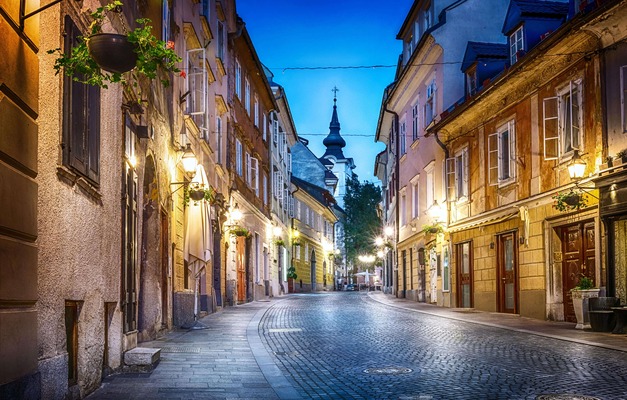
3-Week Culinary & Cultural Journey Through Italy
 21 Day Tour of Venice, Florence, Rome, Cinque Terre and Milan
21 Day Tour of Venice, Florence, Rome, Cinque Terre and Milan
Overview
Trip Map
Itinerary
Inclusions
Reviews







21 Days 20 Nights
Best Time: Jan-Dec
Local Cuisine & Wine
Cultural Exploration
Take a captivating 3-week journey through Italy, starting from Venice and exploring the country's rich culinary and cultural heritage. Travel by train and discover the beauty of Lake Como, the hilltop towns of Tuscany, and the historical splendor of Rome, Florence, and Milan. You'll also explore the scenic coastal villages of the Cinque Terre, take Venetian & Tuscan cooking class, and savor the finest Italian wines. From Venice's enchanting canals to Milan's bustling streets, this itinerary promises unforgettable adventures and gourmet delights. Go Real Travel's mobile app provides detailed travel guidance, ensuring a seamless trip.
- Wander over the stunning Grand Canal on the Rialto Bridge and take a cooking class in Venice.
- In Florence see the Church of Santa Croce, where Michelangelo lies, & learn to cook Tuscan style.
- Savor a Tuscan winery lunch and explore the medieval town of San Gimignano.
- Discover the archaeological marvels of the Colosseum Ancient Rome Forum with a private guided tour.
- Visit the picturesque coast of Cinque Terre, see the fashion capital Milan, and relax in Lake Como.
Take a captivating 3-week journey through Italy, starting from Venice and exploring the country's rich culinary and cultural heritage. Travel by train and discover the beauty of Lake Como, the hilltop towns of Tuscany, and the historical splendor of Rome, Florence, and Milan. You'll also explore the scenic coastal villages of the Cinque Terre, take Venetian & Tuscan cooking class, and savor the finest Italian wines. From Venice's enchanting canals to Milan's bustling streets, this itinerary promises unforgettable adventures and gourmet delights. Go Real Travel's mobile app provides detailed travel guidance, ensuring a seamless trip.
- Wander over the stunning Grand Canal on the Rialto Bridge and take a cooking class in Venice.
- In Florence see the Church of Santa Croce, where Michelangelo lies, & learn to cook Tuscan style.
- Savor a Tuscan winery lunch and explore the medieval town of San Gimignano.
- Discover the archaeological marvels of the Colosseum Ancient Rome Forum with a private guided tour.
- Visit the picturesque coast of Cinque Terre, see the fashion capital Milan, and relax in Lake Como.

Grand Canal
European History

Saint Mark's Basilica
Architecture

Piazza del Duomo
Churches & Monasteries

Galleria dell'Accademia
Museums & Galleries

Oltrarno & Piazzale Michelangelo
Cultural

Colosseum
Historic Landmarks

Vatican City
Churches & Monasteries

Monterosso
Beaches

Leonardo da Vinci's Last Supper
Museums & Galleries
Must see sights

Grand Canal
European History

Saint Mark's Basilica
Architecture

Piazza del Duomo
Churches & Monasteries

Galleria dell'Accademia
Museums & Galleries

Oltrarno & Piazzale Michelangelo
Cultural

Colosseum
Historic Landmarks

Vatican City
Churches & Monasteries

Monterosso
Beaches

Leonardo da Vinci's Last Supper
Museums & Galleries
Starting from
$6990
per person
 Not included
Not included Secure Your Customizable Trip
Enter your details to embark on a journey that can be tailored just for you.
Start
Travelers
Add Room
Remove Room
Preferred Hotel Stars
Craft Your Own Itinerary
Select your interests and destinations for a trip plan inspired by you.
Trip Map & Itinerary
Enable/Disable Map Scrolling
Click To Make Map Interactive

Trip Timeline
 Edit Details
Edit DetailsArrival
4 nights
Venice
Italy
Train: 2.5h
4 nights
Florence
Italy
Train: 2.5h
5 nights
Rome
Italy
Train: 4.5h
3 nights
Cinque Terre
Italy
Train: 4h
4 nights
Milan
Italy
Departure
Day-By-Day Itinerary
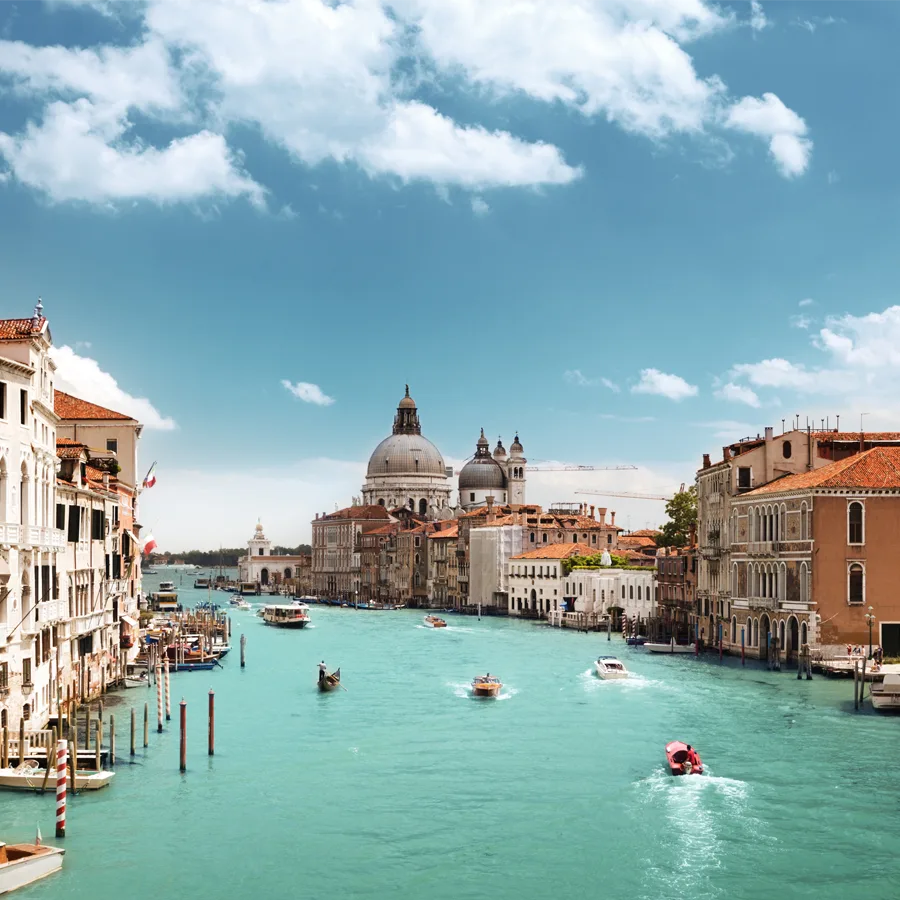
Day 1
Arrive Venice
View More
Day 1
Arrive Venice



To Be Determined
Arrival in Venice Airport and Transfer by Water Bus or Taxi
There are two main airports in Venice. You will likely arrive at the main airport of Venice Marco Polo which is located 5 miles (8km) across the water from Venice. The water bus (i.e. the "vaparetto") picks up directly at the airport and delivers you to Venice. You'll find the docks just by following the signs and you can purchase a water bus ticket at the airport for 15 EUR. You can also book a private, and very expensive, water taxi directly to your hotel, or take a land taxi to Piazzale Roma near the Venice main train station. From there you can walk or catch a water bus to your hotel. Uber is not available in Venice. If you are arriving at the more distant Treviso Airport, you will need to take a shuttle bus or an expensive taxi (100 EUR) to Venice. The ATVO bus delivers you to the Piazzale Roma on Venice in 70 minutes. The Barzi Bus Service takes you to the Tronchetto docks in 40 minutes, but from there you must take a water taxi or water bus. Both cost 12 EUR.

Day 1
Arrive Venice
View More


Day 1
Arrive Venice




To Be Determined:
Transfer from Airport
Late Afternoon:
The Grand Canal
Early Evening/Evening:
San Polo District

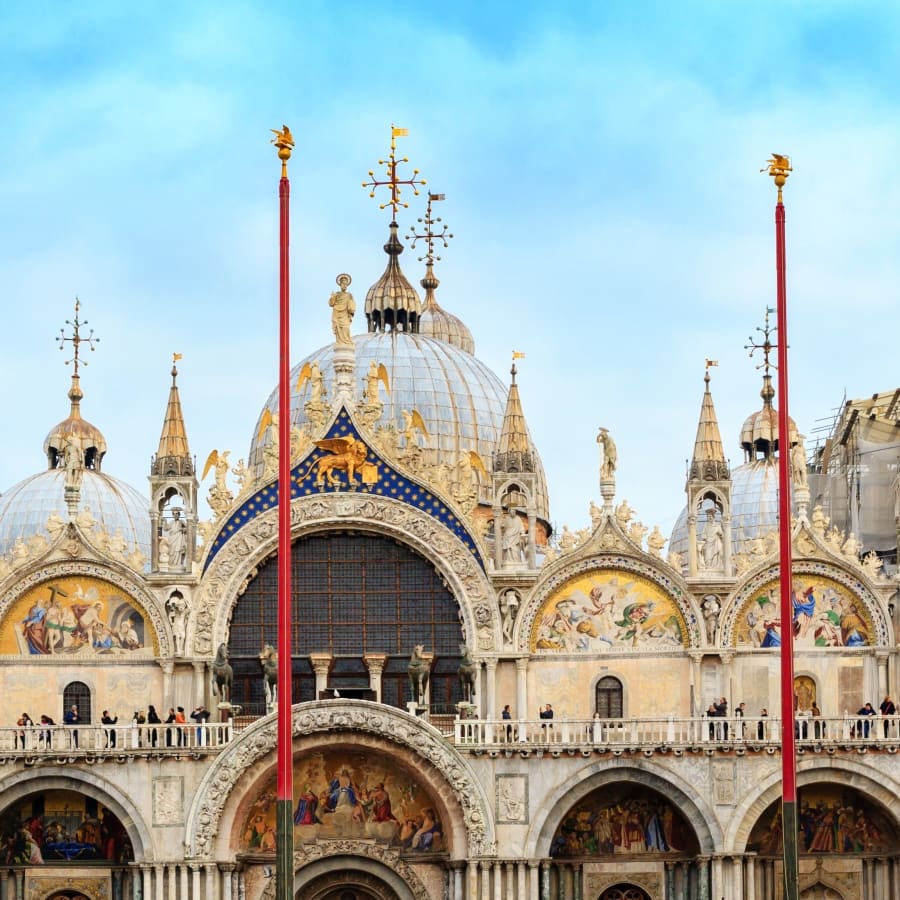
Day 2
Venice
View More
Day 2
Venice



1:15 PM - 4:15 PM
'First Walk' Guided Tour in Venice
If you are a first-time visitor to Venice, the best approach is an introductory tour. This 3-hour private guided walking excursion begins with a selection of the “must sees,” including St. Mark's Square, the former political center of the Venetian Republic, with its many famous buildings: the Doges' Palace, the Bridge of Sighs, the Marciana Library, the Bell Tower, and the Clock Tower. You'll end your tour in the Rialto neighborhood next to the famous Rialto Bridge.

Doges' Palace
Explore the staterooms and masterpieces inside this famous Gothic-style Palace.
Show More

Doges' Palace
Explore the staterooms and masterpieces inside this famous Gothic-style Palace.
Show More

Doges' Palace
Explore the staterooms and masterpieces inside this famous Gothic-style Palace.
Show More

Doges' Palace
Explore the staterooms and masterpieces inside this famous Gothic-style Palace.
Show More

Doges' Palace
Explore the staterooms and masterpieces inside this famous Gothic-style Palace.
Show More
prev
next

Day 2
Venice
View More

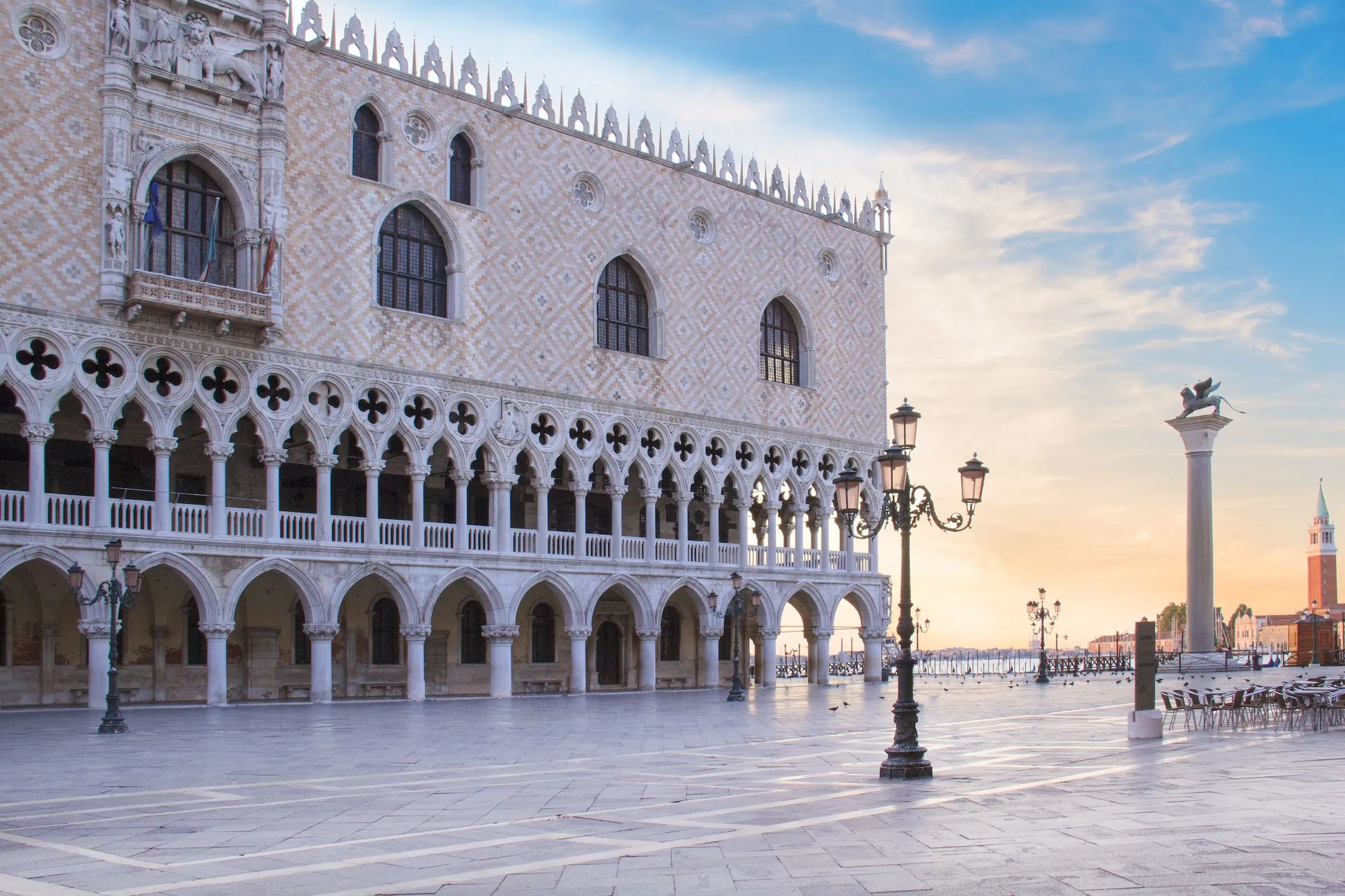
Doges' Palace
 Highlight of 'First Walk', Guided Tour in Venice
Highlight of 'First Walk', Guided Tour in VeniceExplore the staterooms and masterpieces inside this famous Gothic-style Palace.
Important Note: Entry lines can be very long. We suggest taking advantage of skip the line entry. As the name suggests, the Palace was the official residence of the Venetian rulers, the Doges, and the chief magistrates. The building was founded in the 9th century, but the present one dates from the 14th century. Tour its elaborate staterooms, grand halls and the 24-carat golden staircase before seeking out its collection of priceless masterpieces by Venetian artists including Titan, Veronese and Tintoretto. Be sure to spend some time in the most incredible room of all, the Chamber of the Great Council, the assembly hall where all Venetian patricians gathered to participate in the running of the city - up to 2,500 at any one time. There you will find the Doge's throne and the world's longest canvas painting in the world, Tintoretto's Il Paradiso.

Doges' Palace
 Highlight of 'First Walk', Guided Tour in Venice
Highlight of 'First Walk', Guided Tour in VeniceExplore the staterooms and masterpieces inside this famous Gothic-style Palace.
Important Note: Entry lines can be very long. We suggest taking advantage of skip the line entry. As the name suggests, the Palace was the official residence of the Venetian rulers, the Doges, and the chief magistrates. The building was founded in the 9th century, but the present one dates from the 14th century. Tour its elaborate staterooms, grand halls and the 24-carat golden staircase before seeking out its collection of priceless masterpieces by Venetian artists including Titan, Veronese and Tintoretto. Be sure to spend some time in the most incredible room of all, the Chamber of the Great Council, the assembly hall where all Venetian patricians gathered to participate in the running of the city - up to 2,500 at any one time. There you will find the Doge's throne and the world's longest canvas painting in the world, Tintoretto's Il Paradiso.

Doges' Palace
 Highlight of 'First Walk', Guided Tour in Venice
Highlight of 'First Walk', Guided Tour in VeniceExplore the staterooms and masterpieces inside this famous Gothic-style Palace.
Important Note: Entry lines can be very long. We suggest taking advantage of skip the line entry. As the name suggests, the Palace was the official residence of the Venetian rulers, the Doges, and the chief magistrates. The building was founded in the 9th century, but the present one dates from the 14th century. Tour its elaborate staterooms, grand halls and the 24-carat golden staircase before seeking out its collection of priceless masterpieces by Venetian artists including Titan, Veronese and Tintoretto. Be sure to spend some time in the most incredible room of all, the Chamber of the Great Council, the assembly hall where all Venetian patricians gathered to participate in the running of the city - up to 2,500 at any one time. There you will find the Doge's throne and the world's longest canvas painting in the world, Tintoretto's Il Paradiso.

Doges' Palace
 Highlight of 'First Walk', Guided Tour in Venice
Highlight of 'First Walk', Guided Tour in VeniceExplore the staterooms and masterpieces inside this famous Gothic-style Palace.
Important Note: Entry lines can be very long. We suggest taking advantage of skip the line entry. As the name suggests, the Palace was the official residence of the Venetian rulers, the Doges, and the chief magistrates. The building was founded in the 9th century, but the present one dates from the 14th century. Tour its elaborate staterooms, grand halls and the 24-carat golden staircase before seeking out its collection of priceless masterpieces by Venetian artists including Titan, Veronese and Tintoretto. Be sure to spend some time in the most incredible room of all, the Chamber of the Great Council, the assembly hall where all Venetian patricians gathered to participate in the running of the city - up to 2,500 at any one time. There you will find the Doge's throne and the world's longest canvas painting in the world, Tintoretto's Il Paradiso.

Doges' Palace
 Highlight of 'First Walk', Guided Tour in Venice
Highlight of 'First Walk', Guided Tour in VeniceExplore the staterooms and masterpieces inside this famous Gothic-style Palace.
Important Note: Entry lines can be very long. We suggest taking advantage of skip the line entry. As the name suggests, the Palace was the official residence of the Venetian rulers, the Doges, and the chief magistrates. The building was founded in the 9th century, but the present one dates from the 14th century. Tour its elaborate staterooms, grand halls and the 24-carat golden staircase before seeking out its collection of priceless masterpieces by Venetian artists including Titan, Veronese and Tintoretto. Be sure to spend some time in the most incredible room of all, the Chamber of the Great Council, the assembly hall where all Venetian patricians gathered to participate in the running of the city - up to 2,500 at any one time. There you will find the Doge's throne and the world's longest canvas painting in the world, Tintoretto's Il Paradiso.
prev
next

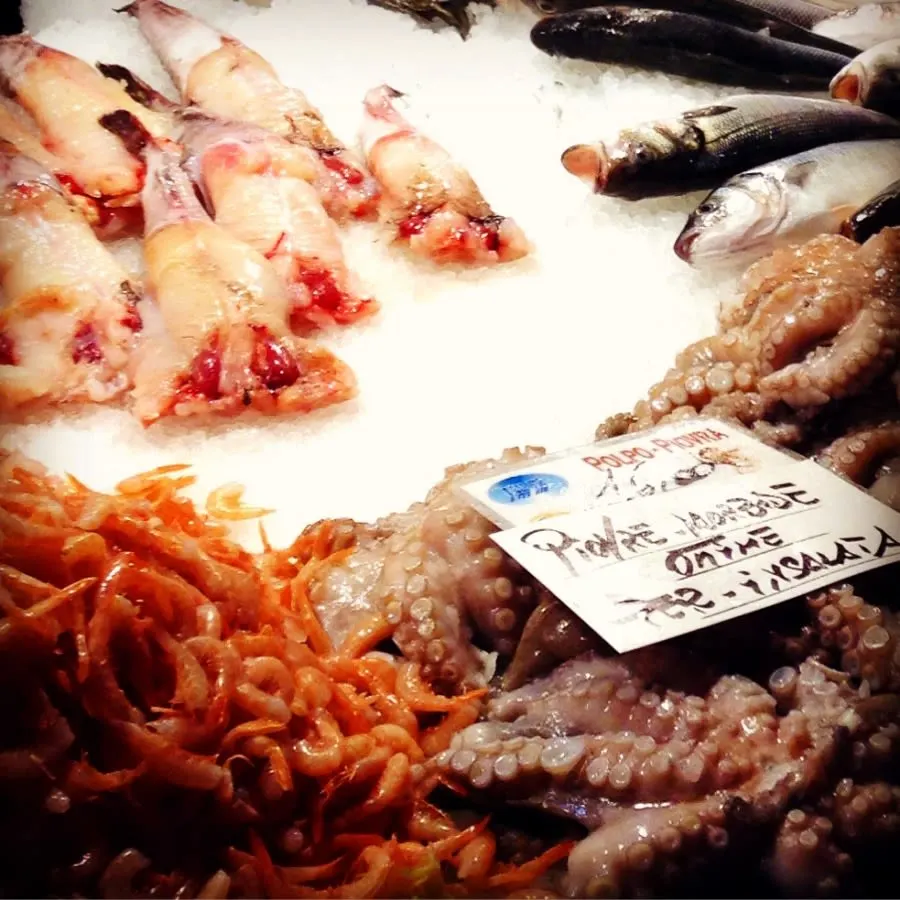
Day 3
Venice
View More
Day 3
Venice



10:00 AM - 2:00 PM
Venice For Foodies: Cooking Class or Culinary Tour
Make your stay in Venice memorable, and indulge in delicious Venetian food and fruity Veneto wines! The goal of this four-hour guided tour is to provide a first-hand culinary experience and show you all the different processes used for several dishes, all under the supervision of a food expert who will be pleased to impart their knowledge to you in the comfort of a private home.

Day 3
Venice
View More


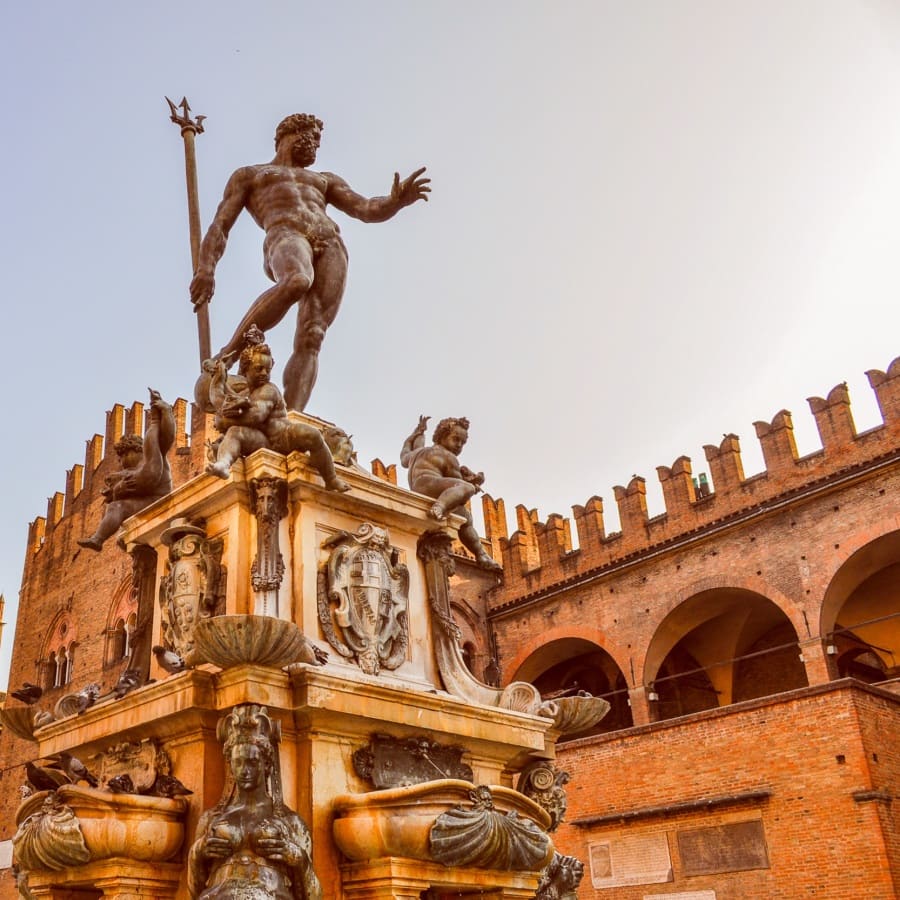
Day 4
Venice
View More
Day 4
Venice

Morning to Late Afternoon
Day Trip to Bologna
Located only a short train ride away, this off-the-tourist-radar city is one of Italy's best surprises. Apart from being the source of the inexpensive deli meat and the spaghetti dish, Bologna is probably best known as the home of the oldest university in the world. Its historic center contains two medieval towers that lean similarly to the tower in Pisa, one of which is still accessible and provides amazing views of the city. The main basilica, old town hall and other structures around the old town are equally awe-inspiring. The city is also rightly famous for its over 25 miles (40km) of covered walkways, which serve as the open-air salons of the city. That includes the longest portico in the world. At nearly 4 kilometers (2.5m) in length and with 666 arches, the Portico di San Luca leads up to the Sanctuary of the Madonna of San Luca, where you can enjoy another great view of the city, as well as of the surrounding countryside.

Archiginnasio of Bologna
Visit one of the oldest university buildings in the world and admire its incredible library.
Show More

Towers of Bologna
Climb to the top of the Asinelli Tower for great vistas over the city of Bologna below.
Show More

Neptune Fountain
Admire this monumental restored marble & bronze fountain in the heart of Piazza del Nettuno.
Show More

Archiginnasio of Bologna
Visit one of the oldest university buildings in the world and admire its incredible library.
Show More

Towers of Bologna
Climb to the top of the Asinelli Tower for great vistas over the city of Bologna below.
Show More

Neptune Fountain
Admire this monumental restored marble & bronze fountain in the heart of Piazza del Nettuno.
Show More

Archiginnasio of Bologna
Visit one of the oldest university buildings in the world and admire its incredible library.
Show More
prev
next

Day 4
Venice
View More

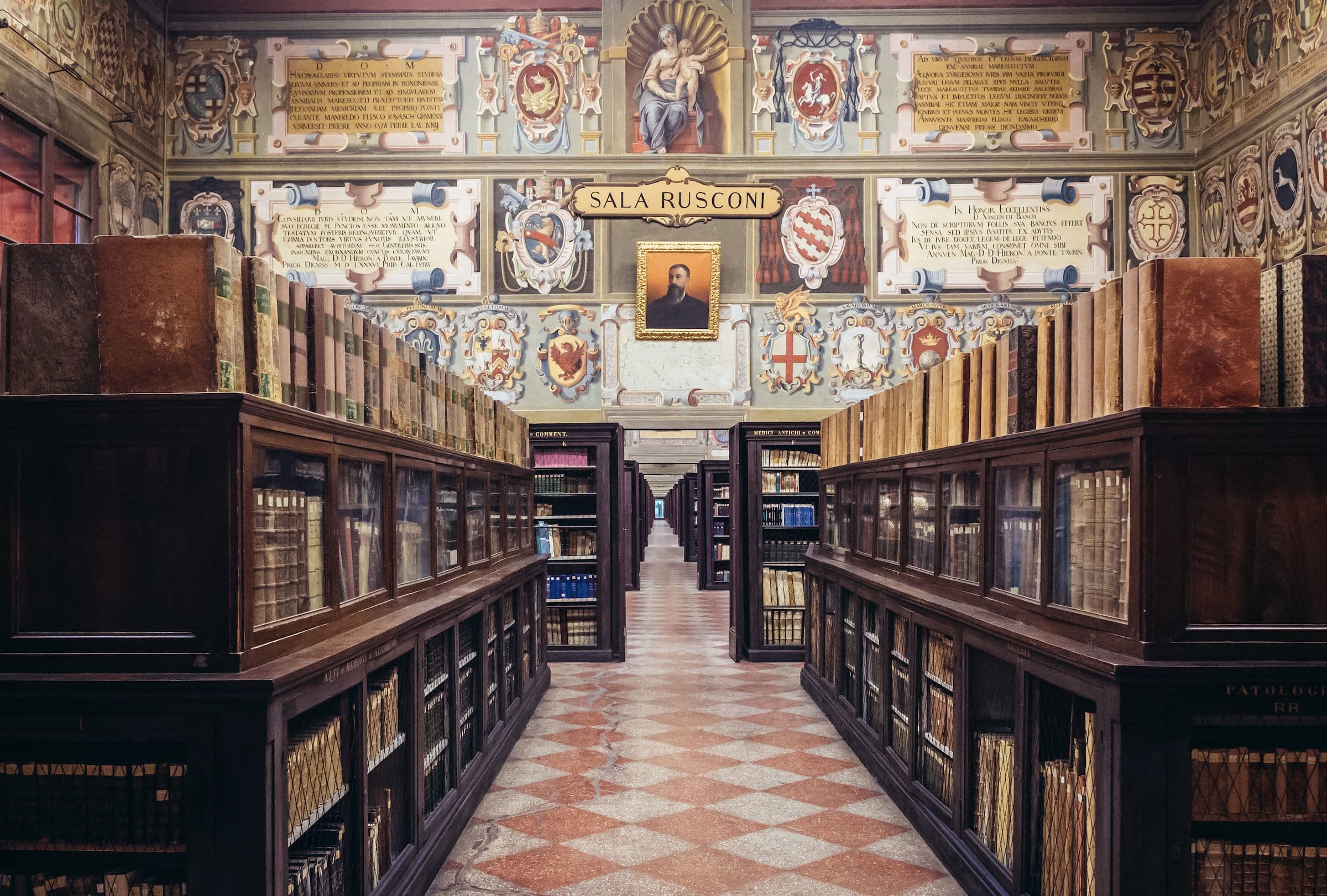
Archiginnasio of Bologna
 Highlight of Bologna
Highlight of BolognaVisit one of the oldest university buildings in the world and admire its incredible library.
Bologna's University is amongst one of the oldest in the world. The Archiginnasio (Greek for “first school”), was built in 1563 and was once the ancient seat of the University of Bologna, established as a school of Law and Arts. It houses one of the most incredible libraries in Italy, containing over one million pieces. Its anatomical theatre is by far the highlight, a place where corpses were dissected for the first scientific studies of the human body.
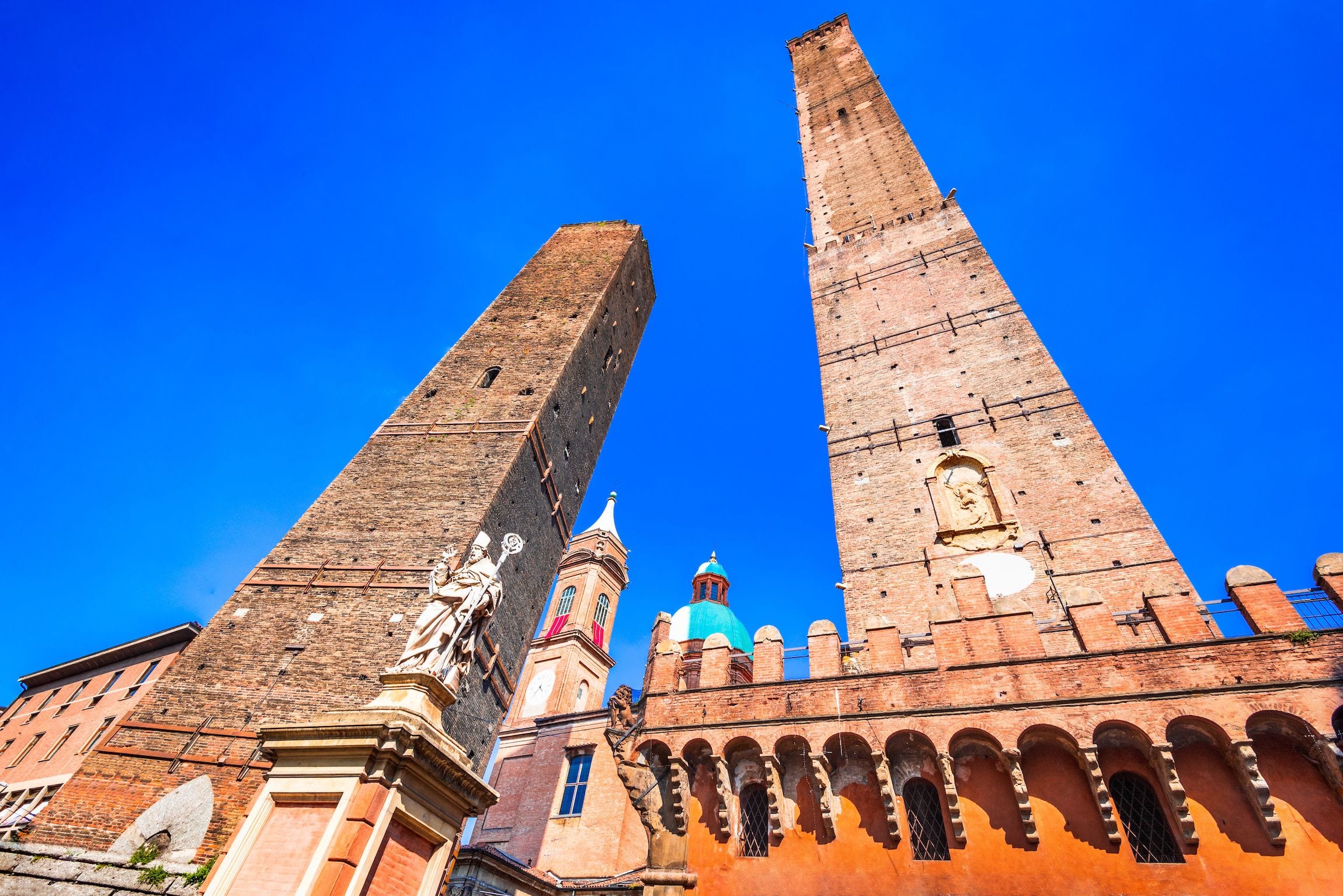
Towers of Bologna
 Highlight of Bologna
Highlight of BolognaClimb to the top of the Asinelli Tower for great vistas over the city of Bologna below.
Symbols of the city and its most popular and notable landmarks, the two towers (Due Torri) are sat in the heart of the city. They were built during the Middle Ages as noble and wealthy families competed against each other for dominance over Bologna's politics, a competition that often become violent. There was once 180 towers, but these are the only two that remain. At 319 feet (97m), The Torre degli Asinelli is the tallest leaning medieval tower in the world and the only one open to the public. Ascend the 498 steps for a panoramic view of the city.
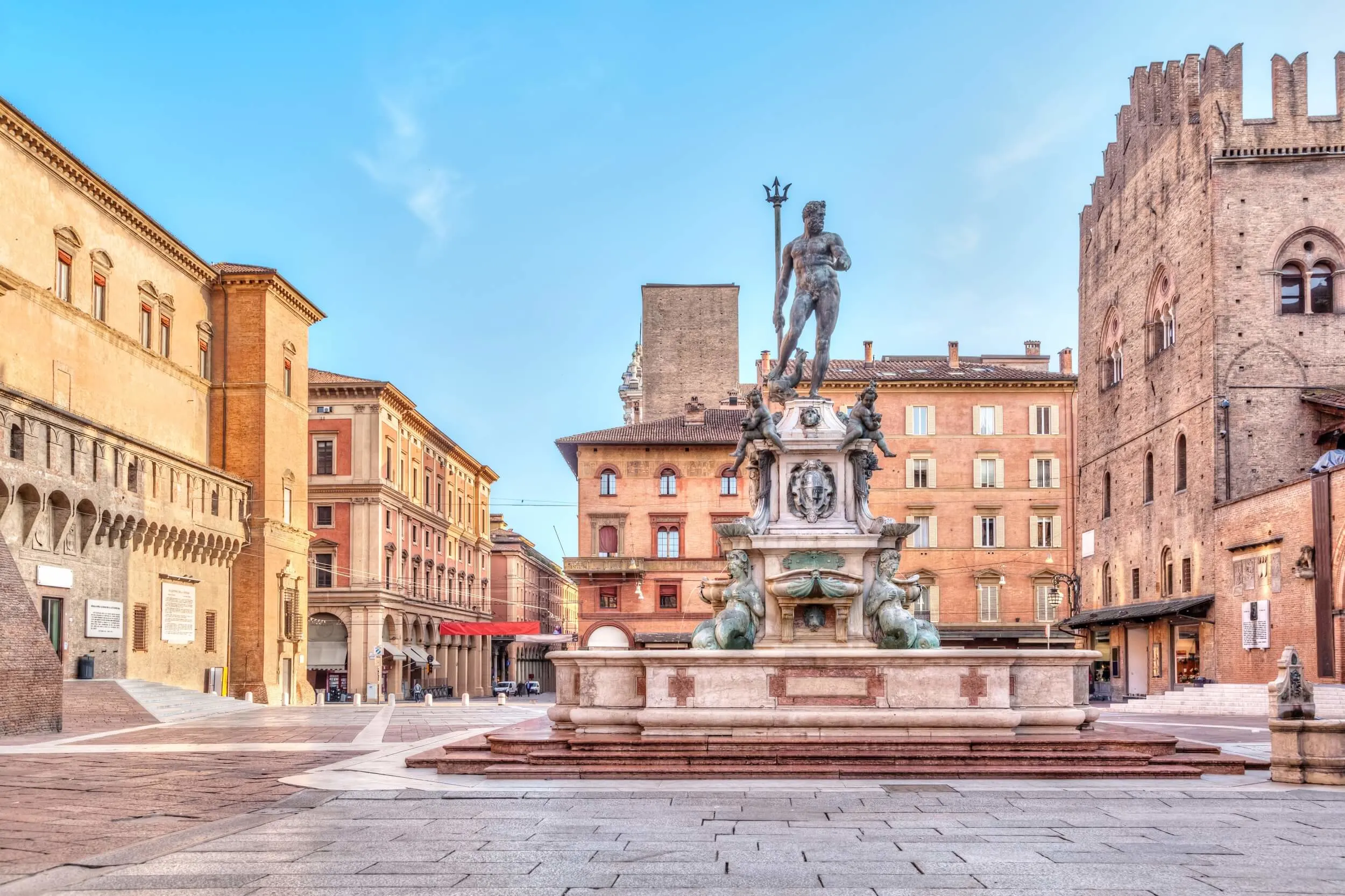
Neptune Fountain
 Highlight of Bologna
Highlight of BolognaAdmire this monumental restored marble & bronze fountain in the heart of Piazza del Nettuno.
Commissioned by Pope Pius IV, the Fountain of Neptune is one of Bologna's most famous landmarks and a popular meeting point. He was originally destined for the larger Piazza Maggiore but instead, he sits proudly on the Piazza del Nettuno as a symbol of the city. Standing at almost thirteen feet (4m) high and weighing in at nearly 5000 lbs (2,200 kg), the fountain is hard to miss.

Archiginnasio of Bologna
 Highlight of Bologna
Highlight of BolognaVisit one of the oldest university buildings in the world and admire its incredible library.
Bologna's University is amongst one of the oldest in the world. The Archiginnasio (Greek for “first school”), was built in 1563 and was once the ancient seat of the University of Bologna, established as a school of Law and Arts. It houses one of the most incredible libraries in Italy, containing over one million pieces. Its anatomical theatre is by far the highlight, a place where corpses were dissected for the first scientific studies of the human body.

Towers of Bologna
 Highlight of Bologna
Highlight of BolognaClimb to the top of the Asinelli Tower for great vistas over the city of Bologna below.
Symbols of the city and its most popular and notable landmarks, the two towers (Due Torri) are sat in the heart of the city. They were built during the Middle Ages as noble and wealthy families competed against each other for dominance over Bologna's politics, a competition that often become violent. There was once 180 towers, but these are the only two that remain. At 319 feet (97m), The Torre degli Asinelli is the tallest leaning medieval tower in the world and the only one open to the public. Ascend the 498 steps for a panoramic view of the city.

Neptune Fountain
 Highlight of Bologna
Highlight of BolognaAdmire this monumental restored marble & bronze fountain in the heart of Piazza del Nettuno.
Commissioned by Pope Pius IV, the Fountain of Neptune is one of Bologna's most famous landmarks and a popular meeting point. He was originally destined for the larger Piazza Maggiore but instead, he sits proudly on the Piazza del Nettuno as a symbol of the city. Standing at almost thirteen feet (4m) high and weighing in at nearly 5000 lbs (2,200 kg), the fountain is hard to miss.

Archiginnasio of Bologna
 Highlight of Bologna
Highlight of BolognaVisit one of the oldest university buildings in the world and admire its incredible library.
Bologna's University is amongst one of the oldest in the world. The Archiginnasio (Greek for “first school”), was built in 1563 and was once the ancient seat of the University of Bologna, established as a school of Law and Arts. It houses one of the most incredible libraries in Italy, containing over one million pieces. Its anatomical theatre is by far the highlight, a place where corpses were dissected for the first scientific studies of the human body.
prev
next

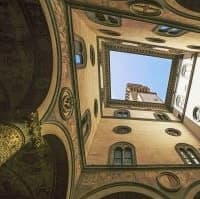
Day 5
Venice to Florence
View More
Day 5
Venice to Florence






8:55 AM
Transfer to Rail Station by Water Bus or Private Water Taxi
Because it's impossible to travel by a land taxi in Venice you will need to take a water bus (Vaporetto) from the nearest dock on the Grand Canal to Santa Lucia train station. You can use a Venezia Unica card or other travel pass, or simply buy a one-way ticket on the spot. If you do not want to take the Vaporetto, you can arrange a private transfer by water taxi or ask your hotel front desk to arrange one for you. Be sure to give your front desk some advance notice though, as it can be difficult to get a water taxi on the spot. Water taxis are expensive (about 75 EUR +), but they should be able to pick you up much closer to your place of lodging, or if your hotel has its own dock, directly from the dock.

Day 5
Venice to Florence
View More


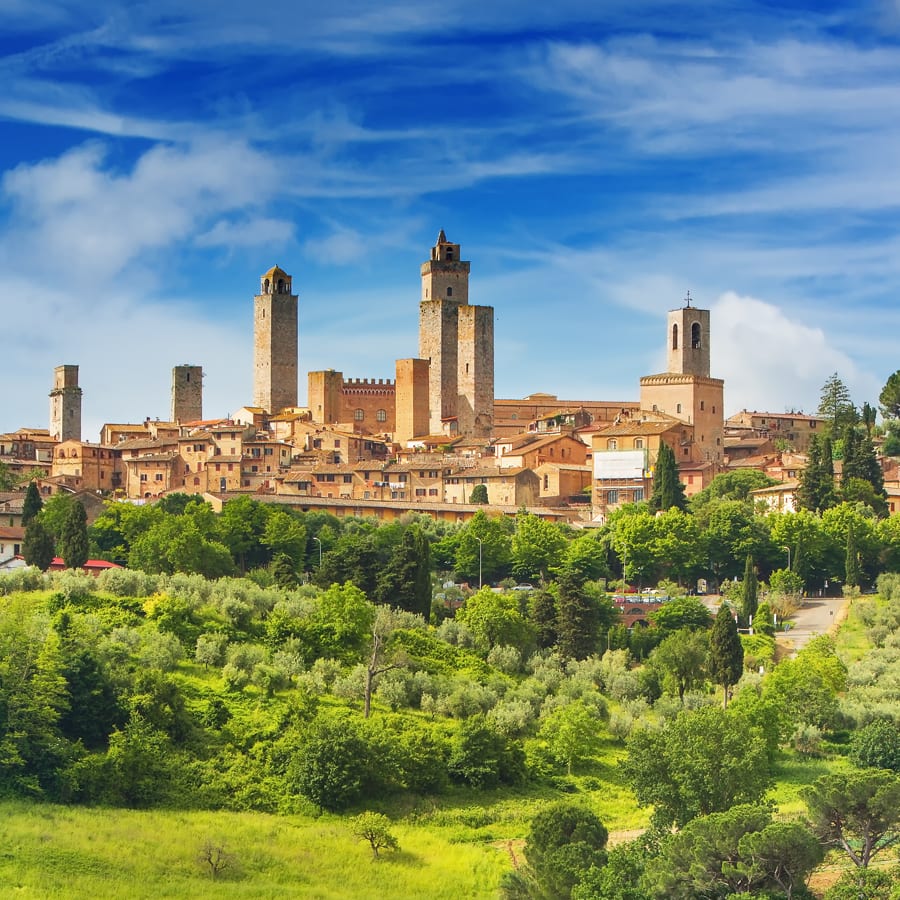
Day 6
Florence
View More
Day 6
Florence


9:00 AM - 3:00 PM
Half Day Excursion to San Gimignano and lunch stop at a local vineyard
Drive through the scenic Tuscan countryside to San Gimignano, one of the most charming and picturesque Tuscan hill towns with medieval towers built for the richest families of the time. You can choose to visit the Cathedral, climb the “Torre Grossa”, take pictures of the gorgeous landscape and enjoy a delicious gelato in the Cistern Square. After, you will be driven to a local Tuscan winery for lunch and some wine tasting. IMPORTANT NOTE : This excursion does not include a guide.

Day 6
Florence
View More


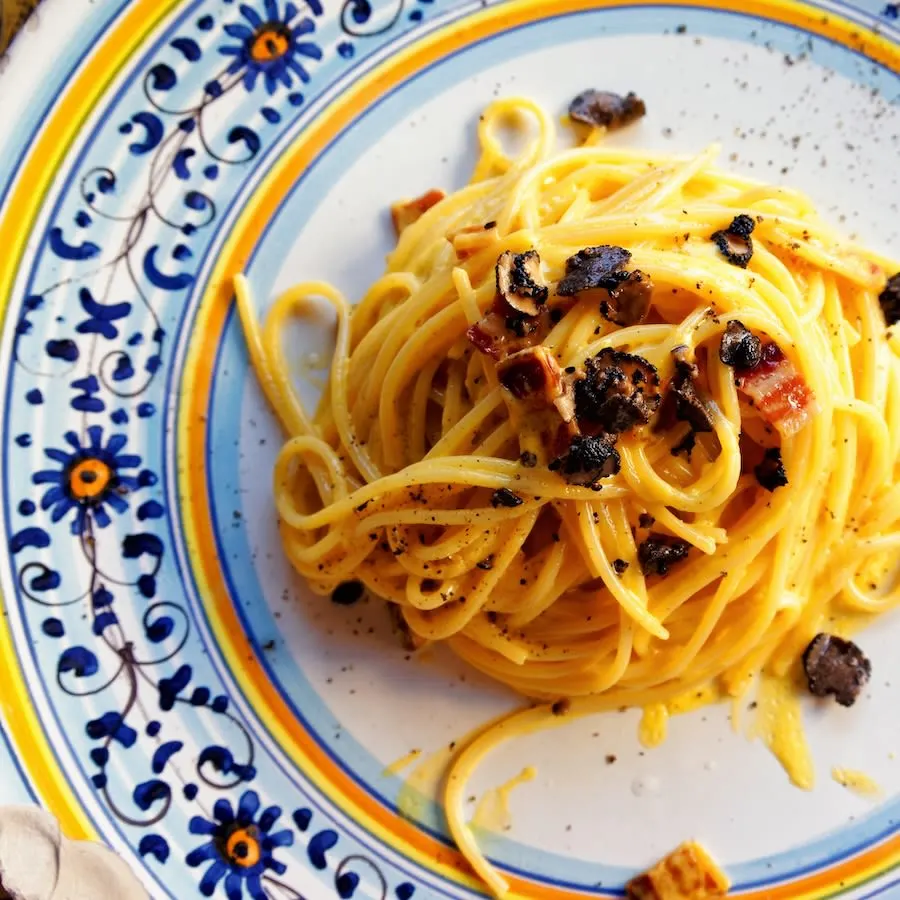
Day 7
Florence
View More
Day 7
Florence


10:00 AM - 2:00 PM
Tuscan Cuisine Cooking Class
Tuscany is blessed with the perfect climate and location for food, producing a diverse bounty of fresh fruits and vegetables, wild game, beef & pork, and seafood. In fact, when you consider the quality of ingredients produced here, you understand why Tuscan cooking is not just about recipes, but about bringing out the best of the ingredients. Even within Italy, Tuscany is renowned for its cuisine. Taking a cooking class can introduce you to the magic, teaching you how to make traditional Tuscan starters, pastas, main courses, and deserts.

Day 7
Florence
View More


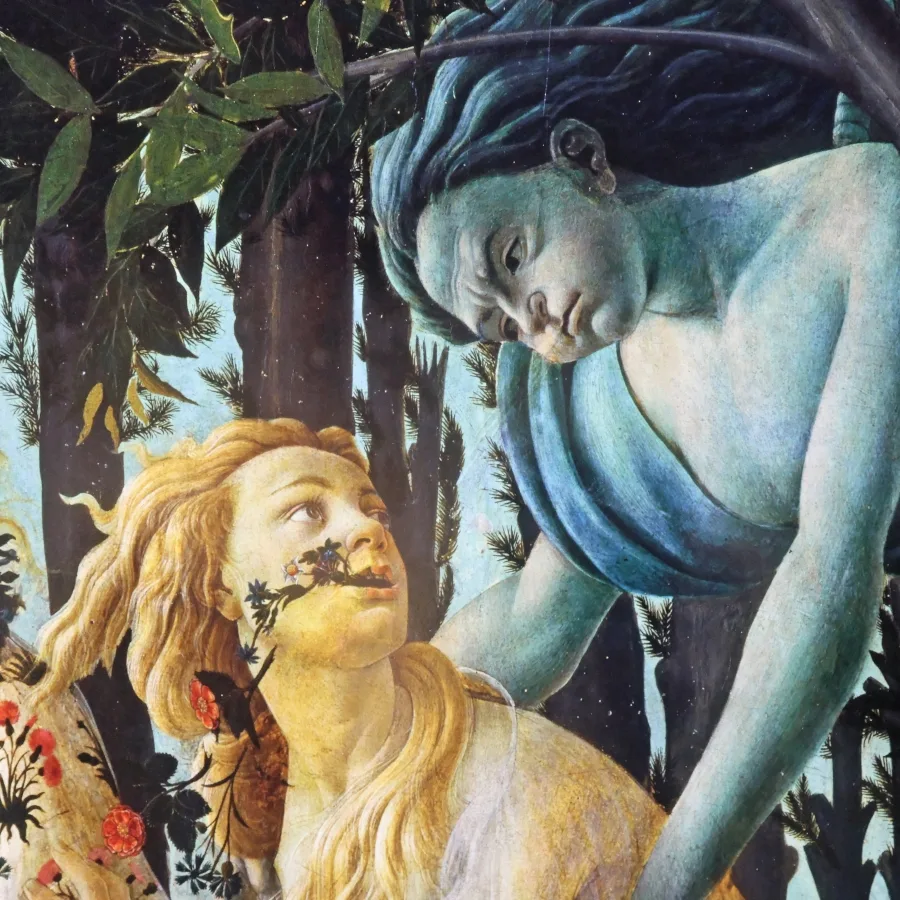
Day 8
Florence
View More
Day 8
Florence



Early Morning/Morning
Visit Italy's Greatest Display of Art at the Uffizi Gallery
As the capital of the Renaissance, it's only fitting that Florence should also host Italy's greatest art gallery at the Uffizi. It's understandably busy throughout the year, but it's nevertheless worth the crowds to see to see some of the most sumptuous masterpieces of Renaissance art, including Botticelli's Primavera and Venus, and works by Michelangelo and Da Vinci. If you're planning to visit other galleries and museums in Florence, then it's definitely worth investing in a Firenze Card, which gives you free entry and priority access to 72 venues in the city. At a minimum, you should book ahead for the Uffizi to avoid very long queues.

Day 8
Florence
View More


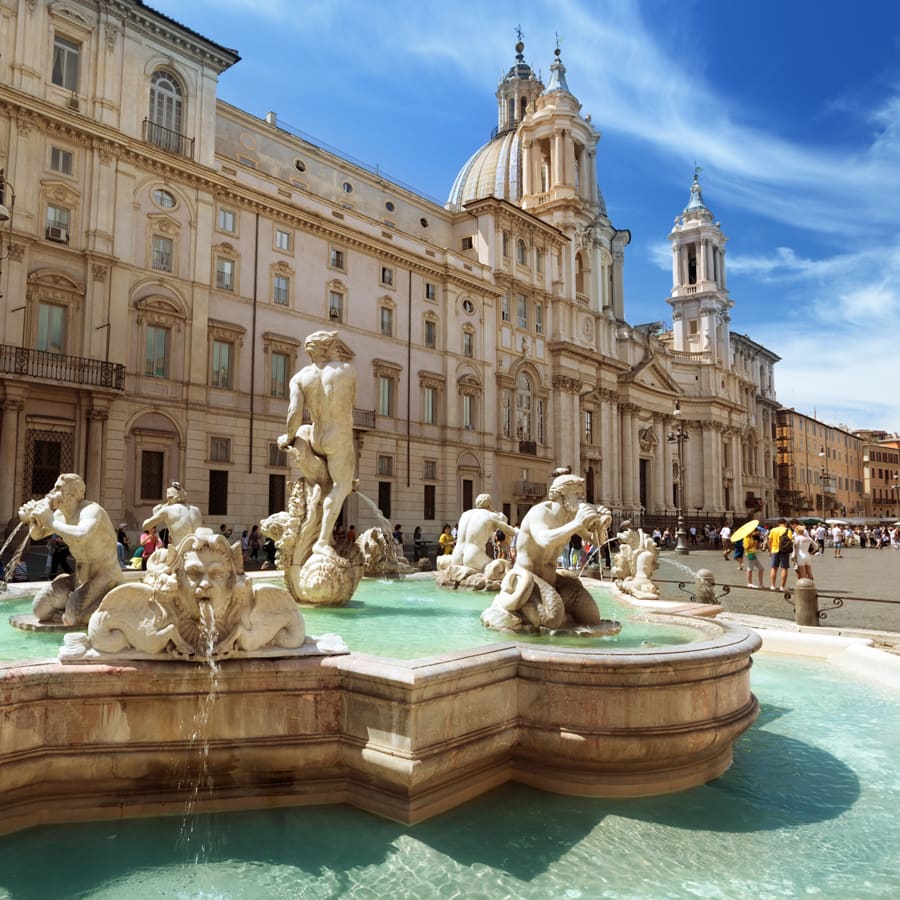
Day 9
Florence to Rome
View More
Day 9
Florence to Rome





7:35 AM
Transfer to Station by Taxi or Public Transport
Most trains depart from Firenza S.M.N. (i.e. Florence Santa Maria Novella Station) station, the largest station in the city. Before spending money on a transfer, be sure to check whether your hotel is within easy walking distance. Also consider that public transport is the cheapest and sometimes fastest option; trams and buses drop off next to the station. Uber is available in Florence, and if staying at a hotel, they can order a reliable taxi. Some private transfers will even help with your bags.

Day 9
Florence to Rome
View More



Day 10
Rome
View More
Day 10
Rome



9:30 AM - 12:30 PM
Heart of the Empire - Private Tour of Ancient Rome & the Colosseum
On this 3-hour private guided tour, you will explore the imposing remains of ancient Rome. Your guide will explain the extraordinary history of the birth of Rome, life in the city and everything about the fall of the Empire. Visit the Colosseum, the monumental ruins of the Roman Forum, and end the tour on the Capitoline Hill, the smallest and most important of the seven hills of Ancient Rome.

Colosseum
Ancient Roman Ampitheater
Show More

Colosseum
Ancient Roman Ampitheater
Show More

Colosseum
Ancient Roman Ampitheater
Show More

Colosseum
Ancient Roman Ampitheater
Show More

Colosseum
Ancient Roman Ampitheater
Show More
prev
next

Day 10
Rome
View More

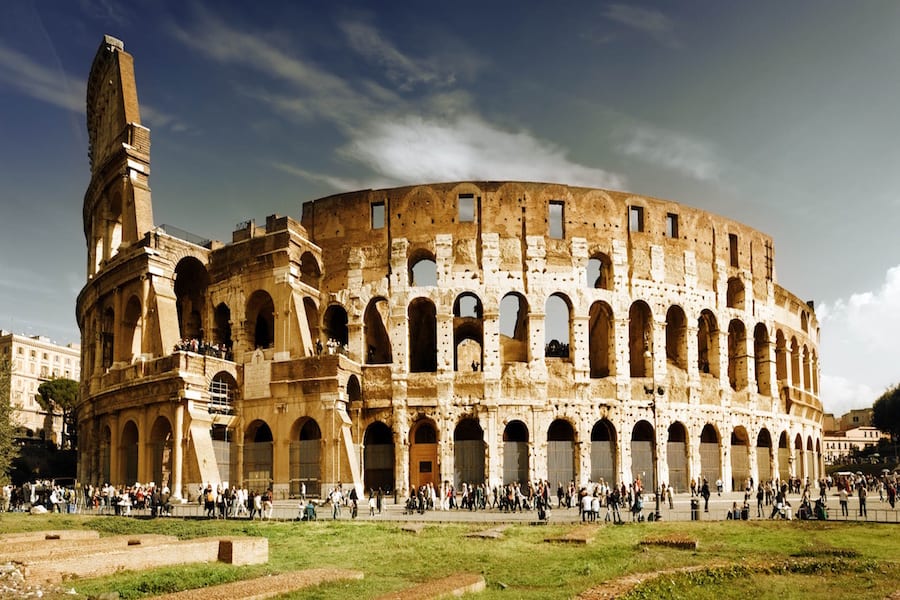
Colosseum
 Highlight of Ancient Rome Guided Walk
Highlight of Ancient Rome Guided WalkAncient Roman Ampitheater
Monumental Roman amphitheater once used for gladiatorial games

Colosseum
 Highlight of Ancient Rome Guided Walk
Highlight of Ancient Rome Guided WalkAncient Roman Ampitheater
Monumental Roman amphitheater once used for gladiatorial games

Colosseum
 Highlight of Ancient Rome Guided Walk
Highlight of Ancient Rome Guided WalkAncient Roman Ampitheater
Monumental Roman amphitheater once used for gladiatorial games

Colosseum
 Highlight of Ancient Rome Guided Walk
Highlight of Ancient Rome Guided WalkAncient Roman Ampitheater
Monumental Roman amphitheater once used for gladiatorial games

Colosseum
 Highlight of Ancient Rome Guided Walk
Highlight of Ancient Rome Guided WalkAncient Roman Ampitheater
Monumental Roman amphitheater once used for gladiatorial games
prev
next

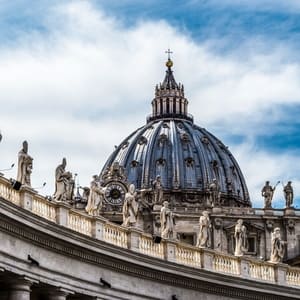
Day 11
Rome
View More
Day 11
Rome



10:00 AM - 2:00 PM
Guided Vatican Tour including the Sistine Chapel
xperience the millenary history of the Roman Catholic Church and its vast art treasures on this four-hour private guided tour of the Vatican City. Visit the Vatican Museums, Sistine Chapel before ending your tour in Saint Peter’s Basilica, the most important Catholic Church in the world, a ‘magnet’ that attracts millons of visitors and pilgrims every year. Note: Entry tickets to the Vatican Museum are non-refundable from the time of trip confirmation.

Vatican Museums
Book early if you want to see the Vatican Museum's monumental works of art from the greatest Italian artists of the Renaissance.
Show More

St Peter’s Basilica
Explore the gigantic and incredibly beautiful church known as "the greatest of all churches of Christendom".
Show More

Sistine Chapel
Gaze up at the world's most famous ceiling, the masterpiece of Michelangelo.
Show More

Vatican Museums
Book early if you want to see the Vatican Museum's monumental works of art from the greatest Italian artists of the Renaissance.
Show More

St Peter’s Basilica
Explore the gigantic and incredibly beautiful church known as "the greatest of all churches of Christendom".
Show More

Sistine Chapel
Gaze up at the world's most famous ceiling, the masterpiece of Michelangelo.
Show More

Vatican Museums
Book early if you want to see the Vatican Museum's monumental works of art from the greatest Italian artists of the Renaissance.
Show More
prev
next

Day 11
Rome
View More

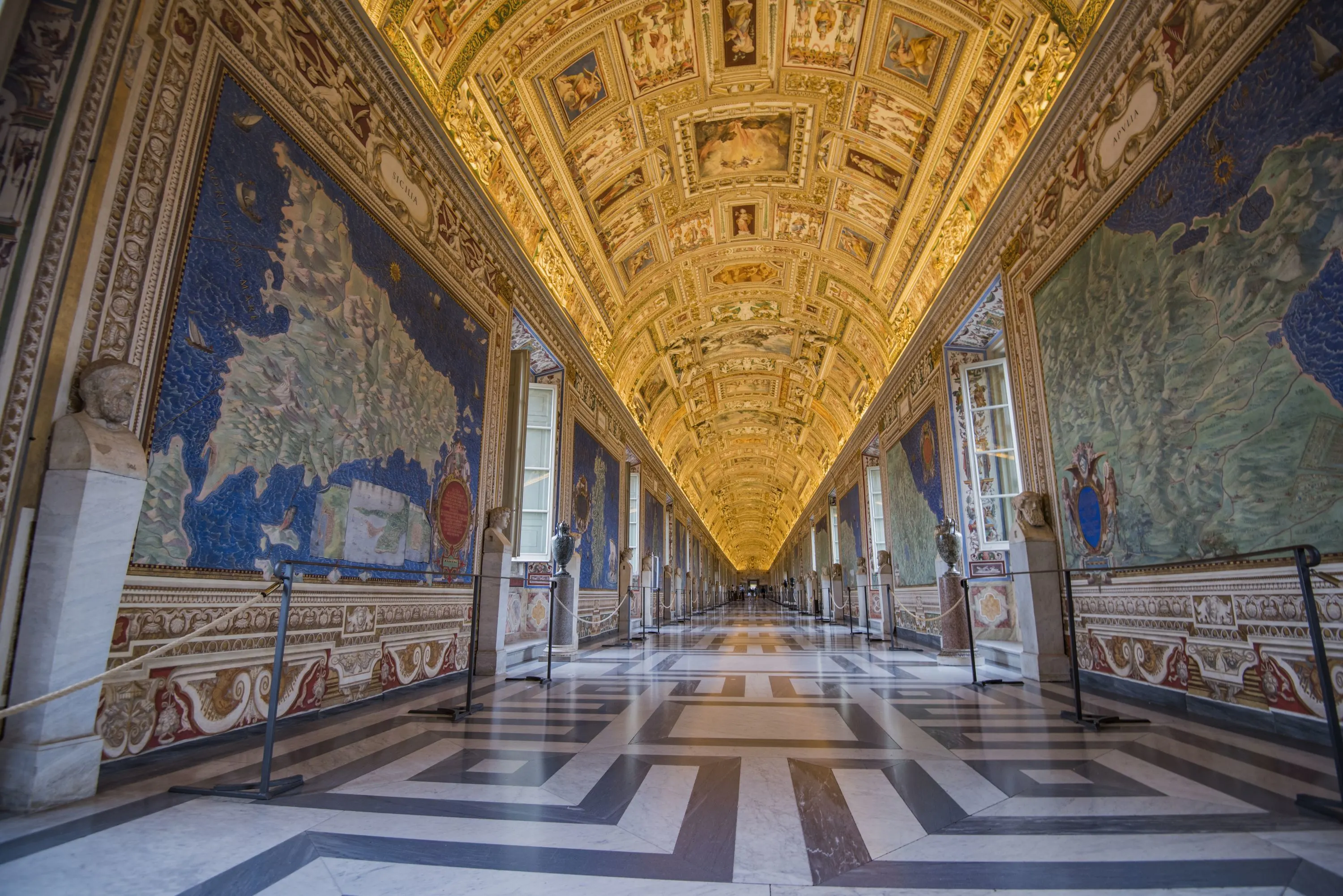
Vatican Museums
 Highlight of Vatican City, Guided
Highlight of Vatican City, GuidedBook early if you want to see the Vatican Museum's monumental works of art from the greatest Italian artists of the Renaissance.
The Vatican Museum is actually 26 different museums, which include not only exhibitions but chapels, apartments, and other rooms of the Vatican palace, covering a huge range of fine and applied arts patronized by the popes. There's also an outstanding collection of ancient antiquities (including even the Emperor Nero's red stone bathtub), a gallery of hand-painted maps, and whole rooms turned into works of art. In addition to ancient and medieval works of art, you'll see masterpieces by the "who's who" of the Italian Renaissance, including Raphael, Leonardo da Vinci, Titian, and Caravaggio. Other highlights include panels by the brilliant monk-artist Fra Angelico, works from the Venetian school, including Vavarini, and much, much more. Booking in advance is highly recommended as otherwise you can wait for hours or not even be able to get in at all.
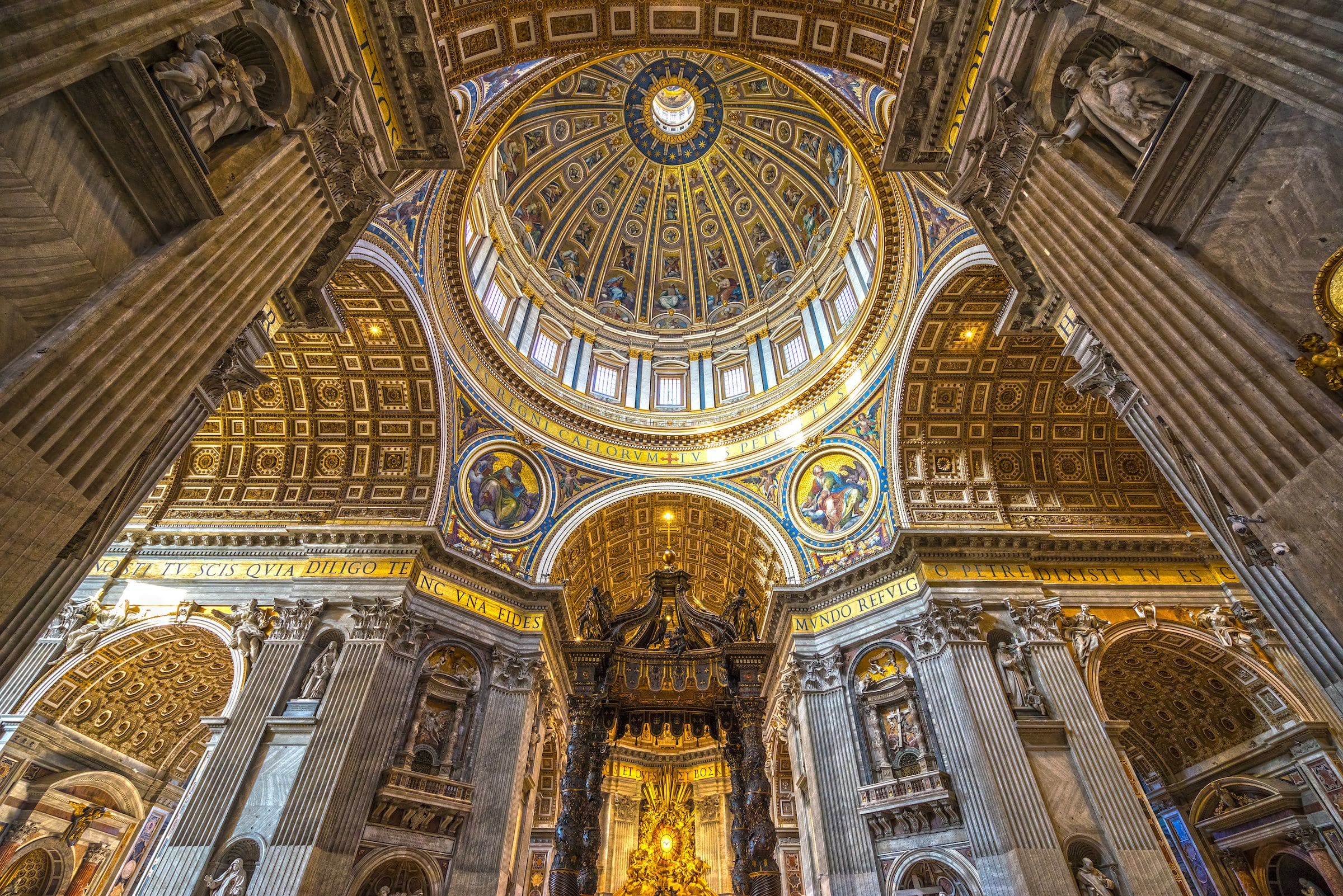
St Peter’s Basilica
 Highlight of Vatican City, Guided
Highlight of Vatican City, GuidedExplore the gigantic and incredibly beautiful church known as "the greatest of all churches of Christendom".
The basilica is one of the chief pilgrimage sites in the Christian world, and one of the most popular tourist destinations in Rome. The basilica is the symbolic center of the church not only because the Pope frequently celebrates Mass there, but because it is believed that the apostle St. Peter is buried beneath it. Catholics consider Peter as the first Bishop of Rome and "the rock" upon which the Catholic Church was built, in accordance with Christ's instructions. Inside you can admire sculptures by Bernini as well as Michelangelo's famous sculpture of the Virgin Mary holding the crucified Jesus, known as The Pietà. The church's elaborate and impressive golden interior is a sight to behold. Other sights include St Peter's tomb, the Papal crypts in the necropolis under the basilica, as well as the dome, which rewards visitors with views over Rome. Entry is free, but queues to visit the Basilica can be lengthy, so it is highly advised to either get there early or to purchase a skip the line entrance. The dome is also paid entry.
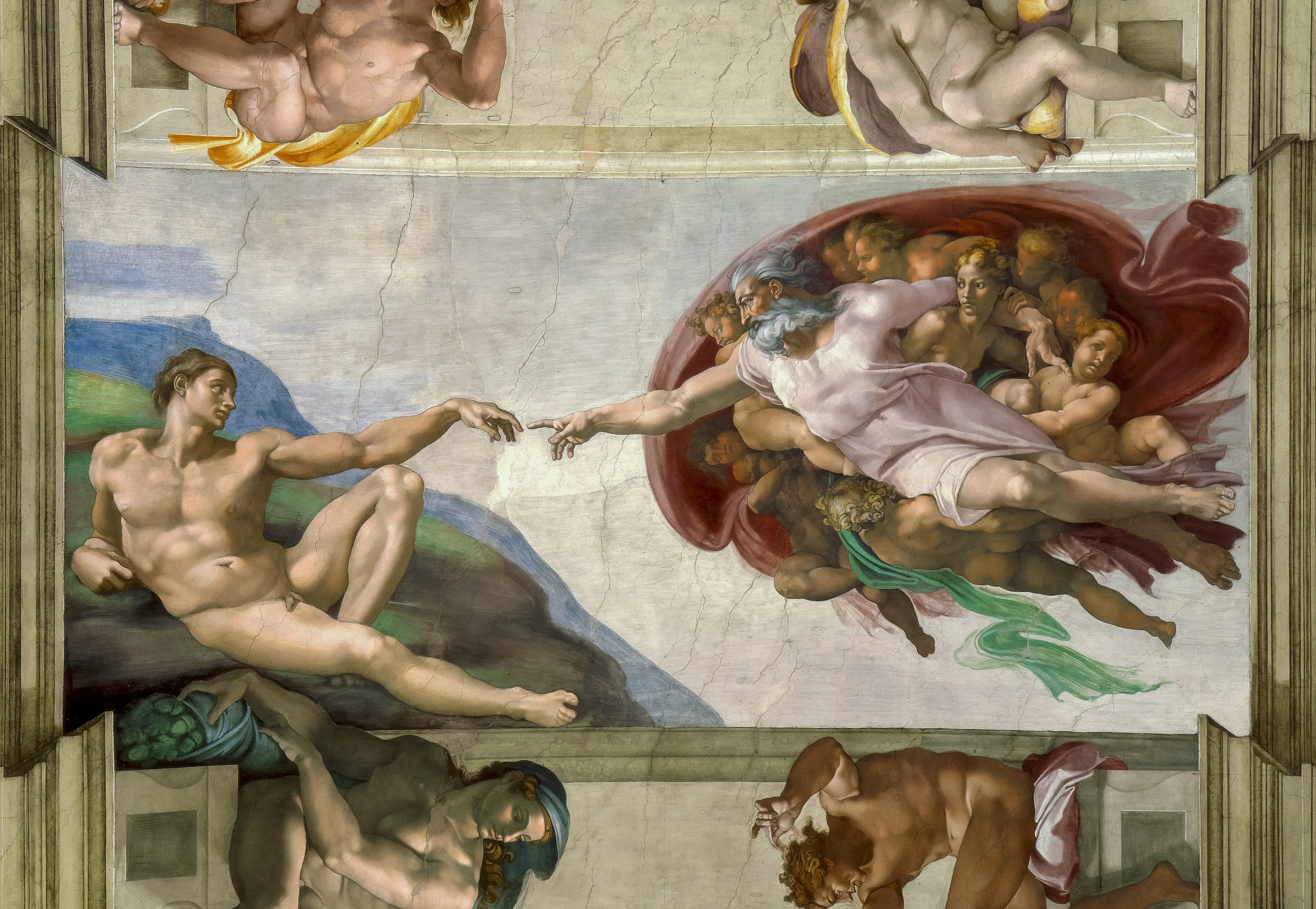
Sistine Chapel
 Highlight of Vatican City, Guided
Highlight of Vatican City, GuidedGaze up at the world's most famous ceiling, the masterpiece of Michelangelo.
This famous chapel inside the Vatican Museums is best known for Michelangelo's 16th-century painted ceiling of "The Creation of Adam" and "The Last Judgement" fresco that covers the whole altar wall of the chapel. The jaw-dropping sight is not to be missed, considered one of the top highlights of visiting the Vatican Museums and one of the top artistic wonders of the world.

Vatican Museums
 Highlight of Vatican City, Guided
Highlight of Vatican City, GuidedBook early if you want to see the Vatican Museum's monumental works of art from the greatest Italian artists of the Renaissance.
The Vatican Museum is actually 26 different museums, which include not only exhibitions but chapels, apartments, and other rooms of the Vatican palace, covering a huge range of fine and applied arts patronized by the popes. There's also an outstanding collection of ancient antiquities (including even the Emperor Nero's red stone bathtub), a gallery of hand-painted maps, and whole rooms turned into works of art. In addition to ancient and medieval works of art, you'll see masterpieces by the "who's who" of the Italian Renaissance, including Raphael, Leonardo da Vinci, Titian, and Caravaggio. Other highlights include panels by the brilliant monk-artist Fra Angelico, works from the Venetian school, including Vavarini, and much, much more. Booking in advance is highly recommended as otherwise you can wait for hours or not even be able to get in at all.

St Peter’s Basilica
 Highlight of Vatican City, Guided
Highlight of Vatican City, GuidedExplore the gigantic and incredibly beautiful church known as "the greatest of all churches of Christendom".
The basilica is one of the chief pilgrimage sites in the Christian world, and one of the most popular tourist destinations in Rome. The basilica is the symbolic center of the church not only because the Pope frequently celebrates Mass there, but because it is believed that the apostle St. Peter is buried beneath it. Catholics consider Peter as the first Bishop of Rome and "the rock" upon which the Catholic Church was built, in accordance with Christ's instructions. Inside you can admire sculptures by Bernini as well as Michelangelo's famous sculpture of the Virgin Mary holding the crucified Jesus, known as The Pietà. The church's elaborate and impressive golden interior is a sight to behold. Other sights include St Peter's tomb, the Papal crypts in the necropolis under the basilica, as well as the dome, which rewards visitors with views over Rome. Entry is free, but queues to visit the Basilica can be lengthy, so it is highly advised to either get there early or to purchase a skip the line entrance. The dome is also paid entry.

Sistine Chapel
 Highlight of Vatican City, Guided
Highlight of Vatican City, GuidedGaze up at the world's most famous ceiling, the masterpiece of Michelangelo.
This famous chapel inside the Vatican Museums is best known for Michelangelo's 16th-century painted ceiling of "The Creation of Adam" and "The Last Judgement" fresco that covers the whole altar wall of the chapel. The jaw-dropping sight is not to be missed, considered one of the top highlights of visiting the Vatican Museums and one of the top artistic wonders of the world.

Vatican Museums
 Highlight of Vatican City, Guided
Highlight of Vatican City, GuidedBook early if you want to see the Vatican Museum's monumental works of art from the greatest Italian artists of the Renaissance.
The Vatican Museum is actually 26 different museums, which include not only exhibitions but chapels, apartments, and other rooms of the Vatican palace, covering a huge range of fine and applied arts patronized by the popes. There's also an outstanding collection of ancient antiquities (including even the Emperor Nero's red stone bathtub), a gallery of hand-painted maps, and whole rooms turned into works of art. In addition to ancient and medieval works of art, you'll see masterpieces by the "who's who" of the Italian Renaissance, including Raphael, Leonardo da Vinci, Titian, and Caravaggio. Other highlights include panels by the brilliant monk-artist Fra Angelico, works from the Venetian school, including Vavarini, and much, much more. Booking in advance is highly recommended as otherwise you can wait for hours or not even be able to get in at all.
prev
next


Day 12
Rome
View More
Day 12
Rome



Morning/Mid-Day
Visit Rome's Esquilino District
Upon first glance, this urban neighborhood of Rome may seem busy and overwhelming, but hidden among its traffic-noisy streets are some of Rome's most beautiful churches, artistic treasures, and cultural museums, including the Baths of Diocletian.

Basilica of Santa Maria degli Angeli
See a Michelangelo-designed church built within the former Baths of Diocletian.
Show More

Palazzo Massimo alle Terme
Visit one of Rome's greatest but most unheralded museums of antiquity.
Show More

Baths of Diocletian
Walk the ruins of what was once the largest themal baths in the ancient Roman world.
Show More

Basilica of Santa Maria degli Angeli
See a Michelangelo-designed church built within the former Baths of Diocletian.
Show More

Palazzo Massimo alle Terme
Visit one of Rome's greatest but most unheralded museums of antiquity.
Show More

Baths of Diocletian
Walk the ruins of what was once the largest themal baths in the ancient Roman world.
Show More

Basilica of Santa Maria degli Angeli
See a Michelangelo-designed church built within the former Baths of Diocletian.
Show More
prev
next

Day 12
Rome
View More

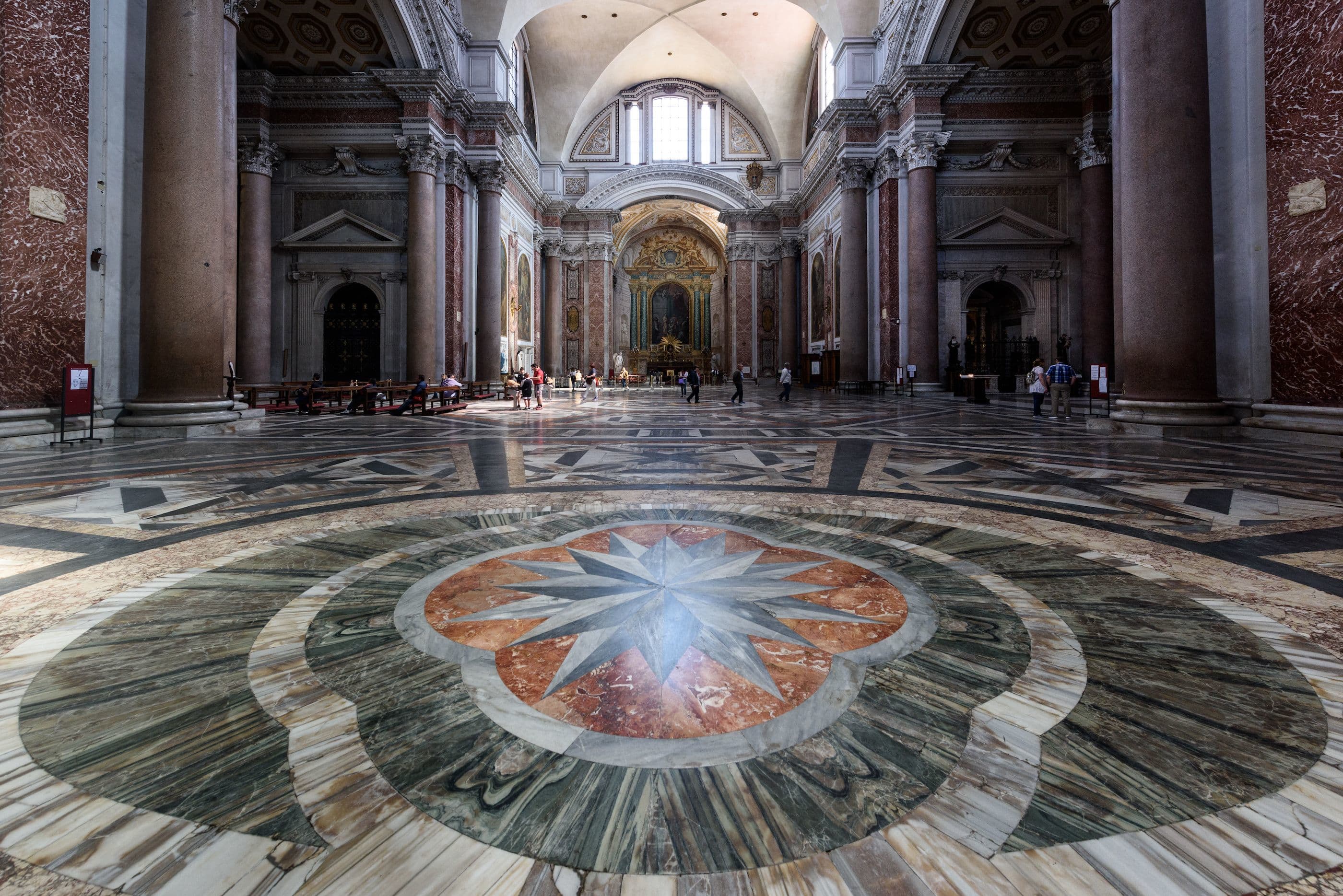
Basilica of Santa Maria degli Angeli
 Highlight of Esquilino District
Highlight of Esquilino DistrictSee a Michelangelo-designed church built within the former Baths of Diocletian.
In 1561, almost 1000 years after the baths of Diocletian fell into disuse, Pope Pius IV decided to build a basilica consecrated to Our Lady of the Angels within the baths. He commisioned the 86-year-old Michelangelo to plan the church, making use of some of the existing structures of the baths. Today a visit to the basilica gives you an idea of the enormous size of the baths. The church was constructed at the site of the former frigidarium (a large cold pool which would be used to close the pores after using the hot baths) and incorporates several elements of the former thermae. The vestibule occupies the former tepidarium (a Roman-style relaxation room) and the imposing entrance is an exedra of the caldarium (a room with a hot plunge bath). Other highlights include the meridian solar line running across the floor, which still accurately calculates the length of the year and the summer and winter solstices. There is also an impressive organ with 5,400 tubes. It is capable of leaving those visitors lucky enough to hear it spellbound.
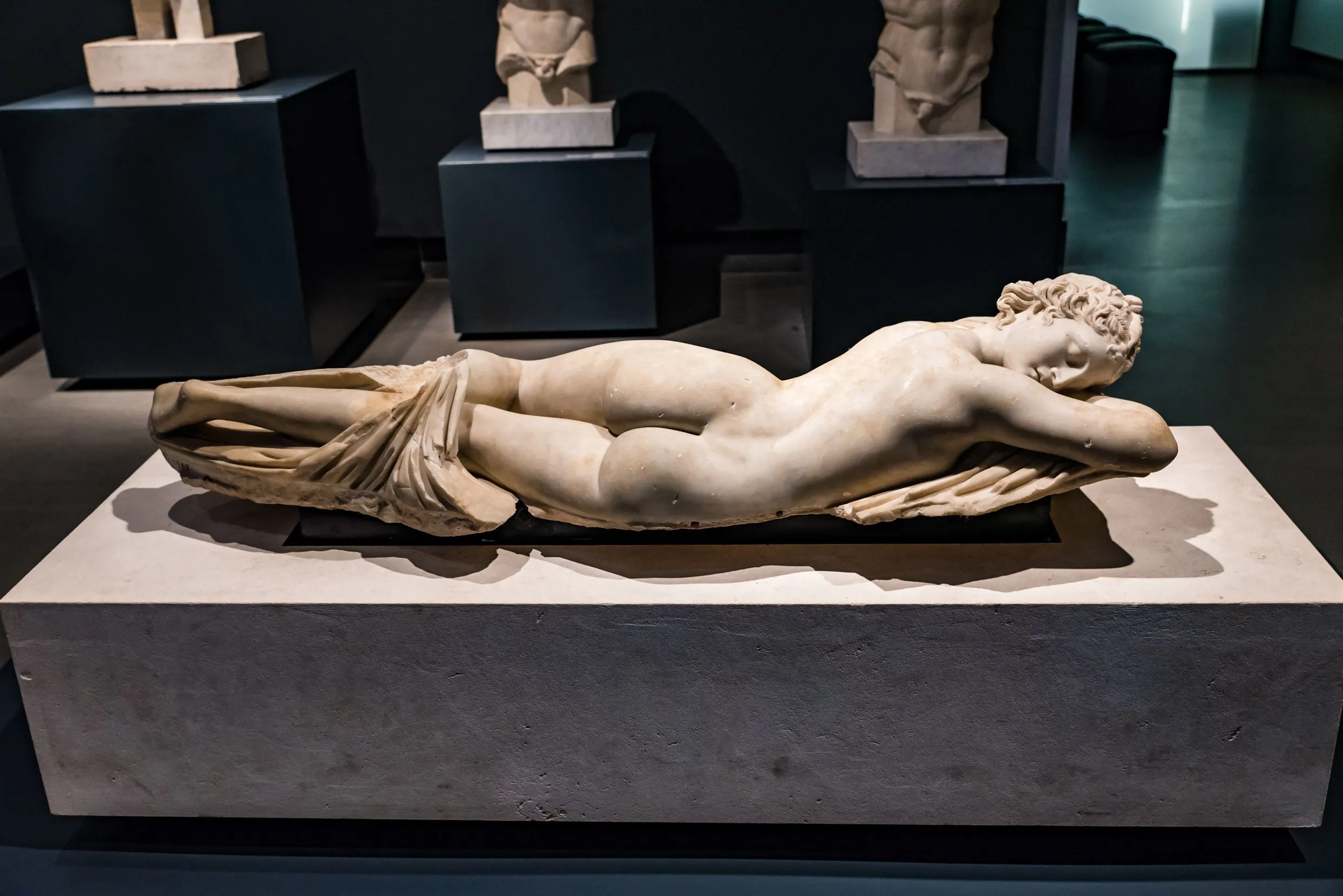
Palazzo Massimo alle Terme
 Highlight of Esquilino District
Highlight of Esquilino DistrictVisit one of Rome's greatest but most unheralded museums of antiquity.
This light-filled museum holds one of the best classical art collections in the world. The ground and first-floor feature famous Greek and Roman sculptures, mosaics and statues, as well as impressive sarcophagi and high reliefs. The second floor showcases the best preserved Roman frescoes in the world, which are considered the highlight of the museum. Originally located in Villa of Livia (the wife of Augustus) and Villa Farnesina, these colourful frescoes, sometimes covering an entire room, offer a unique view into life in ancient Rome and the critical importance of gardens, nature, and the villa atmosphere to upper echelon Romans. A must visit room is the painted garden room of Villa Livia. There is also a cinema room with a video showing a 3D reconstruction of the Villa Farnesina as it would have been, showing the layout of the rooms in the villa and the frescoes you had seen just moments before.
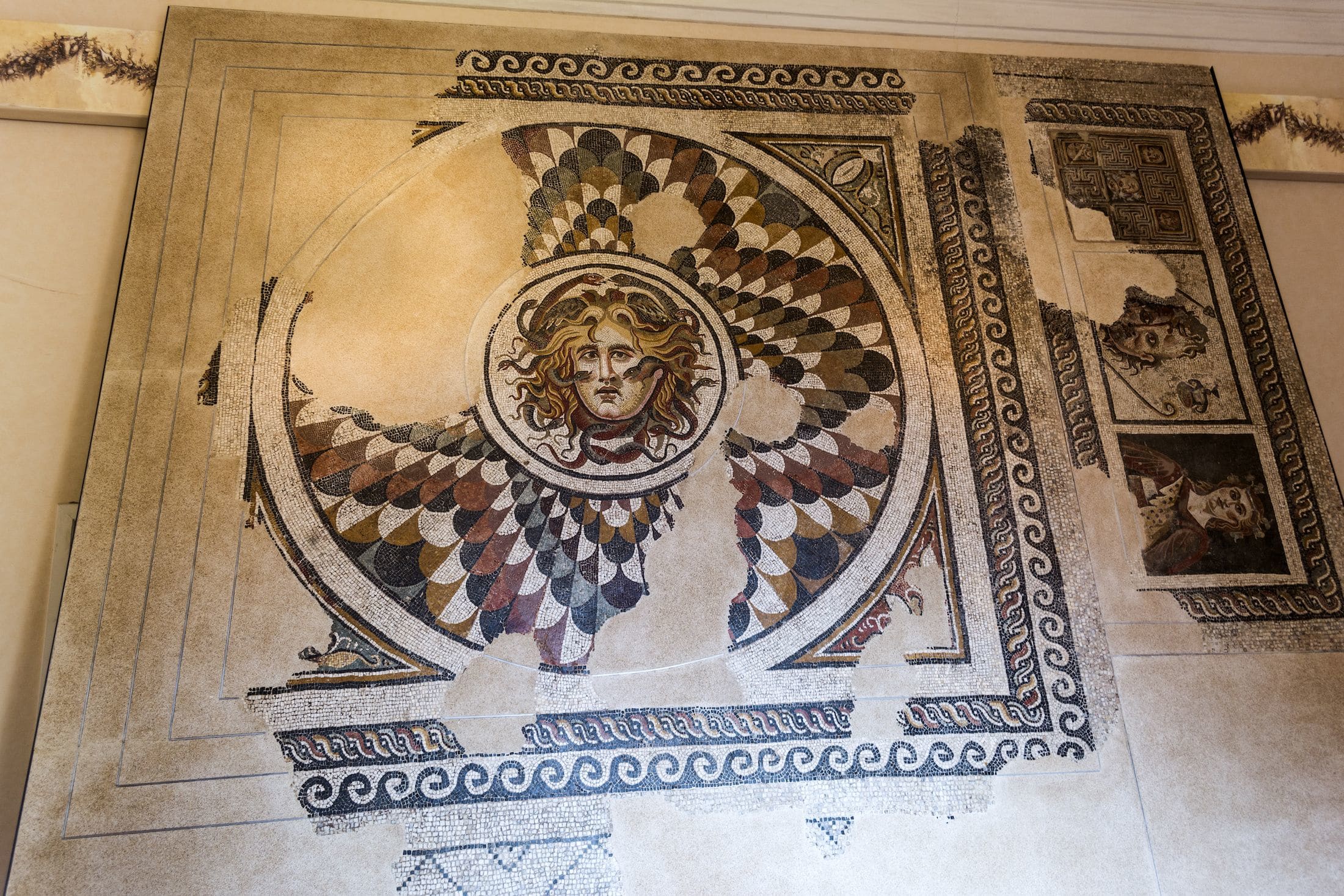
Baths of Diocletian
 Highlight of Esquilino District
Highlight of Esquilino DistrictWalk the ruins of what was once the largest themal baths in the ancient Roman world.
Covering an area of more than 13 hectares (some 32 acres), the bath complex was commissioned by Emperor Diocletian in 298 AD, with a capacity to host over 3,000 people (twice as many as the Baths of Caracalla). The baths were made of bricks, coated in marble and decorated with mosaics and sculptures. The complex included a gymnasium, a library, a large outdoor swimming pool and cold, hot, and tepid public baths. They remained open until 537 when the Goths cut off the aqueducts in an attempt to conquer Rome. After they fell into disrepair and were left abandoned. Even though only a small part of the public bath complex can be seen and visited, it is extremely impressive, with the possibility to see at some points the high ceilings the baths possessed. The interior includes part of the National Museum of Rome and a permanent exhibition on pre-historic populations of the area. In the outdoor part of the baths, it is possible to stroll through a sixteenth-century garden with nearly 400 works of art, including statues, sarcophagi and reliefs.

Basilica of Santa Maria degli Angeli
 Highlight of Esquilino District
Highlight of Esquilino DistrictSee a Michelangelo-designed church built within the former Baths of Diocletian.
In 1561, almost 1000 years after the baths of Diocletian fell into disuse, Pope Pius IV decided to build a basilica consecrated to Our Lady of the Angels within the baths. He commisioned the 86-year-old Michelangelo to plan the church, making use of some of the existing structures of the baths. Today a visit to the basilica gives you an idea of the enormous size of the baths. The church was constructed at the site of the former frigidarium (a large cold pool which would be used to close the pores after using the hot baths) and incorporates several elements of the former thermae. The vestibule occupies the former tepidarium (a Roman-style relaxation room) and the imposing entrance is an exedra of the caldarium (a room with a hot plunge bath). Other highlights include the meridian solar line running across the floor, which still accurately calculates the length of the year and the summer and winter solstices. There is also an impressive organ with 5,400 tubes. It is capable of leaving those visitors lucky enough to hear it spellbound.

Palazzo Massimo alle Terme
 Highlight of Esquilino District
Highlight of Esquilino DistrictVisit one of Rome's greatest but most unheralded museums of antiquity.
This light-filled museum holds one of the best classical art collections in the world. The ground and first-floor feature famous Greek and Roman sculptures, mosaics and statues, as well as impressive sarcophagi and high reliefs. The second floor showcases the best preserved Roman frescoes in the world, which are considered the highlight of the museum. Originally located in Villa of Livia (the wife of Augustus) and Villa Farnesina, these colourful frescoes, sometimes covering an entire room, offer a unique view into life in ancient Rome and the critical importance of gardens, nature, and the villa atmosphere to upper echelon Romans. A must visit room is the painted garden room of Villa Livia. There is also a cinema room with a video showing a 3D reconstruction of the Villa Farnesina as it would have been, showing the layout of the rooms in the villa and the frescoes you had seen just moments before.

Baths of Diocletian
 Highlight of Esquilino District
Highlight of Esquilino DistrictWalk the ruins of what was once the largest themal baths in the ancient Roman world.
Covering an area of more than 13 hectares (some 32 acres), the bath complex was commissioned by Emperor Diocletian in 298 AD, with a capacity to host over 3,000 people (twice as many as the Baths of Caracalla). The baths were made of bricks, coated in marble and decorated with mosaics and sculptures. The complex included a gymnasium, a library, a large outdoor swimming pool and cold, hot, and tepid public baths. They remained open until 537 when the Goths cut off the aqueducts in an attempt to conquer Rome. After they fell into disrepair and were left abandoned. Even though only a small part of the public bath complex can be seen and visited, it is extremely impressive, with the possibility to see at some points the high ceilings the baths possessed. The interior includes part of the National Museum of Rome and a permanent exhibition on pre-historic populations of the area. In the outdoor part of the baths, it is possible to stroll through a sixteenth-century garden with nearly 400 works of art, including statues, sarcophagi and reliefs.

Basilica of Santa Maria degli Angeli
 Highlight of Esquilino District
Highlight of Esquilino DistrictSee a Michelangelo-designed church built within the former Baths of Diocletian.
In 1561, almost 1000 years after the baths of Diocletian fell into disuse, Pope Pius IV decided to build a basilica consecrated to Our Lady of the Angels within the baths. He commisioned the 86-year-old Michelangelo to plan the church, making use of some of the existing structures of the baths. Today a visit to the basilica gives you an idea of the enormous size of the baths. The church was constructed at the site of the former frigidarium (a large cold pool which would be used to close the pores after using the hot baths) and incorporates several elements of the former thermae. The vestibule occupies the former tepidarium (a Roman-style relaxation room) and the imposing entrance is an exedra of the caldarium (a room with a hot plunge bath). Other highlights include the meridian solar line running across the floor, which still accurately calculates the length of the year and the summer and winter solstices. There is also an impressive organ with 5,400 tubes. It is capable of leaving those visitors lucky enough to hear it spellbound.
prev
next

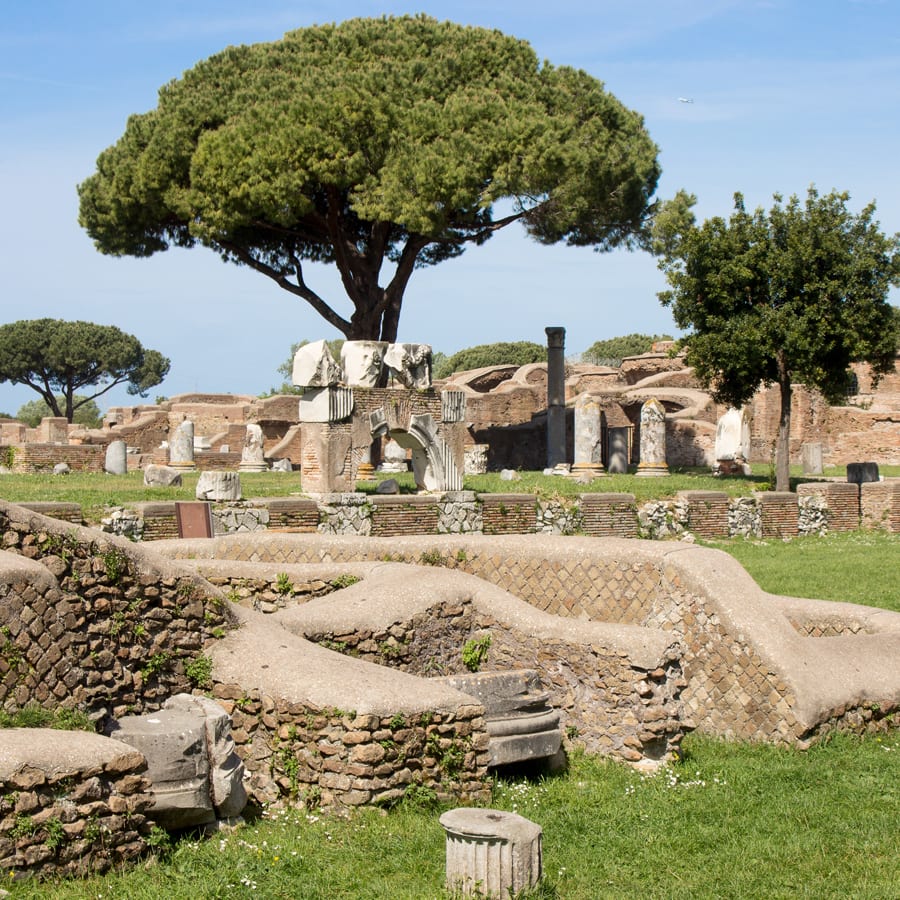
Day 13
Rome
View More
Day 13
Rome

Early Morning to Mid-Day
Visiting the Ruins of Ostia Antica
Just 20 miles from Rome lies one of the largest and most interesting excavation sites and preserved ruins of the Roman Empire outside of Pompeii; the former port city of Ostia Antica. As one of Rome’s most overlooked and undervalued site by tourists visiting the city, it's a must-do day trip for anyone interested in the Roman history and life as it was in one of Rome's original port cities. It is especially nice to be able to enjoy the ruins in quiet and contemplation without the crowds which fill the ruins of Pompeii. Getting there is easy. A suburban commuter train service (or overground metro) runs several times an hour from central Rome to the coast and stops at Ostia Antica station. Since the train is part of Rome's Metro Network, you won't even need to purchase additional tickets if you have a Roma Pass.

Theater
Stare down at the theater stage as the audience did two milennia ago.
Show More

Ostia Antica Museum
Visit a museum filled with sculptures and artwork rescued from the ruins.
Show More

Bath of Neptune
Admire the mosaic floors of this once luxurious bath built for the people of Ostia.
Show More

Square of Guilds
Take a peaceful stroll through a place which was once filled with the hubbub of business dealings.
Show More

Theater
Stare down at the theater stage as the audience did two milennia ago.
Show More

Ostia Antica Museum
Visit a museum filled with sculptures and artwork rescued from the ruins.
Show More

Bath of Neptune
Admire the mosaic floors of this once luxurious bath built for the people of Ostia.
Show More

Square of Guilds
Take a peaceful stroll through a place which was once filled with the hubbub of business dealings.
Show More
prev
next

Day 13
Rome
View More


Theater
 Highlight of Ostia Antica
Highlight of Ostia AnticaStare down at the theater stage as the audience did two milennia ago.
Originally built during the reign of Emperor Augustus, it was later enlarged to seat up to 2,700 spectators. Most of the theater's structure remains visible, and you can climb to the top level (where women would have typically sat thanks to the gender division rules of Ancient Rome) to get a good overview. Musicians and typically performed in the ground floor semi-circle, while actors would have used the wooden stage. In ancient times, there would have been a large brick wall behind the stage where scenery would be hung.
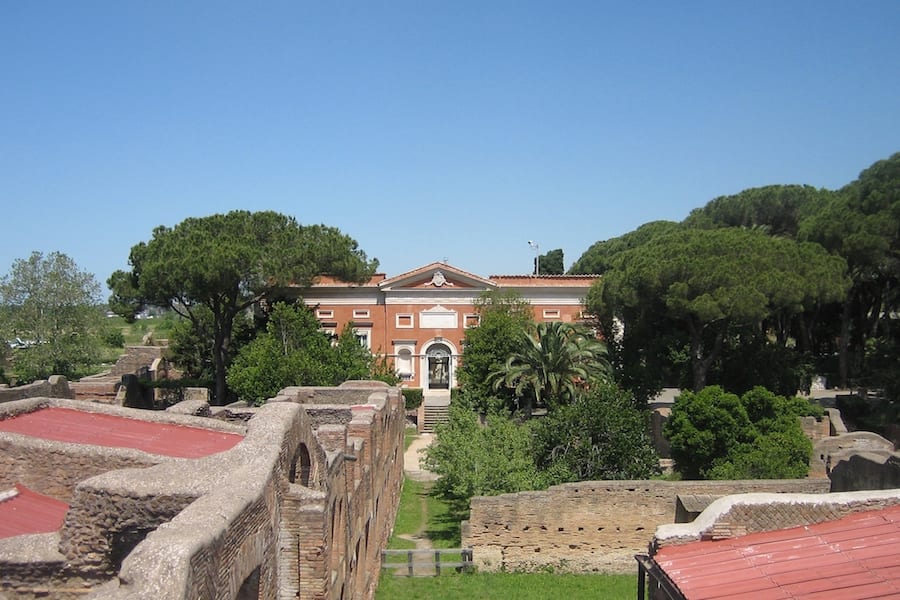
Ostia Antica Museum
 Highlight of Ostia Antica
Highlight of Ostia AnticaVisit a museum filled with sculptures and artwork rescued from the ruins.
This splendid Renaissance building was originally built to store salt supplies from the nearby salt pans. Today, it is home to a rich collection of sculptures, busts, paintings and mosaics which have been discovered during the numerous excavations at Ostia. Among the museum's highlights are a large marble statue of Minerva that was probably from Porta Romana; a relief from the Temple of Hercules dating from between 80 and 65 BC; a statue of Perseus holding the head of Medusa found in a villa outside Porta Laurentina; and a portrait of Trajan, a rare masterpiece that was found in the theater.

Bath of Neptune
 Highlight of Ostia Antica
Highlight of Ostia AnticaAdmire the mosaic floors of this once luxurious bath built for the people of Ostia.
Built by Emperor Hadrian in 139 AD, these luxurious bathhouses were a gift to the people of Ostia. Bathhouses were a very important aspect of Roman culture, a place where the common man could mingle with senators and centurions on a daily basis. Like most grand bathhouses, the floors of the Ostia bathhouse were adorned with beautiful mosaics. Many of the black and white mosaics have been relatively well preserved with the largest mosaic of Neptune riding four horses through the sea being the most impressive.

Square of Guilds
 Highlight of Ostia Antica
Highlight of Ostia AnticaTake a peaceful stroll through a place which was once filled with the hubbub of business dealings.
This open-air market was essential for Rome, with merchants from foreign lands gathering here to sell anything from grain and shipping services to elephants and giraffes. The most notable detail of the Square of Guilds are the intricate black and white mosaics that lie in front and inside of each shop. These mosaics indicated the professional associations of each vendor as well as inspired a sense of nostalgia for the distant homes of each of the merchants. It is important to note that these shops did not have any merchandise in them (they were too small). Instead, they functioned more as offices where people could meet and create deals.

Theater
 Highlight of Ostia Antica
Highlight of Ostia AnticaStare down at the theater stage as the audience did two milennia ago.
Originally built during the reign of Emperor Augustus, it was later enlarged to seat up to 2,700 spectators. Most of the theater's structure remains visible, and you can climb to the top level (where women would have typically sat thanks to the gender division rules of Ancient Rome) to get a good overview. Musicians and typically performed in the ground floor semi-circle, while actors would have used the wooden stage. In ancient times, there would have been a large brick wall behind the stage where scenery would be hung.

Ostia Antica Museum
 Highlight of Ostia Antica
Highlight of Ostia AnticaVisit a museum filled with sculptures and artwork rescued from the ruins.
This splendid Renaissance building was originally built to store salt supplies from the nearby salt pans. Today, it is home to a rich collection of sculptures, busts, paintings and mosaics which have been discovered during the numerous excavations at Ostia. Among the museum's highlights are a large marble statue of Minerva that was probably from Porta Romana; a relief from the Temple of Hercules dating from between 80 and 65 BC; a statue of Perseus holding the head of Medusa found in a villa outside Porta Laurentina; and a portrait of Trajan, a rare masterpiece that was found in the theater.

Bath of Neptune
 Highlight of Ostia Antica
Highlight of Ostia AnticaAdmire the mosaic floors of this once luxurious bath built for the people of Ostia.
Built by Emperor Hadrian in 139 AD, these luxurious bathhouses were a gift to the people of Ostia. Bathhouses were a very important aspect of Roman culture, a place where the common man could mingle with senators and centurions on a daily basis. Like most grand bathhouses, the floors of the Ostia bathhouse were adorned with beautiful mosaics. Many of the black and white mosaics have been relatively well preserved with the largest mosaic of Neptune riding four horses through the sea being the most impressive.

Square of Guilds
 Highlight of Ostia Antica
Highlight of Ostia AnticaTake a peaceful stroll through a place which was once filled with the hubbub of business dealings.
This open-air market was essential for Rome, with merchants from foreign lands gathering here to sell anything from grain and shipping services to elephants and giraffes. The most notable detail of the Square of Guilds are the intricate black and white mosaics that lie in front and inside of each shop. These mosaics indicated the professional associations of each vendor as well as inspired a sense of nostalgia for the distant homes of each of the merchants. It is important to note that these shops did not have any merchandise in them (they were too small). Instead, they functioned more as offices where people could meet and create deals.
prev
next

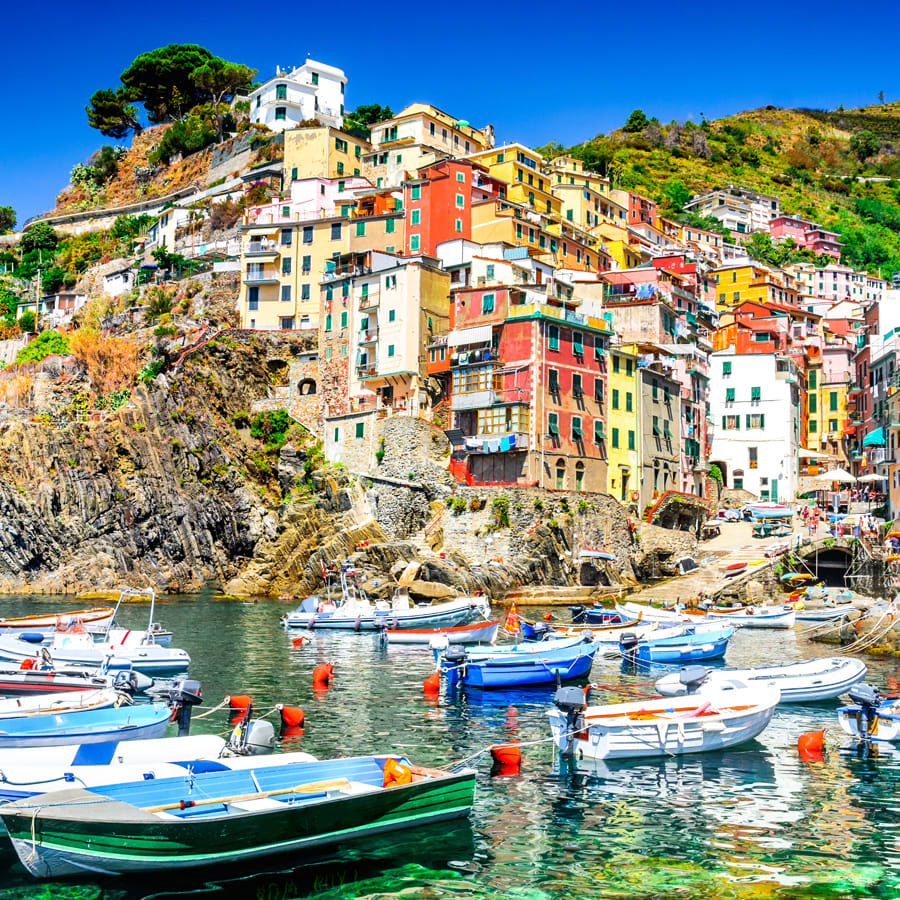
Day 14
Rome to Cinque Terre
View More
Day 14
Rome to Cinque Terre




8:55 AM
Private Transfer to Rome Termini Train Station
A private transfer service will pick you up from the N/A and deliver you to Rome Termini Train Station. Your itinerary will provide detailed information on navigating the train station and finding your train, making the whole process simple and stress-free.

Day 14
Rome to Cinque Terre
View More


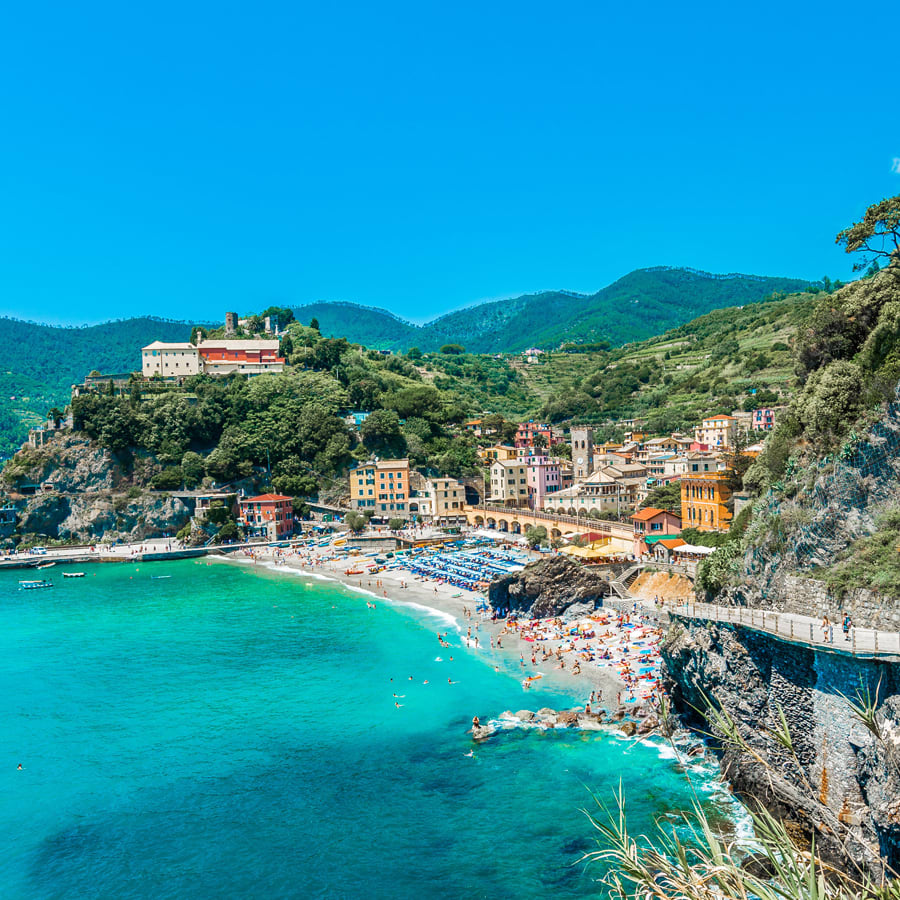
Day 15
Cinque Terre
View More
Day 15
Cinque Terre


Morning to Afternoon
Exploring Monterosso
The northernmost village, Monterosso al Mare is the largest of the five towns in Cinque Terre. Situated in the centre of a small natural gulf, it is also the most populated village of the Cinque Terre. During your visit, explore this quaint old-world town with its crooked lanes, churches, viewpoints and beaches. If you are looking to take a swim or just relax by the water, keep in mind that Monterosso also has the best and largest beach in Cinque Terre. Monterosso is easily reached by taking the Cinque Terre Express train, or if you are feeling more adventurous, by hiking up the coast.

Monterosso Public Beach
Enjoy some swimming or sunbathing on Monterosso's free public pebble beach.
Show More

Monterosso Paid Beach
Spend a little cash on an umbrella, and you can enjoy the Cinque Terre's best beach.
Show More

St. Francis and the Wolf
Hike up to this statue of Saint Francis for a beautiful view overlooking Monteross and the sea.
Show More

Church of San Giovanni Battista
Step inside this 14th-century church that sits in the heart of old Monterosso.
Show More

Monterosso Public Beach
Enjoy some swimming or sunbathing on Monterosso's free public pebble beach.
Show More

Monterosso Paid Beach
Spend a little cash on an umbrella, and you can enjoy the Cinque Terre's best beach.
Show More

St. Francis and the Wolf
Hike up to this statue of Saint Francis for a beautiful view overlooking Monteross and the sea.
Show More

Church of San Giovanni Battista
Step inside this 14th-century church that sits in the heart of old Monterosso.
Show More
prev
next

Day 15
Cinque Terre
View More

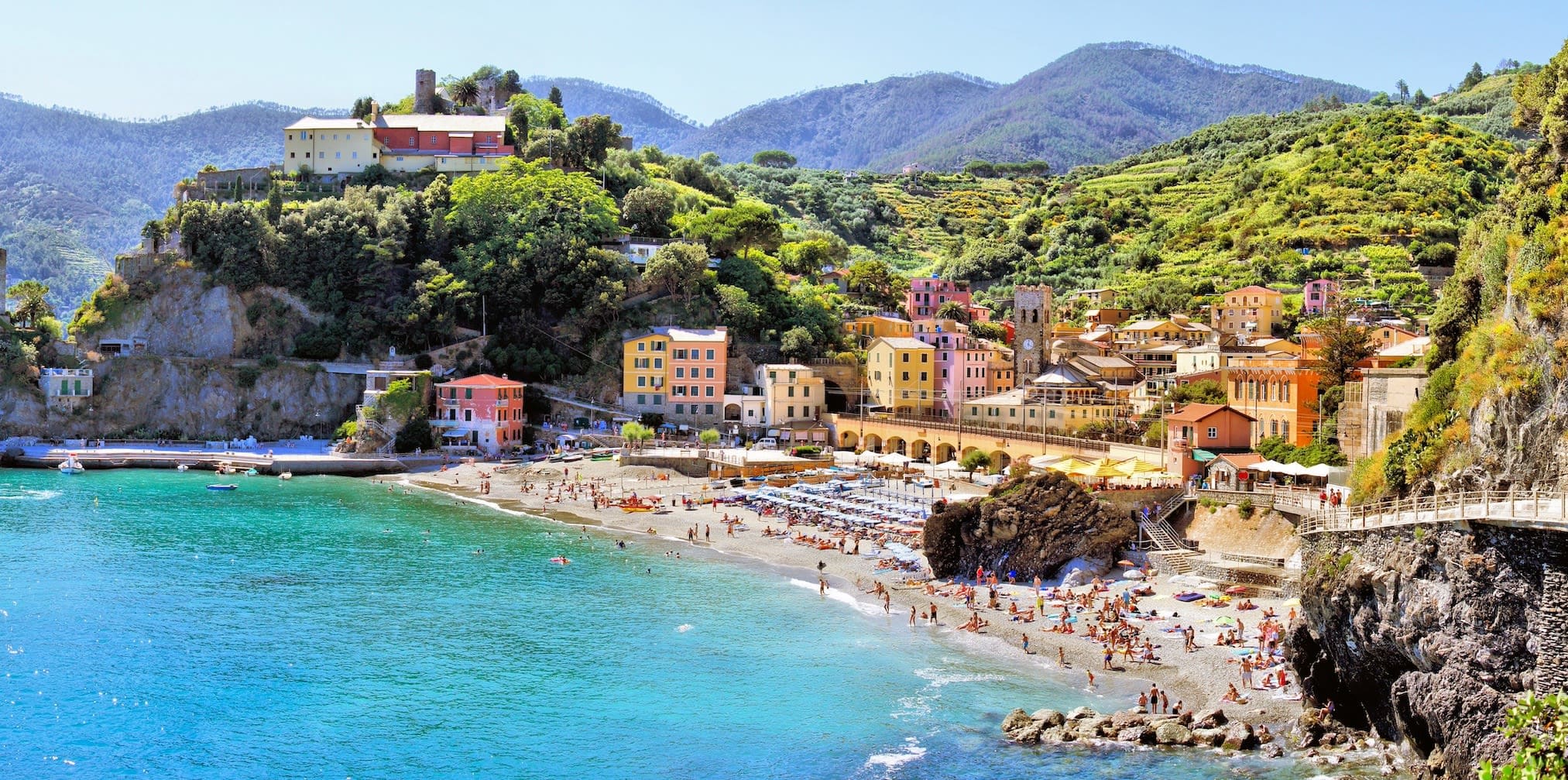
Monterosso Public Beach
 Highlight of Monterosso
Highlight of MonterossoEnjoy some swimming or sunbathing on Monterosso's free public pebble beach.
Monterosso is the most popular Cinque Terre town for those wishing to enjoy some beach time, but not all of its beach is accessible without paying. This area of the beach (pebbly) next to the "old town" is free for public use although there are also umbrellas and sunbeds available for hire as well. You'll also find another free public beach further up after the train station in what is known as "Monterosso's New Town" and a paid beach with rented sunloungers in front of the train station.
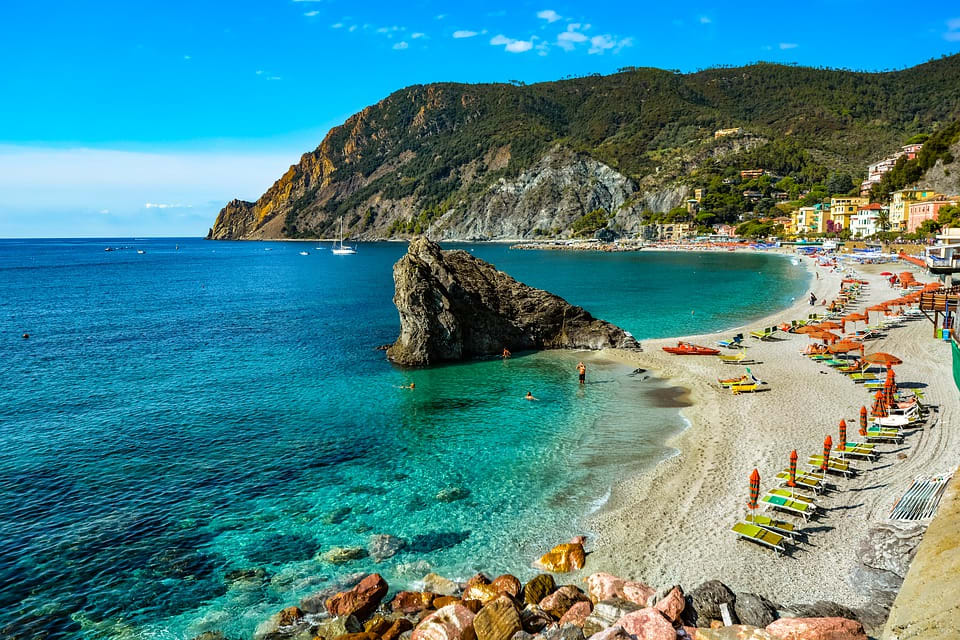
Monterosso Paid Beach
 Highlight of Monterosso
Highlight of MonterossoSpend a little cash on an umbrella, and you can enjoy the Cinque Terre's best beach.
Most of this long stretch of beach is for paying customers only, where you can hire a set of umbrellas costing around €20-25 for the day. Use of this section of the beach is prohibited unless you pay for an umbrella and security lifeguards are always on the watch and will ask you to leave if you do not wish to pay. There is also a beach restaurant and beach huts with toilets and showers available for paying customers.
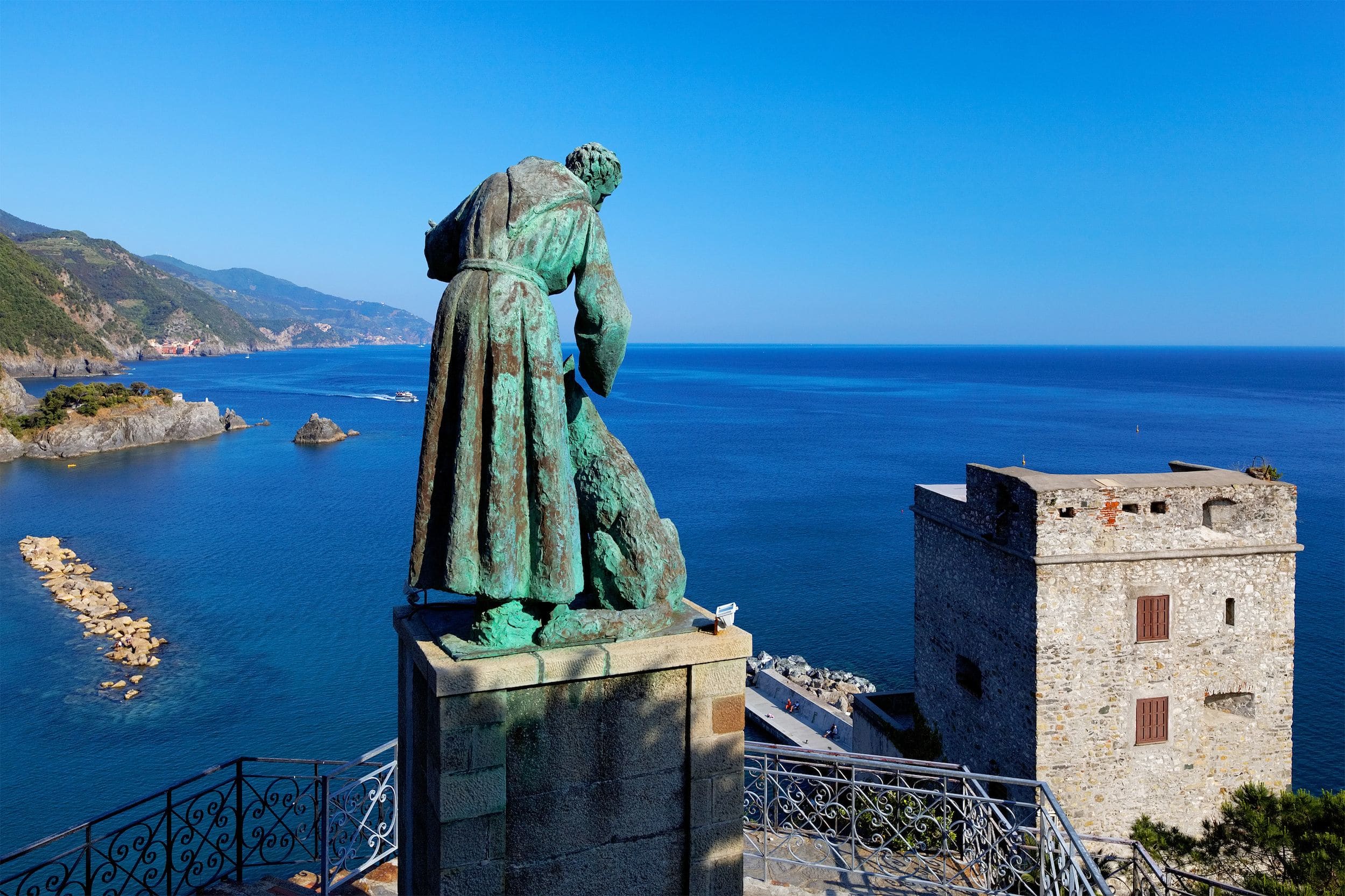
St. Francis and the Wolf
 Highlight of Monterosso
Highlight of MonterossoHike up to this statue of Saint Francis for a beautiful view overlooking Monteross and the sea.
Sculpted by Milanese sculptor Silvio Monfrini in 1962, the Statue of St Francis of Assisi and his dog (often referred to as a wolf or Lupo in Italian) occupies a gorgeous terrace high above the village near the Convent of the Capuchin Friars. While the steep stairs may tax your muscles, the view from the terrace over Monterosso and the bay below is breathtaking. Well worth the effort! Below the statue you will see the Torre Aurora, a former 16th-century watchtower built by the Republic of Genoa to defend the town from Saracen pirates. In the past, Monterosso was guarded very well, with thirteen towers keeping a watchful eye over the horizon. Torre Aurora is one of three remaining towers. Looming over the town it now holds no purpose other than being used as a private residence, but you will find a small restaurant called Ristorante L'Ancora della Tortuga at its base and a small bunker built in World War II as a defense against an Allied invasion.
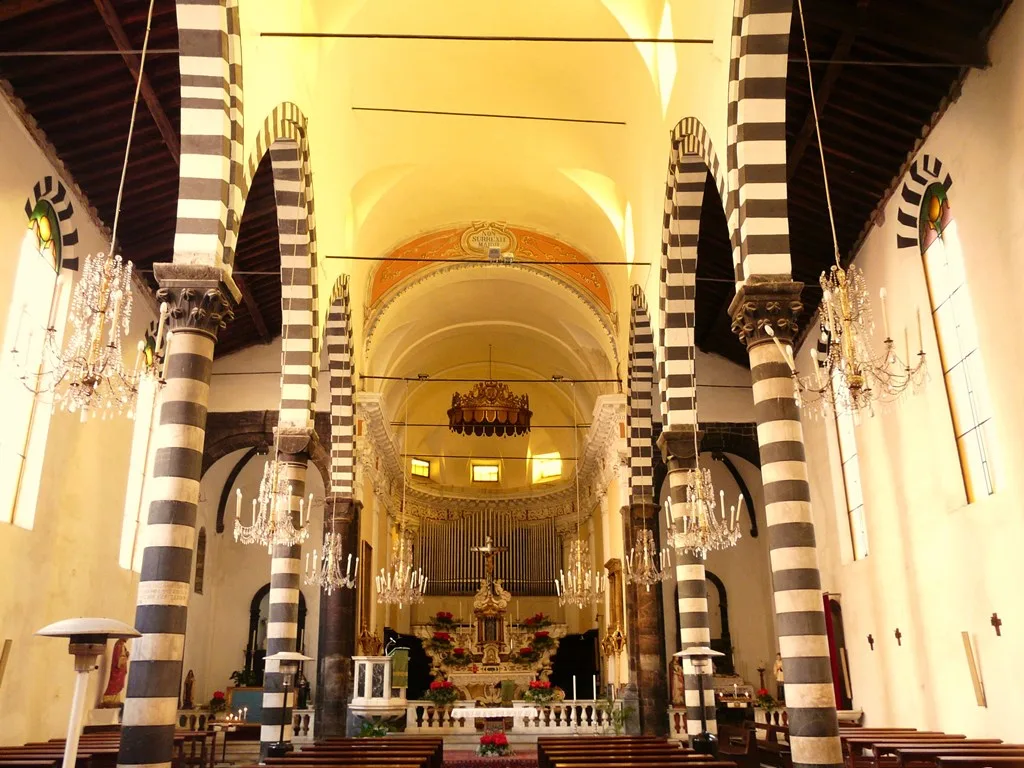
Church of San Giovanni Battista
 Highlight of Monterosso
Highlight of MonterossoStep inside this 14th-century church that sits in the heart of old Monterosso.
The Church of San Giovanni Battista (St John the Baptist) located just off the main piazza in Monterosso was constructed in the 1200s, in the Gothic-Genovese style. Inside, there is a fresco depicting the baptism of Christ and near the second side door, you'll find the high-water mark from a flood in October 1966 which was famous for also destroying the city of Florence. Nearby a second plaque marks the high-water from the devastating floods of 2011 that destroyed many of the towns in Cinque Terre.

Monterosso Public Beach
 Highlight of Monterosso
Highlight of MonterossoEnjoy some swimming or sunbathing on Monterosso's free public pebble beach.
Monterosso is the most popular Cinque Terre town for those wishing to enjoy some beach time, but not all of its beach is accessible without paying. This area of the beach (pebbly) next to the "old town" is free for public use although there are also umbrellas and sunbeds available for hire as well. You'll also find another free public beach further up after the train station in what is known as "Monterosso's New Town" and a paid beach with rented sunloungers in front of the train station.

Monterosso Paid Beach
 Highlight of Monterosso
Highlight of MonterossoSpend a little cash on an umbrella, and you can enjoy the Cinque Terre's best beach.
Most of this long stretch of beach is for paying customers only, where you can hire a set of umbrellas costing around €20-25 for the day. Use of this section of the beach is prohibited unless you pay for an umbrella and security lifeguards are always on the watch and will ask you to leave if you do not wish to pay. There is also a beach restaurant and beach huts with toilets and showers available for paying customers.

St. Francis and the Wolf
 Highlight of Monterosso
Highlight of MonterossoHike up to this statue of Saint Francis for a beautiful view overlooking Monteross and the sea.
Sculpted by Milanese sculptor Silvio Monfrini in 1962, the Statue of St Francis of Assisi and his dog (often referred to as a wolf or Lupo in Italian) occupies a gorgeous terrace high above the village near the Convent of the Capuchin Friars. While the steep stairs may tax your muscles, the view from the terrace over Monterosso and the bay below is breathtaking. Well worth the effort! Below the statue you will see the Torre Aurora, a former 16th-century watchtower built by the Republic of Genoa to defend the town from Saracen pirates. In the past, Monterosso was guarded very well, with thirteen towers keeping a watchful eye over the horizon. Torre Aurora is one of three remaining towers. Looming over the town it now holds no purpose other than being used as a private residence, but you will find a small restaurant called Ristorante L'Ancora della Tortuga at its base and a small bunker built in World War II as a defense against an Allied invasion.

Church of San Giovanni Battista
 Highlight of Monterosso
Highlight of MonterossoStep inside this 14th-century church that sits in the heart of old Monterosso.
The Church of San Giovanni Battista (St John the Baptist) located just off the main piazza in Monterosso was constructed in the 1200s, in the Gothic-Genovese style. Inside, there is a fresco depicting the baptism of Christ and near the second side door, you'll find the high-water mark from a flood in October 1966 which was famous for also destroying the city of Florence. Nearby a second plaque marks the high-water from the devastating floods of 2011 that destroyed many of the towns in Cinque Terre.
prev
next

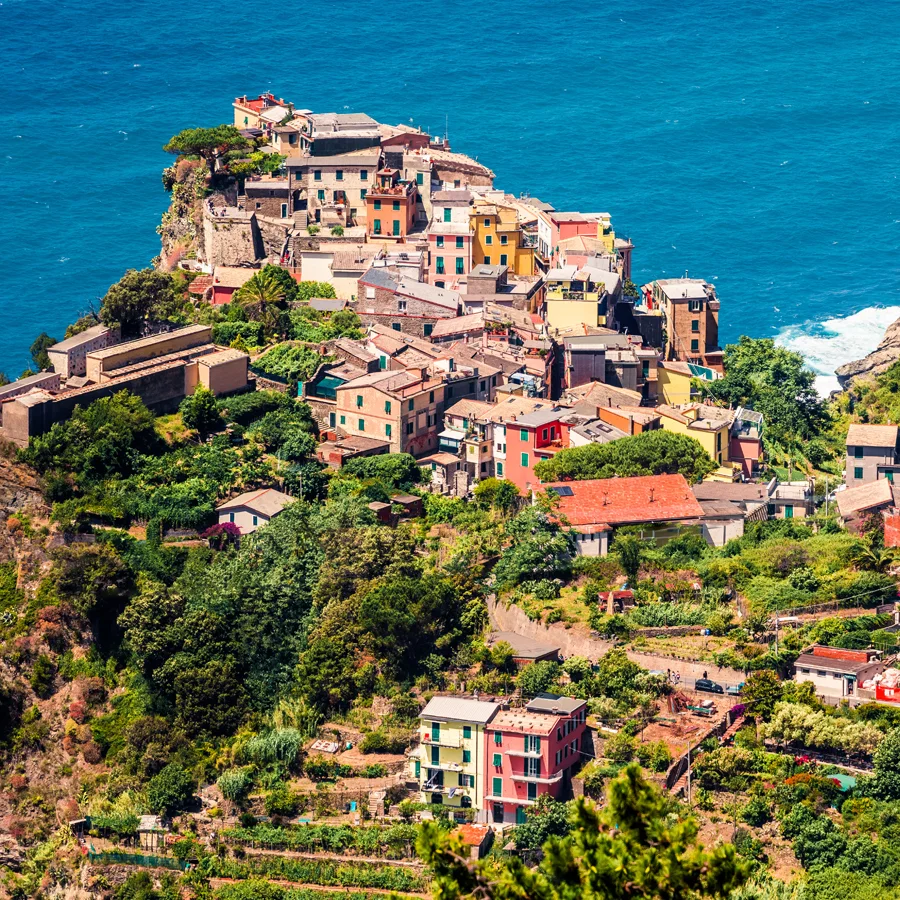
Day 16
Cinque Terre
View More
Day 16
Cinque Terre


Morning/Mid-Day
Discover Corniglia, Cinque Terre's Least-Visited Village
Located on top of a 100-meter promontory, Corniglia is the highest of the five villages and is surrounded by a sea of olive trees and vineyards. Corniglia is the only village not to be sat on the water, and it is the least visited town in Cinque Terre, making it the perfect option for those who want to escape the crowds and enjoy a spot of peace and quiet amongst its shaded lanes. Due to its location on top of the hill, Corniglia's train station isn't located in the heart of the town like the other 4 towns in Cinque Terre. Instead, you have to take a local shuttle to the top or if you are brave enough, you can tackle the “Lardarina”, a long brick flight of steps composed of 33 flights with 382 steps! Roughly a 20 minute walk uphill. The route by stairs is very clearly marked from the train station. Begin walking down the main street called Via Fieschi and you'll immediately notice three things; fewer tourists, the scent of lemons, and multiple gelato shops! Souvenir shops adorn their doors and outdoor baskets with locally-grown lemon products, such as hand-made soups. A great way to keep the whole family happy is the Granita Limone, a slushy like cold frozen drink which can be eaten like ice cream or with a warm brioche (bread).

Corniglia Main Town Square
Enjoy the laid back vibes or a refreshing drink in the town's small but charming main square.
Show More

View Point Corniglia
Walk to tip-top of Corniglia to admire the tremendous coastal views.
Show More

Corniglia Main Town Square
Enjoy the laid back vibes or a refreshing drink in the town's small but charming main square.
Show More

View Point Corniglia
Walk to tip-top of Corniglia to admire the tremendous coastal views.
Show More

Corniglia Main Town Square
Enjoy the laid back vibes or a refreshing drink in the town's small but charming main square.
Show More

View Point Corniglia
Walk to tip-top of Corniglia to admire the tremendous coastal views.
Show More
prev
next

Day 16
Cinque Terre
View More

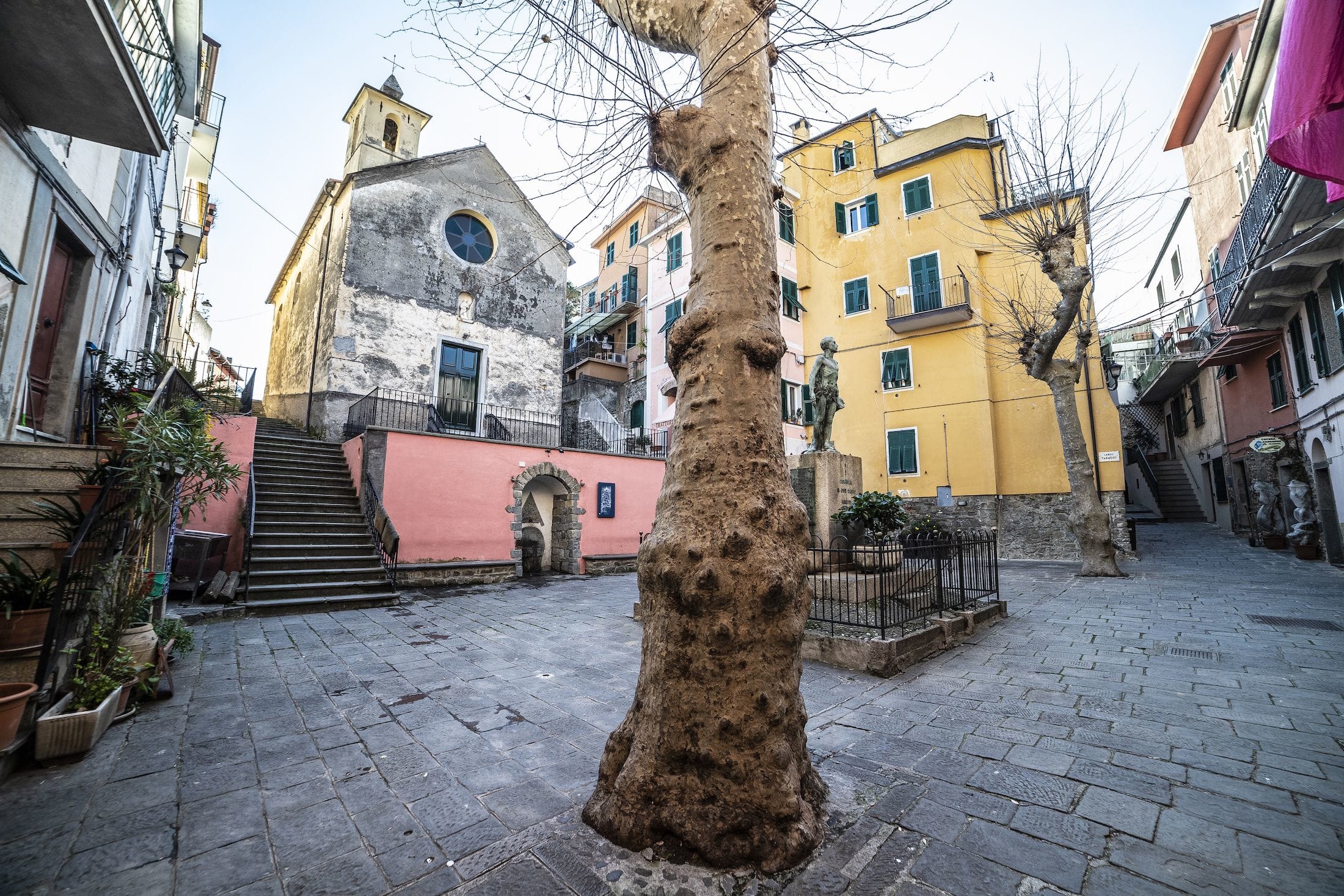
Corniglia Main Town Square
 Highlight of Corniglia
Highlight of CornigliaEnjoy the laid back vibes or a refreshing drink in the town's small but charming main square.
The life and action of the town takes place at the main square where you'll find tables and chairs fill this small space, which is centered by a Memorial to the Fallen and the town's old well. This is the beating heart of the community and on a quiet afternoon (mostly in the off-season (April and October) you'll see the town's elderly sitting on the benches after mass catching up on the local gossip, reading the newspaper or enjoying a game of cards.
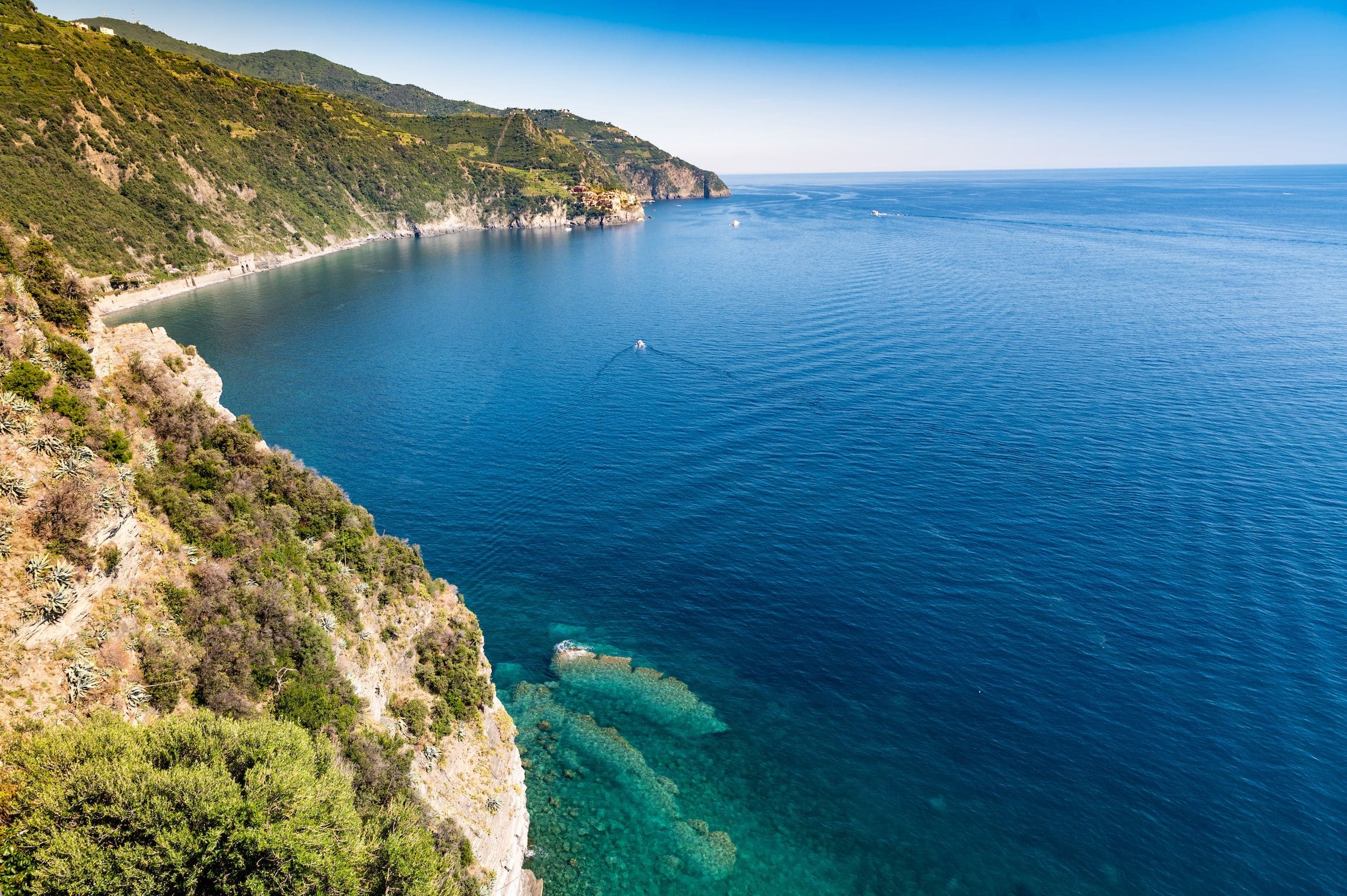
View Point Corniglia
 Highlight of Corniglia
Highlight of CornigliaWalk to tip-top of Corniglia to admire the tremendous coastal views.
A small terrace at the western tip of the town provides a nice view of the coastline both to north and south, allowing you to see both the neighboring towns and the sea. Keep in mind though that this panoramic spot can be quite busy in the summer months.

Corniglia Main Town Square
 Highlight of Corniglia
Highlight of CornigliaEnjoy the laid back vibes or a refreshing drink in the town's small but charming main square.
The life and action of the town takes place at the main square where you'll find tables and chairs fill this small space, which is centered by a Memorial to the Fallen and the town's old well. This is the beating heart of the community and on a quiet afternoon (mostly in the off-season (April and October) you'll see the town's elderly sitting on the benches after mass catching up on the local gossip, reading the newspaper or enjoying a game of cards.

View Point Corniglia
 Highlight of Corniglia
Highlight of CornigliaWalk to tip-top of Corniglia to admire the tremendous coastal views.
A small terrace at the western tip of the town provides a nice view of the coastline both to north and south, allowing you to see both the neighboring towns and the sea. Keep in mind though that this panoramic spot can be quite busy in the summer months.

Corniglia Main Town Square
 Highlight of Corniglia
Highlight of CornigliaEnjoy the laid back vibes or a refreshing drink in the town's small but charming main square.
The life and action of the town takes place at the main square where you'll find tables and chairs fill this small space, which is centered by a Memorial to the Fallen and the town's old well. This is the beating heart of the community and on a quiet afternoon (mostly in the off-season (April and October) you'll see the town's elderly sitting on the benches after mass catching up on the local gossip, reading the newspaper or enjoying a game of cards.

View Point Corniglia
 Highlight of Corniglia
Highlight of CornigliaWalk to tip-top of Corniglia to admire the tremendous coastal views.
A small terrace at the western tip of the town provides a nice view of the coastline both to north and south, allowing you to see both the neighboring towns and the sea. Keep in mind though that this panoramic spot can be quite busy in the summer months.
prev
next

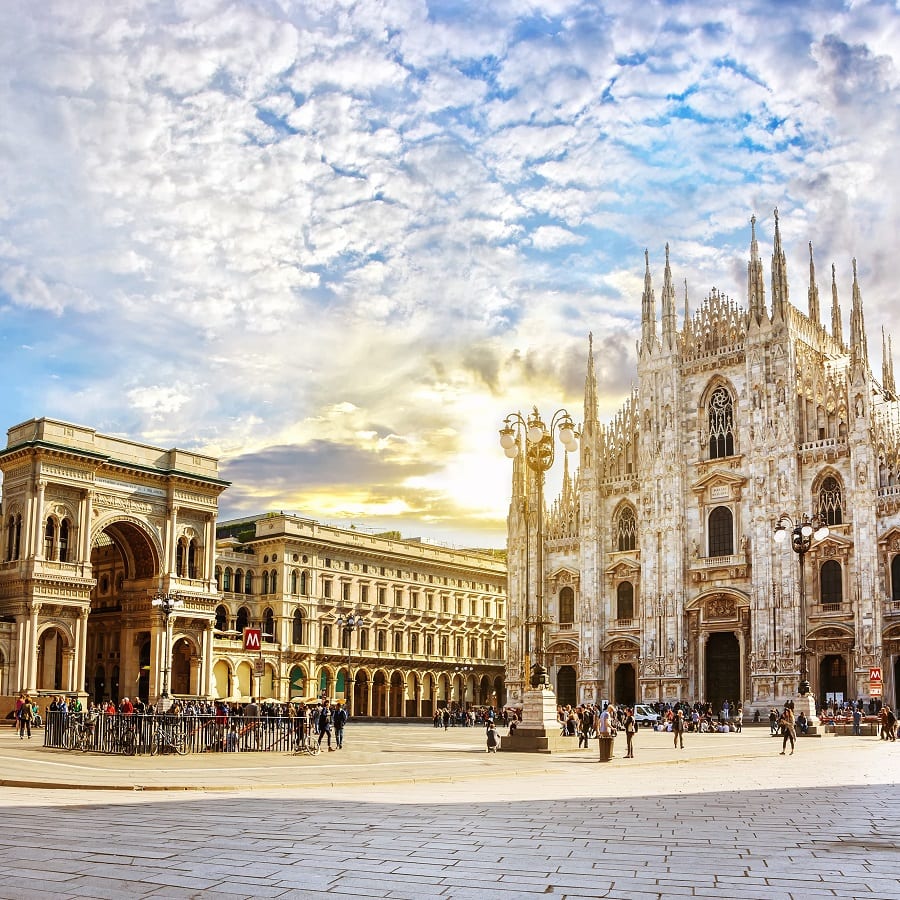
Day 17
Cinque Terre to Milan
View More
Day 17
Cinque Terre to Milan





To Be Determined
Take a Local Train to the Rail Station

Day 17
Cinque Terre to Milan
View More


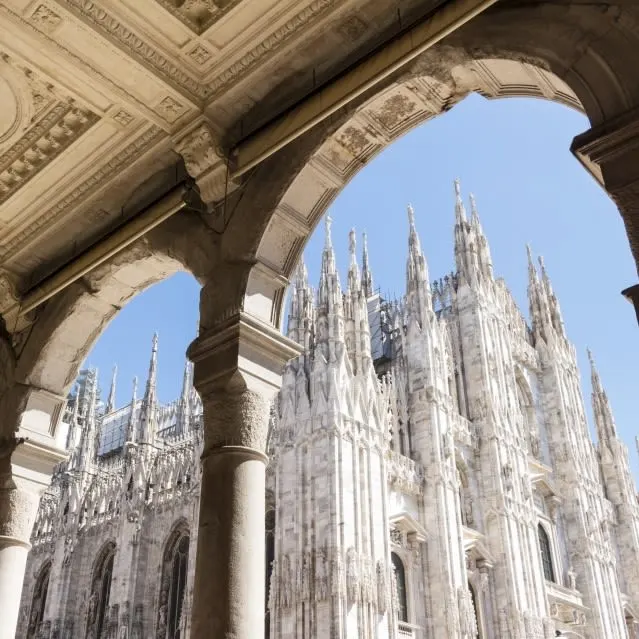
Day 18
Milan
View More
Day 18
Milan



9:00 AM - 12:00 PM
Best of Milan Private Walking Tour
Milan is the center of business and the capital of Italian fashion, but it also has an ancient heritage and a fascinating history; here you find some of the greatest masterpieces of Italian art! Together with your guide, you’ll explore the magnificent Duomo, Galleria, Scala opera house, merchant square, financial district, food street, and Sforza Castle.

La Scala Opera House
Take a tour or experience an opera or ballet in this world-famous opera house.
Show More

Sforza Castle
A huge Medieval-Renaissance fortress with a number of interesting history and art museums
Show More

Galleria Vittorio Emanuele II
Take a stroll through this ornate covered shopping mall that was completed in 1877.
Show More

La Scala Opera House
Take a tour or experience an opera or ballet in this world-famous opera house.
Show More

Sforza Castle
A huge Medieval-Renaissance fortress with a number of interesting history and art museums
Show More

Galleria Vittorio Emanuele II
Take a stroll through this ornate covered shopping mall that was completed in 1877.
Show More

La Scala Opera House
Take a tour or experience an opera or ballet in this world-famous opera house.
Show More
prev
next

Day 18
Milan
View More

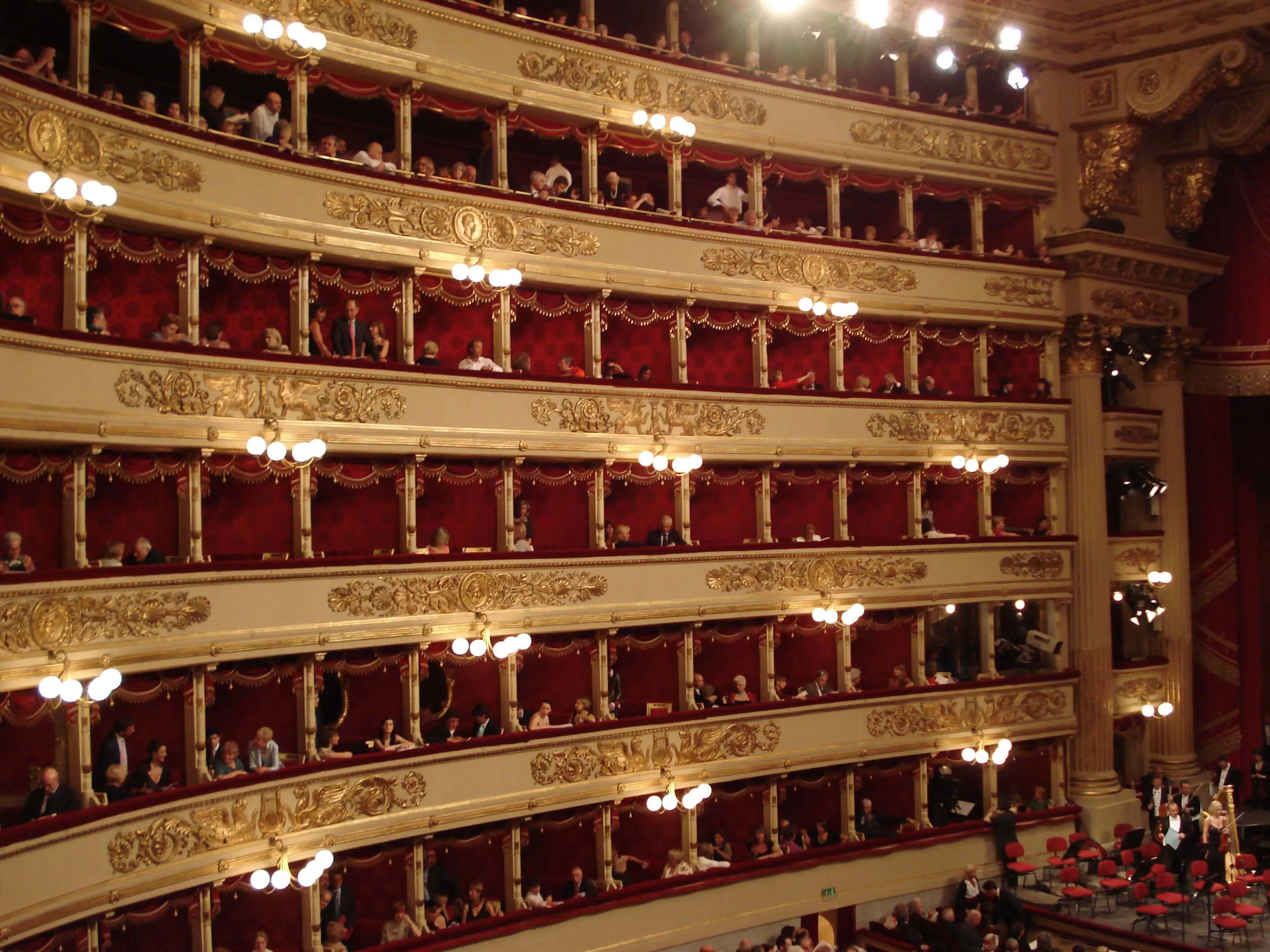
La Scala Opera House
 Highlight of Guided Walk in Milan
Highlight of Guided Walk in MilanTake a tour or experience an opera or ballet in this world-famous opera house.
Considered one of the most important and famous theatres in the world, known as the ‘Temple of Opera’, La Scala has hosted the most revered names in the world of music and theatre. Many famous operas have had their first production in La Scala, such as Othello, Nabucco by Verdi or Madame Butterfly by Giacomo Puccini. While seeing a performance is the best way to experience the theater, visiting the Theatre Museum or taking a guided tour which includes the museum are also great options. In addition to a large collection of paintings, busts, costumes, and other objects related to the world of opera and theater, you will get to see parts of La Scala which are otherwise off limits, like the boxes. Unless a rehearsal or show is in progress, visitors can even watch the set-moving machinery in action.
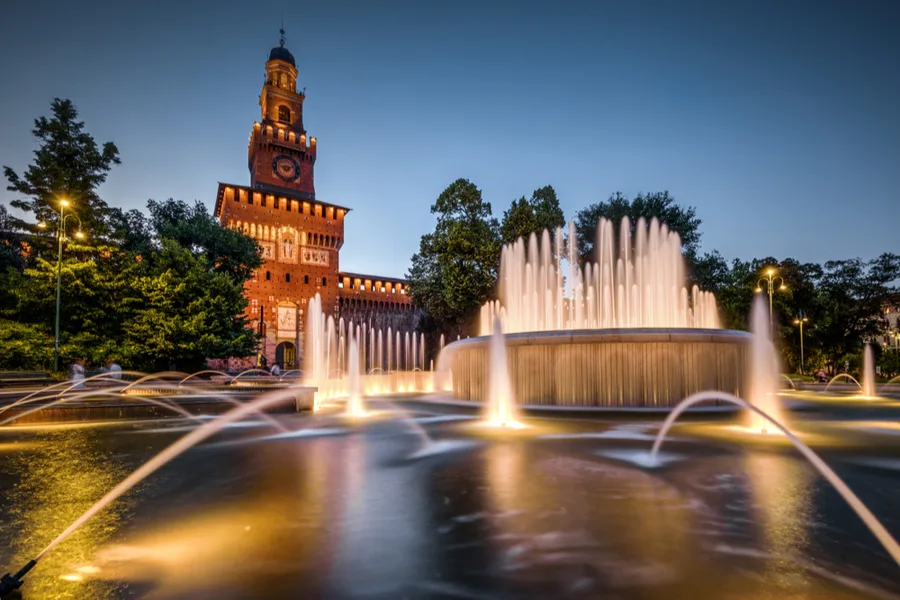
Sforza Castle
 Highlight of Guided Walk in Milan
Highlight of Guided Walk in MilanA huge Medieval-Renaissance fortress with a number of interesting history and art museums
The Sforzesco Castle, one of the most popular monuments in Milan, has undergone various and complex transformations over the centuries; it has been defense fortress, military barracks, private residence and now a center of cultural institutions with several specialized museums and galleries that hold important fragments of Milan's cultural and civic history.
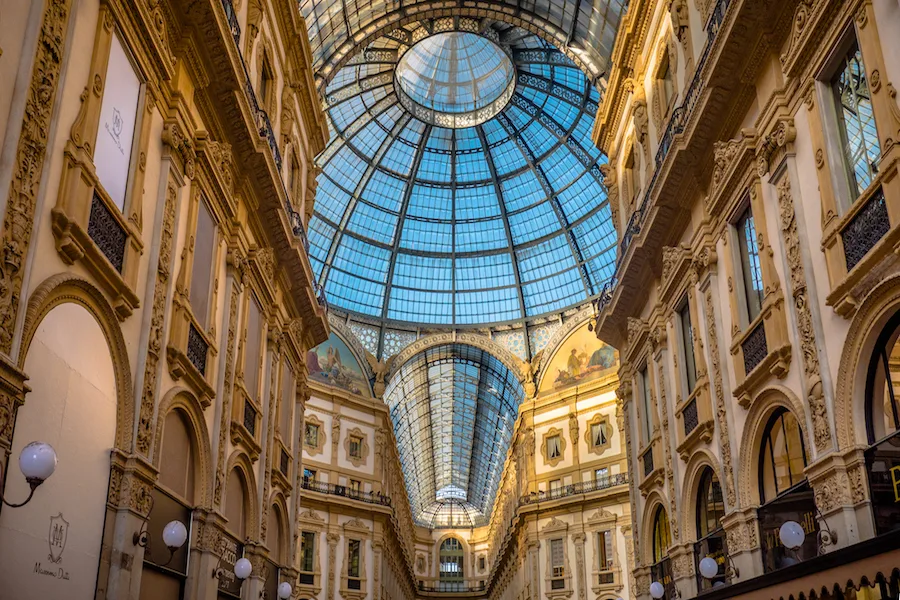
Galleria Vittorio Emanuele II
 Highlight of Guided Walk in Milan
Highlight of Guided Walk in MilanTake a stroll through this ornate covered shopping mall that was completed in 1877.
Known as the "drawing room" of Milan, due to its numerous shops and importance as a common Milanese meeting and dining place, the Galleria Vittorio Emanuele II is Italy's oldest active shopping mall and a major landmark in the city. It is one of the most magnificent shopping arcades in the world, home to some of the most luxurious boutiques and brands including Prada, Armani, Gucci.

La Scala Opera House
 Highlight of Guided Walk in Milan
Highlight of Guided Walk in MilanTake a tour or experience an opera or ballet in this world-famous opera house.
Considered one of the most important and famous theatres in the world, known as the ‘Temple of Opera’, La Scala has hosted the most revered names in the world of music and theatre. Many famous operas have had their first production in La Scala, such as Othello, Nabucco by Verdi or Madame Butterfly by Giacomo Puccini. While seeing a performance is the best way to experience the theater, visiting the Theatre Museum or taking a guided tour which includes the museum are also great options. In addition to a large collection of paintings, busts, costumes, and other objects related to the world of opera and theater, you will get to see parts of La Scala which are otherwise off limits, like the boxes. Unless a rehearsal or show is in progress, visitors can even watch the set-moving machinery in action.

Sforza Castle
 Highlight of Guided Walk in Milan
Highlight of Guided Walk in MilanA huge Medieval-Renaissance fortress with a number of interesting history and art museums
The Sforzesco Castle, one of the most popular monuments in Milan, has undergone various and complex transformations over the centuries; it has been defense fortress, military barracks, private residence and now a center of cultural institutions with several specialized museums and galleries that hold important fragments of Milan's cultural and civic history.

Galleria Vittorio Emanuele II
 Highlight of Guided Walk in Milan
Highlight of Guided Walk in MilanTake a stroll through this ornate covered shopping mall that was completed in 1877.
Known as the "drawing room" of Milan, due to its numerous shops and importance as a common Milanese meeting and dining place, the Galleria Vittorio Emanuele II is Italy's oldest active shopping mall and a major landmark in the city. It is one of the most magnificent shopping arcades in the world, home to some of the most luxurious boutiques and brands including Prada, Armani, Gucci.

La Scala Opera House
 Highlight of Guided Walk in Milan
Highlight of Guided Walk in MilanTake a tour or experience an opera or ballet in this world-famous opera house.
Considered one of the most important and famous theatres in the world, known as the ‘Temple of Opera’, La Scala has hosted the most revered names in the world of music and theatre. Many famous operas have had their first production in La Scala, such as Othello, Nabucco by Verdi or Madame Butterfly by Giacomo Puccini. While seeing a performance is the best way to experience the theater, visiting the Theatre Museum or taking a guided tour which includes the museum are also great options. In addition to a large collection of paintings, busts, costumes, and other objects related to the world of opera and theater, you will get to see parts of La Scala which are otherwise off limits, like the boxes. Unless a rehearsal or show is in progress, visitors can even watch the set-moving machinery in action.
prev
next


Day 19
Milan
View More
Day 19
Milan



9:30 AM - 12:30 PM
Cultural Culinary Guided Walk in Milan
During your 3-hour food tour, walk along the food street and stop by a special deli, where the best Italian food is on display. Head to Eataly where you can see how Pasta, Ravioli, and bread are made by an important local Eataly Partner, in the morning you can also see how mozzarella and chocolate are made.

Day 19
Milan
View More



Day 20
Milan
View More
Day 20
Milan

Early Morning to Mid-Day
Self Guided Excursion to Lake Como
Often cited as the most picturesque lake in Europe, Lake Como has enchanted artists and travelers for centuries and it's easy to see why. Tucked away in the foothills of the northern Italian Alps, Lake Como is the perfect day trip destination from Milan, offering the perfect chance to escape the hustle and bustle of city life. Discover some of the picturesque lakeside villages, take a thrilling boat ride across the lake, or explore the many grand villas and beautiful gardens.

Villa Cipressi
Explore the lush gardens surrounding this villa and enjoy stunning lake views from its terraces.
Show More

Lake Como Funicular
Ride a 19th Century funicular up the mountainside above Como to enjoy beautiful views over Lake Como.
Show More

Cruise on Lake Como
Take a liesurely private sail, enjoy a lake cruise, or villa hop by ferry.
Show More

Bellagio
Visit Lake Como's most famously beautiful lakeside town.
Show More

Cathedral of Como
Admire the wonderful details of this grand Duomo which incorporates architectural styles from across five centuries.
Show More

Villa Melzi
Wander through the magnificent lakeside gardens which surround this beautiful white villa in Bellagio.
Show More

Villa Monastero
Visit a villa that began as a peaceful lakeside convent and was later transformed into a luxurious residence.
Show More

Villa Cipressi
Explore the lush gardens surrounding this villa and enjoy stunning lake views from its terraces.
Show More

Lake Como Funicular
Ride a 19th Century funicular up the mountainside above Como to enjoy beautiful views over Lake Como.
Show More

Cruise on Lake Como
Take a liesurely private sail, enjoy a lake cruise, or villa hop by ferry.
Show More

Bellagio
Visit Lake Como's most famously beautiful lakeside town.
Show More

Cathedral of Como
Admire the wonderful details of this grand Duomo which incorporates architectural styles from across five centuries.
Show More

Villa Melzi
Wander through the magnificent lakeside gardens which surround this beautiful white villa in Bellagio.
Show More

Villa Monastero
Visit a villa that began as a peaceful lakeside convent and was later transformed into a luxurious residence.
Show More

Villa Cipressi
Explore the lush gardens surrounding this villa and enjoy stunning lake views from its terraces.
Show More
prev
next

Day 20
Milan
View More

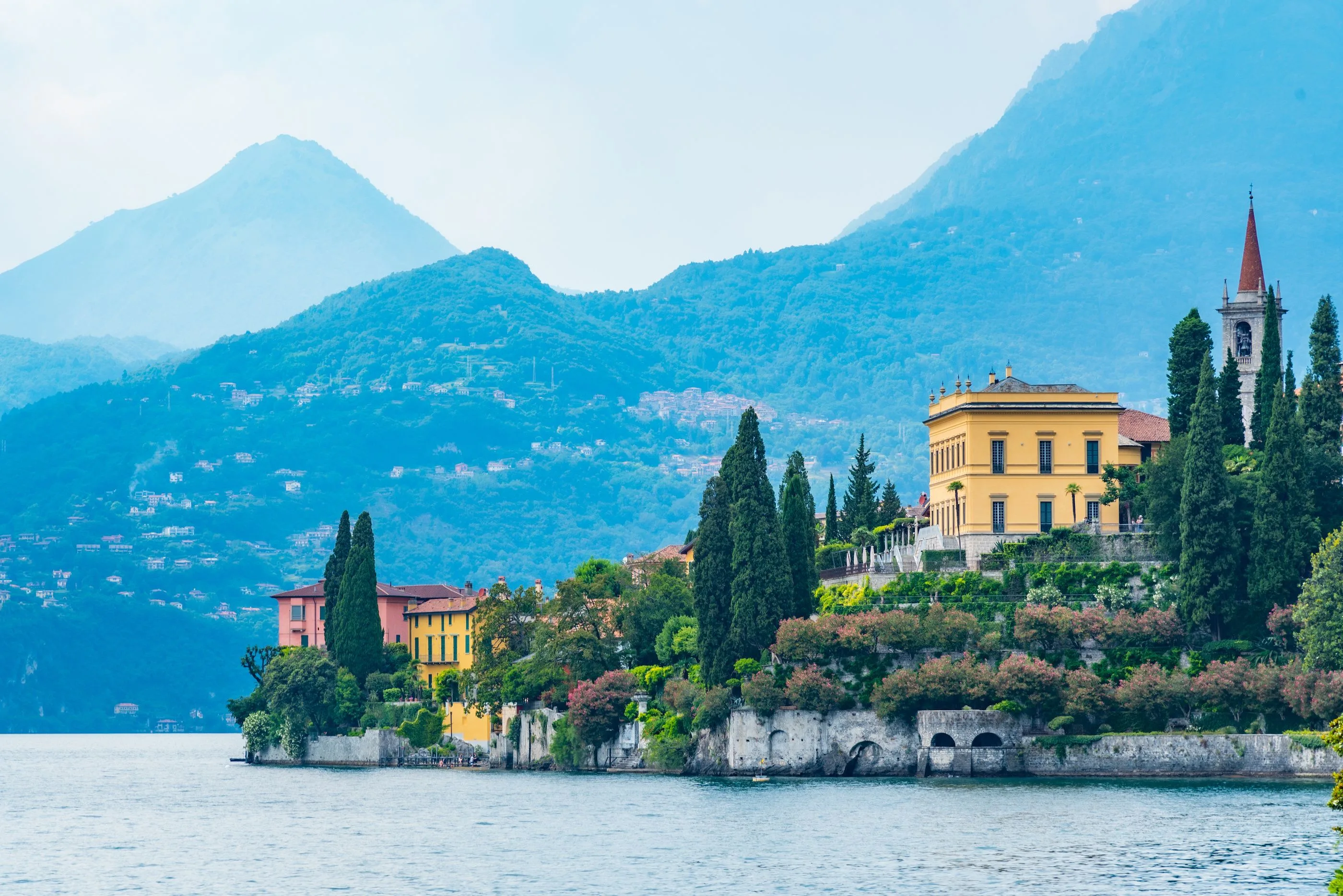
Villa Cipressi
 Highlight of Excursion to Lake Como
Highlight of Excursion to Lake ComoExplore the lush gardens surrounding this villa and enjoy stunning lake views from its terraces.
Just a short distance from Villa Monastero, you'll find the Villa Cirpressi, a grand villa built between the 15th and 19th century which offers great architectural elements of late Renaissance and fine Neoclassical features. Aside from the villa which is now a 4-star hotel, it is home to another manicured lakeside garden. Smaller in size, the centuries-old gardens are open to the public to visit, offering a journey of perfumes and magical sensations that go beyond a normal botanical garden. The terraced garden overlooking the lake deserves a visit, especially for anyone interested in nature.
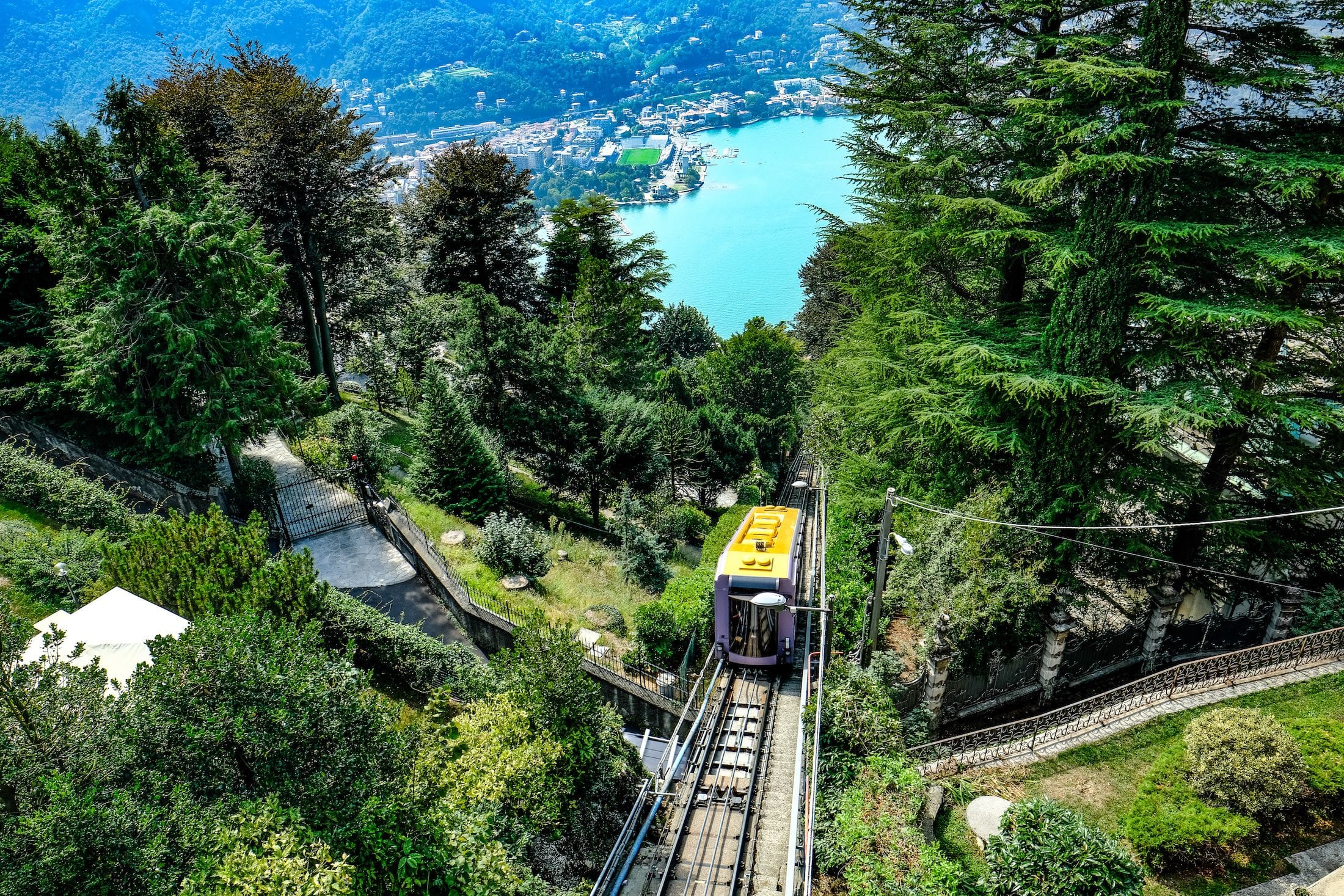
Lake Como Funicular
 Highlight of Excursion to Lake Como
Highlight of Excursion to Lake ComoRide a 19th Century funicular up the mountainside above Como to enjoy beautiful views over Lake Como.
Lake Como is surrounded by beautiful hills and mountains, and while it’s definitely possible to hike up the steep incline on foot, most people opt to ride on the Brunate Funicular, which brings riders to the small town of Brunate in just 7 minutes. The Funicular Railway has linked Lake Como and Brunate since 1894 and is still the quickest way of travelling between these two towns. A trip on the railway offers stunning views and an opportunity to see panoramic views of rural Como, all whilst having an enjoyable jaunt on a train!
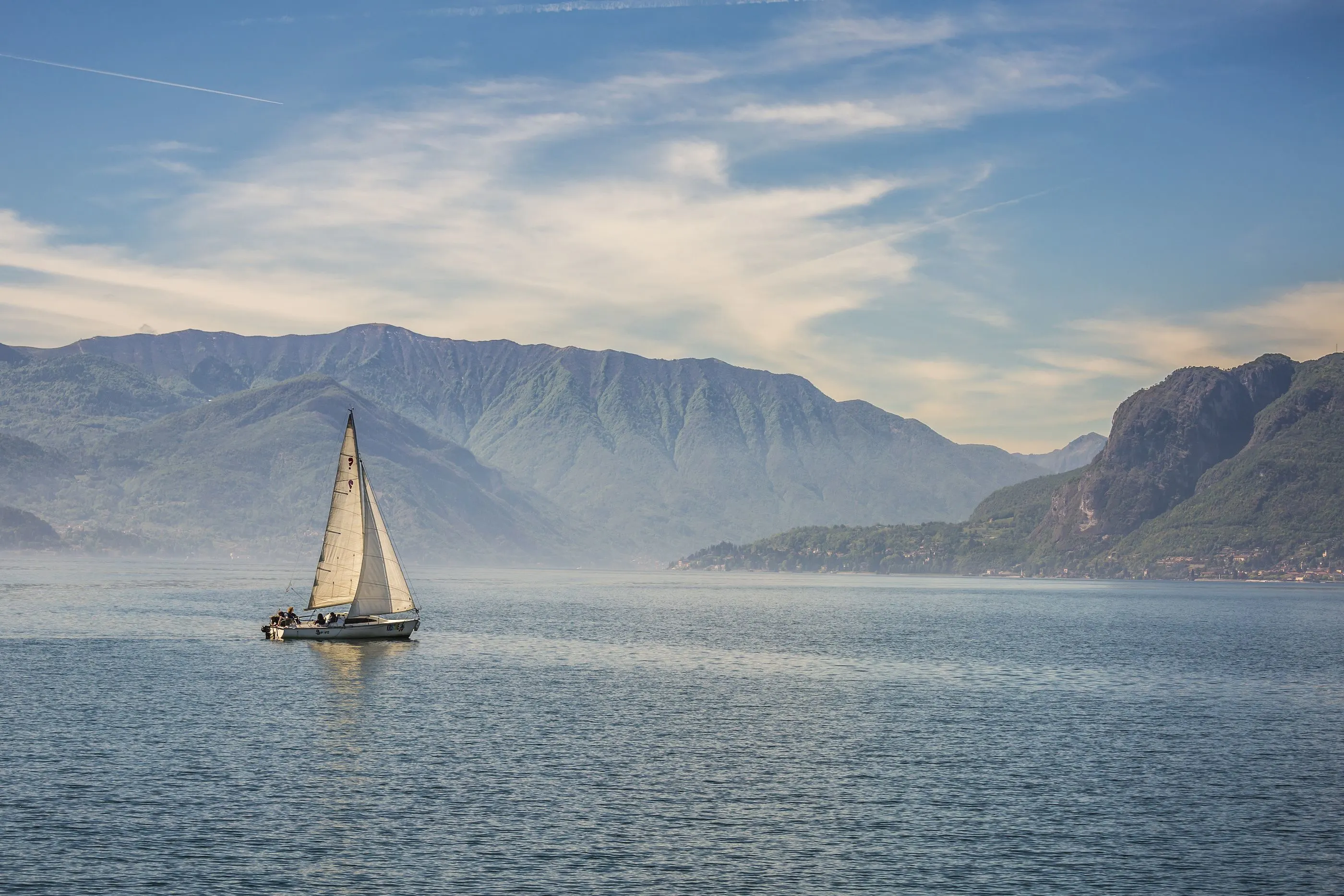
Cruise on Lake Como
 Highlight of Excursion to Lake Como
Highlight of Excursion to Lake ComoTake a liesurely private sail, enjoy a lake cruise, or villa hop by ferry.
One good way to combine a lake cruise with visits to the best villas and prettiest towns is to use the lake ferries. Just take the train from Milan to Varenna and then when you're done there, catch a ferry across the lake to Bellagio. From Bellagio you can take another ferry to Como, where you can catch a train back to Milan. If you go straight to Como, from April to October there are leisure boats offering 30-minute journeys along the nearby shoreline. With a high number of tourists, boats leave quite frequently and are very affordable at around 5 Euros per person. The better boats will point out sites of interest along the way, including spots where famous movies were filmed. If you want a truly special experience, you can also hire a private tour on a sail boat or small motor yacht. You'll feel like a real movie star as the you glide across the blue waters of the lake and wave to your fellow celebrities in the passing boats.
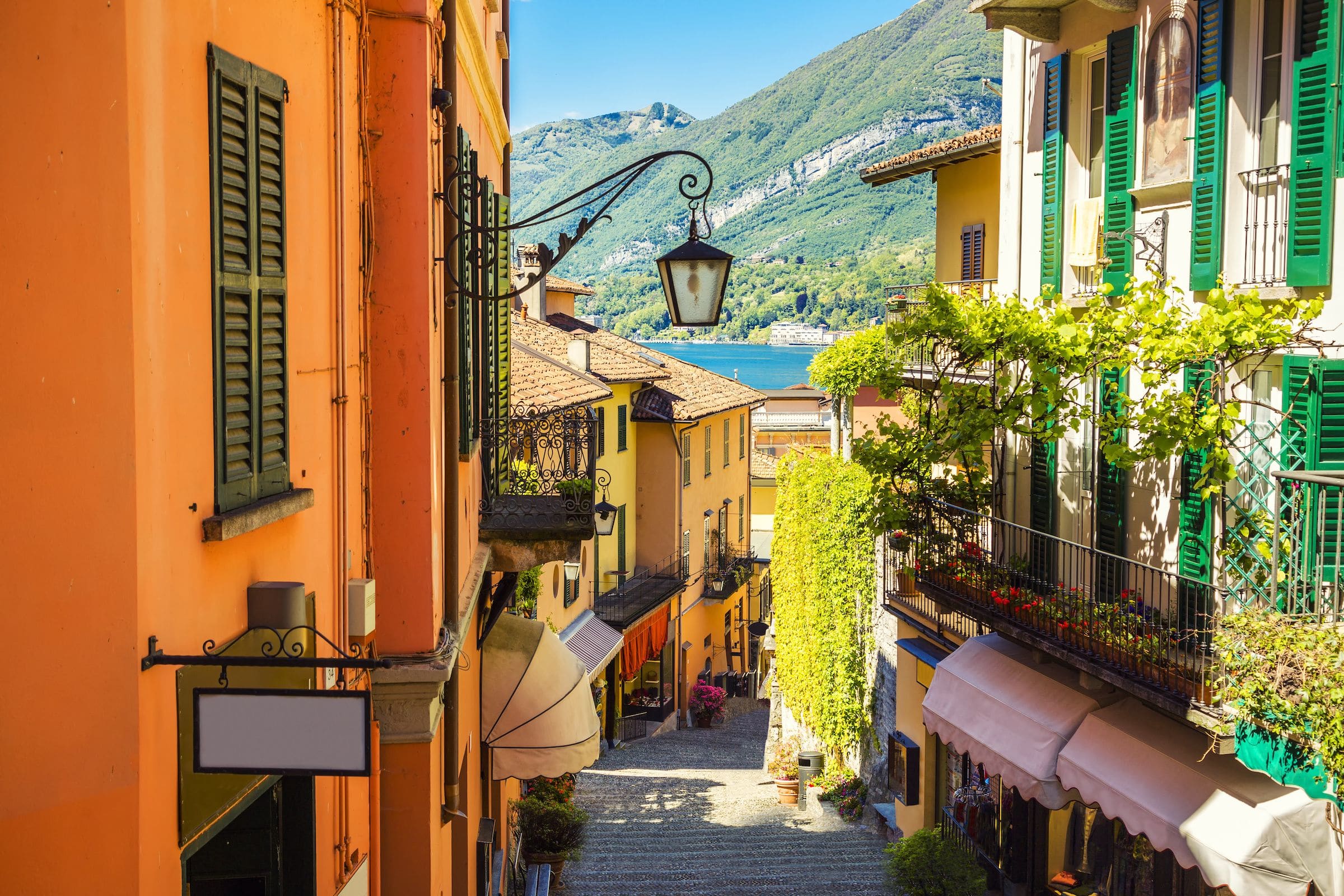
Bellagio
 Highlight of Excursion to Lake Como
Highlight of Excursion to Lake ComoVisit Lake Como's most famously beautiful lakeside town.
It is impossible not to be smitten by Bellagio's picturesque waterfront, bobbing boats and its maze of stone staircases, alleys, and cypress tree groves, and you may want to spend the most time during your day trip here. Bellagio has been a favored summertime resort since the Roman Times, and very little has changed, with Italians and tourists heading to the lakes for a cooler (but still incredibly warm) climate, away from the sweltering heat of the cities.
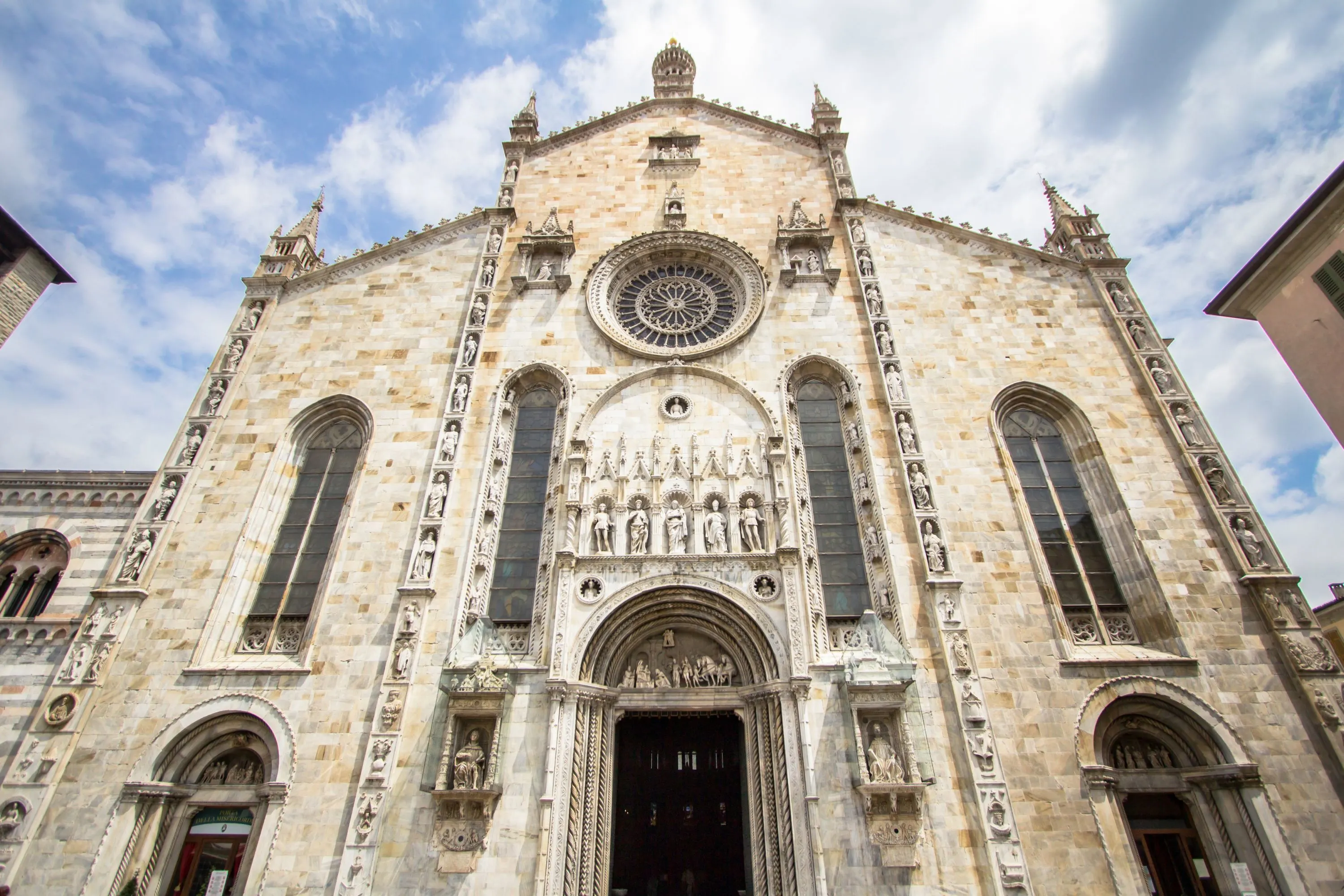
Cathedral of Como
 Highlight of Excursion to Lake Como
Highlight of Excursion to Lake ComoAdmire the wonderful details of this grand Duomo which incorporates architectural styles from across five centuries.
The imposing cathedral (Duomo) is located in the heart of Como's medieval walled city. Built between 1300 and 1744, the cathedral brings together elements of several architectural styles, including the late Gothic structure, the Renaissance facade, and the imposing Baroque dome. The front façade boasts an abundance of ornate stonework and stone statues, and is topped with a series of small decorative towers. The interior is also lavishly decorated. The standout feature is a central dome covered with gold artwork and other beautiful decor.

Villa Melzi
 Highlight of Excursion to Lake Como
Highlight of Excursion to Lake ComoWander through the magnificent lakeside gardens which surround this beautiful white villa in Bellagio.
The town of Bellagio was fought over in wars between Como and Milan, but most of the time, it has been a destination of pleasure and leisure since late Roman times. For this reason, Napoleon decided to reward one of his generals, Francesco Melzi, with the white neo-Classical Villa Melzi. Located to the south of the Bellagio, it is visited primarily for its spectacular gardens, embellished with ancient artefacts such as an Etruscan urn that dates back to the 3rd Century BC and two ancient Egyptian sculptures.
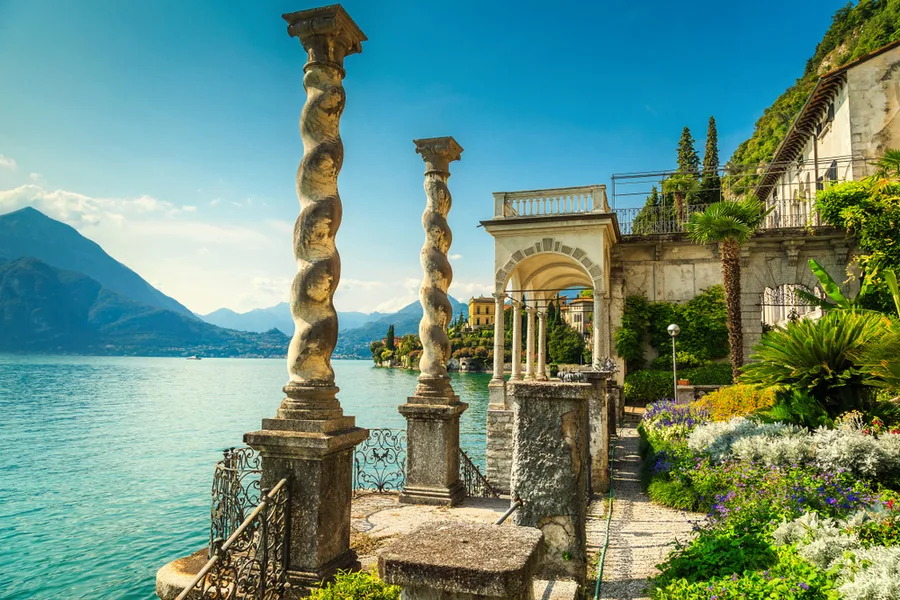
Villa Monastero
 Highlight of Excursion to Lake Como
Highlight of Excursion to Lake ComoVisit a villa that began as a peaceful lakeside convent and was later transformed into a luxurious residence.
Built-in various styles (Baroque, Classic and Moresque), the origins of the Villa Monastero in the town of Varenna stretch back to the 12th century, when it was founded as a Cistercian convent. The estate was purchased by Paolo Mornico in 1569, using his fortune amassed through iron mining. He then transformed it into a very elaborate aristocratic residence, while retaining some beautiful elements from the convent. These days the villa is now used as an international conference center and wedding venue. Luckily for visitors, the gardens are open to the public and there is also a House Museum, which features 14 lavish rooms filled with period furniture, refined decorations, and luxurious furnishings.

Villa Cipressi
 Highlight of Excursion to Lake Como
Highlight of Excursion to Lake ComoExplore the lush gardens surrounding this villa and enjoy stunning lake views from its terraces.
Just a short distance from Villa Monastero, you'll find the Villa Cirpressi, a grand villa built between the 15th and 19th century which offers great architectural elements of late Renaissance and fine Neoclassical features. Aside from the villa which is now a 4-star hotel, it is home to another manicured lakeside garden. Smaller in size, the centuries-old gardens are open to the public to visit, offering a journey of perfumes and magical sensations that go beyond a normal botanical garden. The terraced garden overlooking the lake deserves a visit, especially for anyone interested in nature.

Lake Como Funicular
 Highlight of Excursion to Lake Como
Highlight of Excursion to Lake ComoRide a 19th Century funicular up the mountainside above Como to enjoy beautiful views over Lake Como.
Lake Como is surrounded by beautiful hills and mountains, and while it’s definitely possible to hike up the steep incline on foot, most people opt to ride on the Brunate Funicular, which brings riders to the small town of Brunate in just 7 minutes. The Funicular Railway has linked Lake Como and Brunate since 1894 and is still the quickest way of travelling between these two towns. A trip on the railway offers stunning views and an opportunity to see panoramic views of rural Como, all whilst having an enjoyable jaunt on a train!

Cruise on Lake Como
 Highlight of Excursion to Lake Como
Highlight of Excursion to Lake ComoTake a liesurely private sail, enjoy a lake cruise, or villa hop by ferry.
One good way to combine a lake cruise with visits to the best villas and prettiest towns is to use the lake ferries. Just take the train from Milan to Varenna and then when you're done there, catch a ferry across the lake to Bellagio. From Bellagio you can take another ferry to Como, where you can catch a train back to Milan. If you go straight to Como, from April to October there are leisure boats offering 30-minute journeys along the nearby shoreline. With a high number of tourists, boats leave quite frequently and are very affordable at around 5 Euros per person. The better boats will point out sites of interest along the way, including spots where famous movies were filmed. If you want a truly special experience, you can also hire a private tour on a sail boat or small motor yacht. You'll feel like a real movie star as the you glide across the blue waters of the lake and wave to your fellow celebrities in the passing boats.

Bellagio
 Highlight of Excursion to Lake Como
Highlight of Excursion to Lake ComoVisit Lake Como's most famously beautiful lakeside town.
It is impossible not to be smitten by Bellagio's picturesque waterfront, bobbing boats and its maze of stone staircases, alleys, and cypress tree groves, and you may want to spend the most time during your day trip here. Bellagio has been a favored summertime resort since the Roman Times, and very little has changed, with Italians and tourists heading to the lakes for a cooler (but still incredibly warm) climate, away from the sweltering heat of the cities.

Cathedral of Como
 Highlight of Excursion to Lake Como
Highlight of Excursion to Lake ComoAdmire the wonderful details of this grand Duomo which incorporates architectural styles from across five centuries.
The imposing cathedral (Duomo) is located in the heart of Como's medieval walled city. Built between 1300 and 1744, the cathedral brings together elements of several architectural styles, including the late Gothic structure, the Renaissance facade, and the imposing Baroque dome. The front façade boasts an abundance of ornate stonework and stone statues, and is topped with a series of small decorative towers. The interior is also lavishly decorated. The standout feature is a central dome covered with gold artwork and other beautiful decor.

Villa Melzi
 Highlight of Excursion to Lake Como
Highlight of Excursion to Lake ComoWander through the magnificent lakeside gardens which surround this beautiful white villa in Bellagio.
The town of Bellagio was fought over in wars between Como and Milan, but most of the time, it has been a destination of pleasure and leisure since late Roman times. For this reason, Napoleon decided to reward one of his generals, Francesco Melzi, with the white neo-Classical Villa Melzi. Located to the south of the Bellagio, it is visited primarily for its spectacular gardens, embellished with ancient artefacts such as an Etruscan urn that dates back to the 3rd Century BC and two ancient Egyptian sculptures.

Villa Monastero
 Highlight of Excursion to Lake Como
Highlight of Excursion to Lake ComoVisit a villa that began as a peaceful lakeside convent and was later transformed into a luxurious residence.
Built-in various styles (Baroque, Classic and Moresque), the origins of the Villa Monastero in the town of Varenna stretch back to the 12th century, when it was founded as a Cistercian convent. The estate was purchased by Paolo Mornico in 1569, using his fortune amassed through iron mining. He then transformed it into a very elaborate aristocratic residence, while retaining some beautiful elements from the convent. These days the villa is now used as an international conference center and wedding venue. Luckily for visitors, the gardens are open to the public and there is also a House Museum, which features 14 lavish rooms filled with period furniture, refined decorations, and luxurious furnishings.

Villa Cipressi
 Highlight of Excursion to Lake Como
Highlight of Excursion to Lake ComoExplore the lush gardens surrounding this villa and enjoy stunning lake views from its terraces.
Just a short distance from Villa Monastero, you'll find the Villa Cirpressi, a grand villa built between the 15th and 19th century which offers great architectural elements of late Renaissance and fine Neoclassical features. Aside from the villa which is now a 4-star hotel, it is home to another manicured lakeside garden. Smaller in size, the centuries-old gardens are open to the public to visit, offering a journey of perfumes and magical sensations that go beyond a normal botanical garden. The terraced garden overlooking the lake deserves a visit, especially for anyone interested in nature.
prev
next


Day 21
Depart Milan
View More
Day 21
Depart Milan

To Be Determined
Private Transfer to Milan Malpensa Airport
A car service will pick you up from the N/A and deliver you to Milan Malpensa Airport for your flight departure. This is a private transfer just for your travel party, and you will not need to pay the driver for the transfer, as it is already included in the cost of the itinerary. IMPORTANT NOTE: Please be aware the car service can fit up to 1 checked item of luggage and 1 personal item per person, such as a purse or small backpack. If you think you will have more baggage, please inform your travel consultant as this may result in an additional fee.

Day 21
Depart Milan
View More


What's Included In Your Trip

Pre-Paid Tours and Activities:
- 'First Walk' Guided Tour in Venice
- Half Day Excursion to San Gimignano and lunch stop at a local vineyard
- Tuscan Cuisine Cooking Class
- Heart of the Empire - Private Tour of Ancient Rome & the Colosseum
- Twilight Trastevere Group Food Tour
- Guided Vatican Tour including the Sistine Chapel
- Best of Milan Private Walking Tour
- Cultural Culinary Guided Walk in Milan
- City Cards for Rome and Cinque Terre, including discounts to many popular attractions

Pre-Paid Transportation:
- 2nd Class Train Tickets from Venice-Florence
- 2nd Class Train Tickets from Florence to Roma Termini-Fiumicino
- 2nd Class Train Tickets from Rome to LaSpezia
- 2nd Class Train Tickets from La Spezia Centrale -Milan
- Public Transport Tickets for Venice, Rome, and Cinque Terre
- Private Transfer from Rome Termini Rail Station
- Private Transfer to Rome Termini Train Station
- Private Transfer to Milan Malpensa Airport

Accommodation:
- 5 nights at a hotel of your choice in Venice
- 5 nights at a hotel of your choice in Florence
- 6 nights at a hotel of your choice in Rome
- 4 nights at a hotel of your choice in Cinque Terre
- 5 nights at a hotel of your choice in Milan

Go Real Travel Mobile App:
- Itinerary Plan & Reservations Info
- Points of Interest
- Detailed Travel Information
- Maps & Directions
Other Trips You May Like

7 Days
From$2139USD
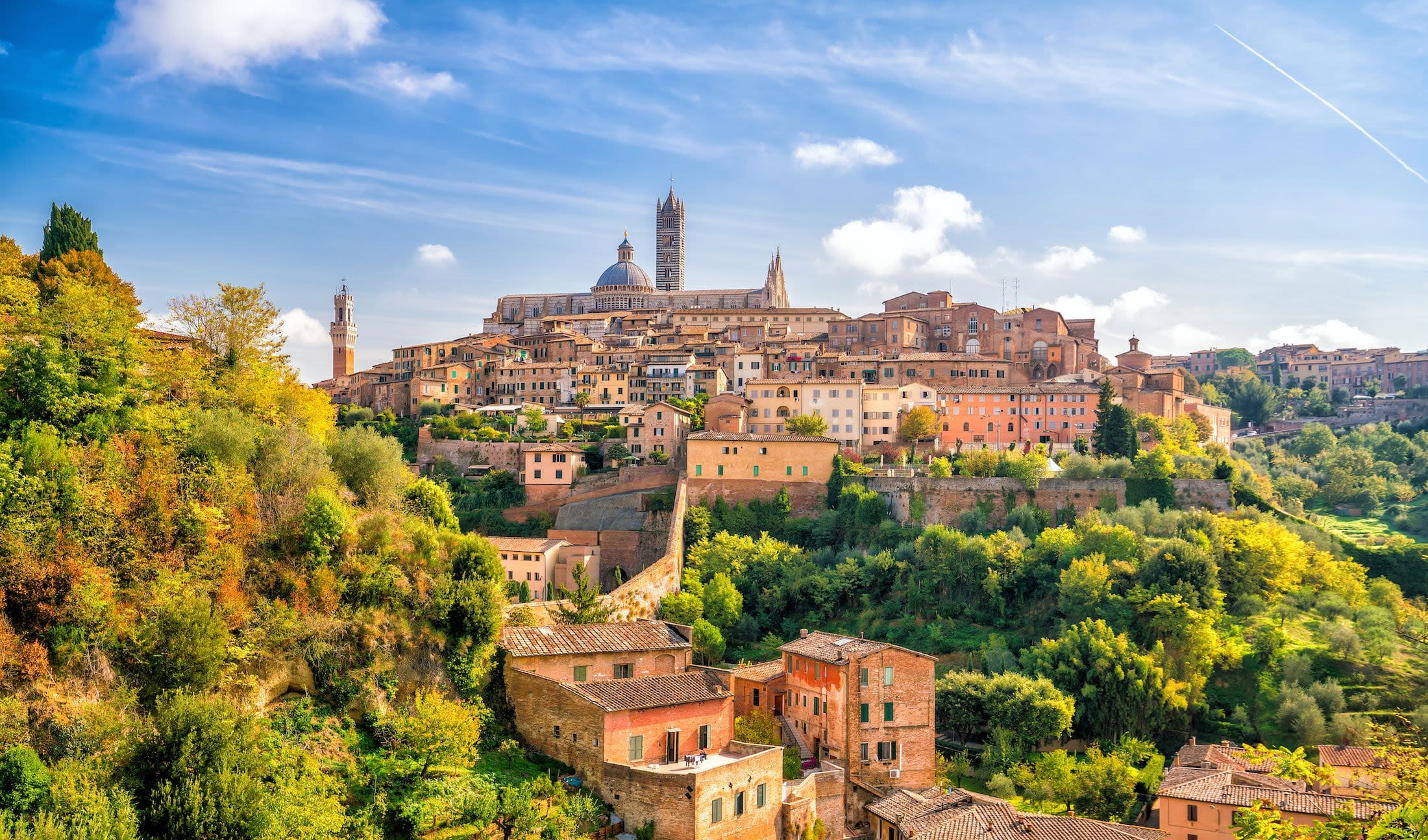
14 Days
From$3559USD

10 Days
From$4033USD
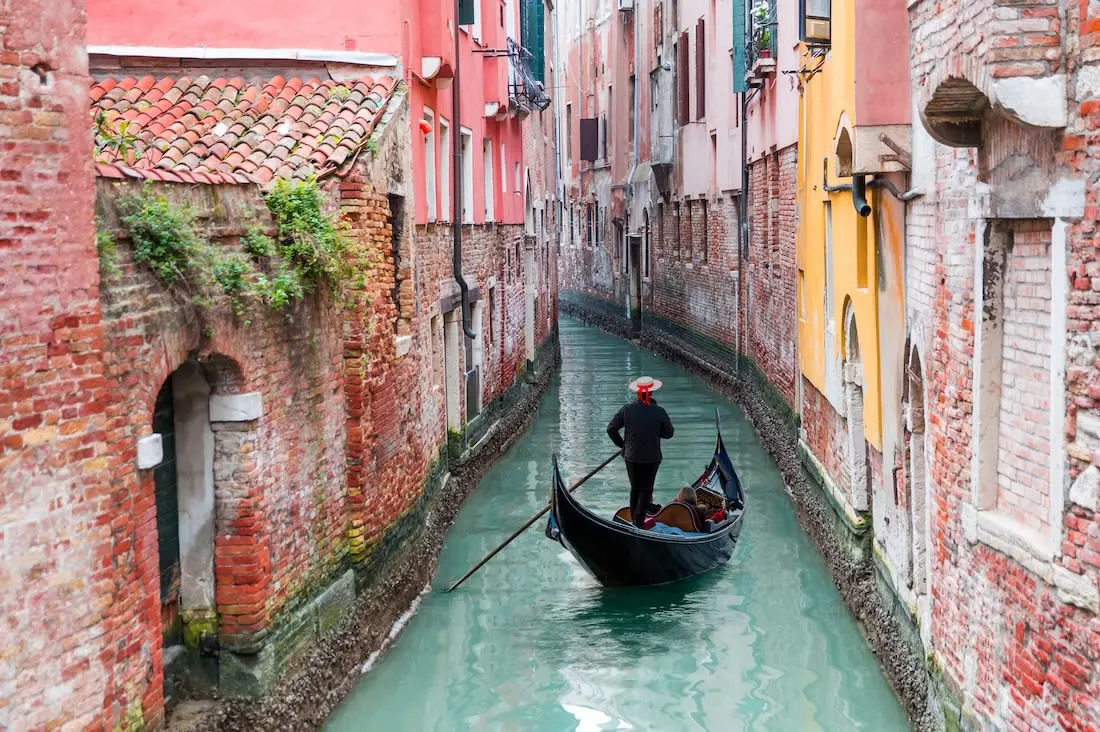
8 Days
From$2424USD

12 Days
From$3175USD
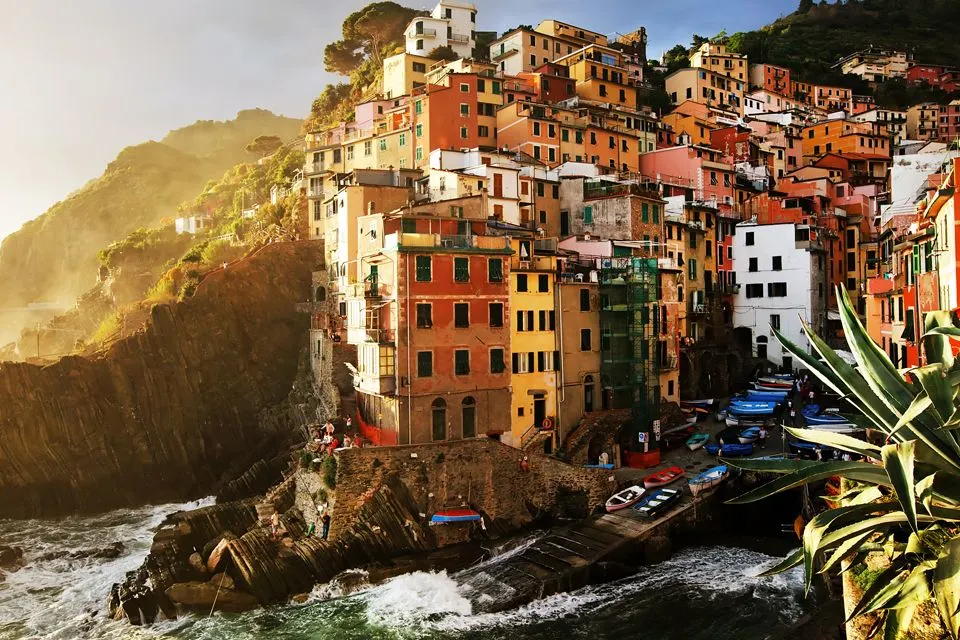
10 Days
From$4600USD

12 Days
From$2999USD

15 Days
From$4266USD

14 Days
From$3847USD

7 Days
From$2139USD

14 Days
From$3559USD

10 Days
From$4033USD

8 Days
From$2424USD

12 Days
From$3175USD

10 Days
From$4600USD

12 Days
From$2999USD

15 Days
From$4266USD

14 Days
From$3847USD
prev
next
Featured Blogs
prev
next
Our Customers Say It Best
Otto Chuy, Los Angeles, California
I am still surprised how everything worked as planned, without a hitch. All instructions in your itinerary were precise and correct. Your suggestions and comments in each of the locations we went to were very helpful. All your guides, without exception, were wonderful and exactly on time. 

Kathy Mongeau, Ottawa, Ontario
My sister, Ann Ibberson, and I have been back home for a few weeks now and still go on and on about our fabulous trip. We were just blown away in every respect. Given the fact that we only had 1 ½ weeks, you had everything arranged for us so efficiently and your contacts who we dealt with for transfers, tours, hotels were extremely professional and personable. Things could not have gone better. 

Clive Andrew, Brisbane, Queensland
Just a quick note to let you know that I am back home now after probably the best overseas holiday that I have ever had, in no small part due to your very capable organization booking of hotels, tours, & trains. There was just nothing that went wrong with the timings etc. 

Malini Dutta, Boston, Massachusetts
We can't thank you enough for the detailed plans, maps, and suggestions. It really felt that someone was holding our hands and showing us around. We had all the excitement of discovering foreign lands, with none of the problems that can happen while negotiating unfamiliar places. In fact, all the cities felt like home within a few hours of arriving and exploring. 

Bev and Mark Frankel, Williamsburg, Virginia
We could not be more pleased with Go Real Travel! You took the guess work out of things like public transport but still managed to allow us the freedom to tour as we wanted. Our guides were exceptional and every time I saw a Viking Cruise tour of 25 people, I realized the quality experience we were getting with Go Real. 

Marianne Strydom, Paarl, South Africa
I just wanted to thank you for organizing an amazing trip for me – I packed in so much in such a short period of time and everything was just perfect. The way you do things makes it possible to really get to know the destination, which for me as a travel agent could not have been better. 

Otto Chuy, Los Angeles, California
I am still surprised how everything worked as planned, without a hitch. All instructions in your itinerary were precise and correct. Your suggestions and comments in each of the locations we went to were very helpful. All your guides, without exception, were wonderful and exactly on time. 

Kathy Mongeau, Ottawa, Ontario
My sister, Ann Ibberson, and I have been back home for a few weeks now and still go on and on about our fabulous trip. We were just blown away in every respect. Given the fact that we only had 1 ½ weeks, you had everything arranged for us so efficiently and your contacts who we dealt with for transfers, tours, hotels were extremely professional and personable. Things could not have gone better. 

Clive Andrew, Brisbane, Queensland
Just a quick note to let you know that I am back home now after probably the best overseas holiday that I have ever had, in no small part due to your very capable organization booking of hotels, tours, & trains. There was just nothing that went wrong with the timings etc. 

Malini Dutta, Boston, Massachusetts
We can't thank you enough for the detailed plans, maps, and suggestions. It really felt that someone was holding our hands and showing us around. We had all the excitement of discovering foreign lands, with none of the problems that can happen while negotiating unfamiliar places. In fact, all the cities felt like home within a few hours of arriving and exploring. 

Bev and Mark Frankel, Williamsburg, Virginia
We could not be more pleased with Go Real Travel! You took the guess work out of things like public transport but still managed to allow us the freedom to tour as we wanted. Our guides were exceptional and every time I saw a Viking Cruise tour of 25 people, I realized the quality experience we were getting with Go Real. 

Marianne Strydom, Paarl, South Africa
I just wanted to thank you for organizing an amazing trip for me – I packed in so much in such a short period of time and everything was just perfect. The way you do things makes it possible to really get to know the destination, which for me as a travel agent could not have been better. 



Explore cities in more detail

Cinque Terre
Cinque Terre, a string of five fishing villages in the Liguria region of Italy, is a rare snapshot of a traditional way of life. Rustic and charming, these clusters of pastel houses clinging to steep Mediterranean cliffs hold a special allure. Hiking between the five villages is a popular way to experience the rugged Mediterranean landscape close up. There are no roads here — the only other way to get between the villages is by boat or train. Seafood, hauled in from the azure waters of the sea that laps against the rocky shore, is abundant and delicious here. It pairs well with the local wine, and perhaps a plate of olives. Cinque Terre is a place to take it slow, to breathe in the fresh sea air and bask in the balmy climate, many miles from the chaos and frenzy of the modern world.
Read More
Learn About Cinque Terre
Build Cinque Terre Trip
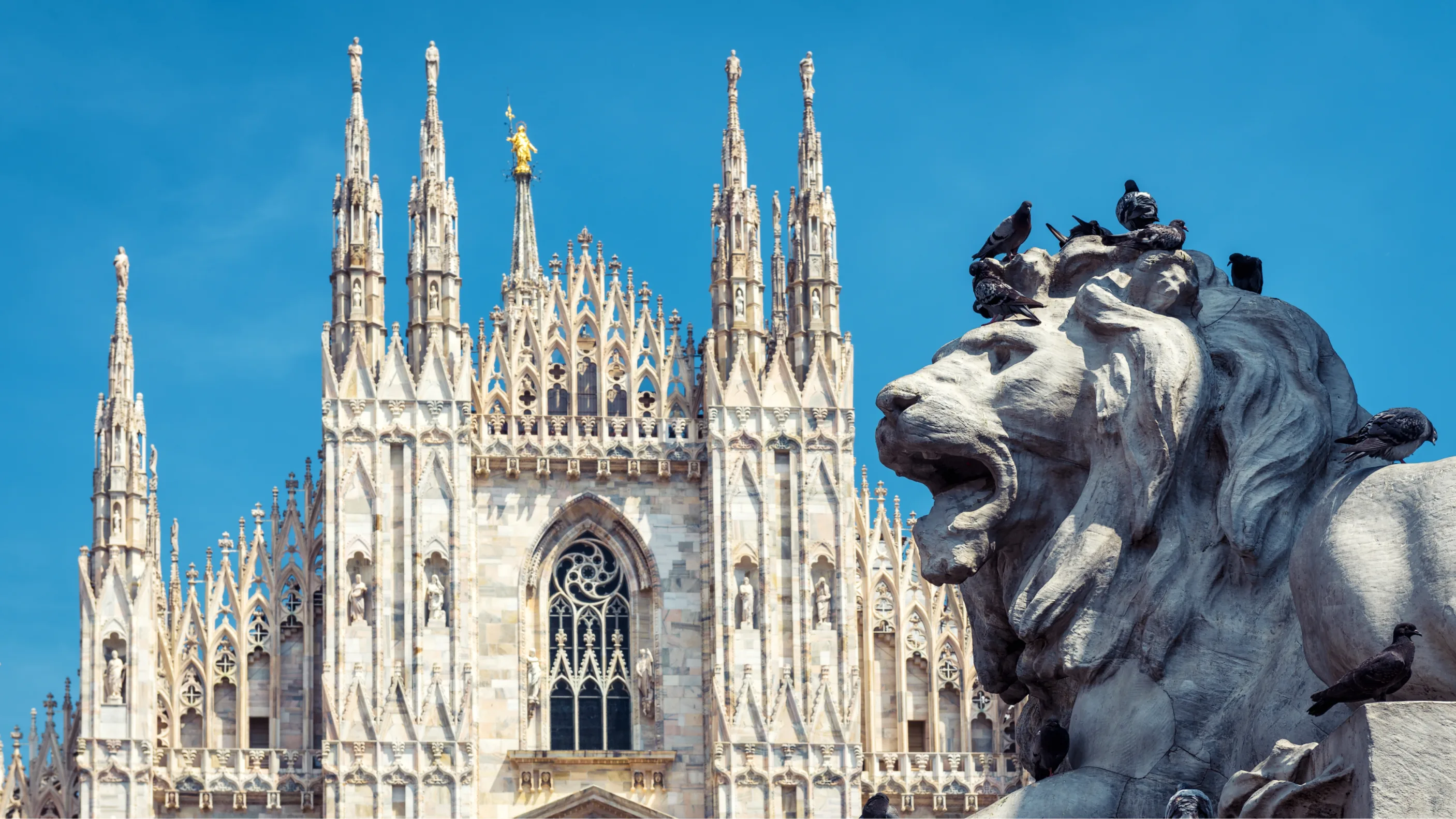
Milan
Milan is Italy’s most forward-looking city. An international center for fashion, fine dining, and design, it seems as though Milanese people breathe style. From the gleam on your wine glass to the twists of its cathedral’s spires, everything in Milan is finished to perfection. Home to the Italian stock exchange, a world-famous fashion industry, and a frantic business district, Milan is fast-paced and commercially minded. The shopping in Milan is second to none. At the Galleria Vittorio Emanuele II, one of the world’s oldest shopping malls, a glass-iron ceiling soars over brands like Louis Vuitton, Gucci, Massimo Dutti, and Amani. Along with the fashion, Milan’s cathedral, castle, and canals are also must-sees. But to view the city’s most prized possession - Leonardo da Vinci’s Last Supper, you must make an appointment. Tickets to view this mural sell out weeks in advance. It is truly a bucket-list worthy work of art. After a day taking in all the glamor and culture, take a seat in one of Milan’s well-appointed eateries. The Navigli Quarter is packed with restaurants, bars, and cafes, perfect for a relaxed Aperol spritz or pizza along the city’s canals.
Read More
Learn About Milan
Build Milan Trip
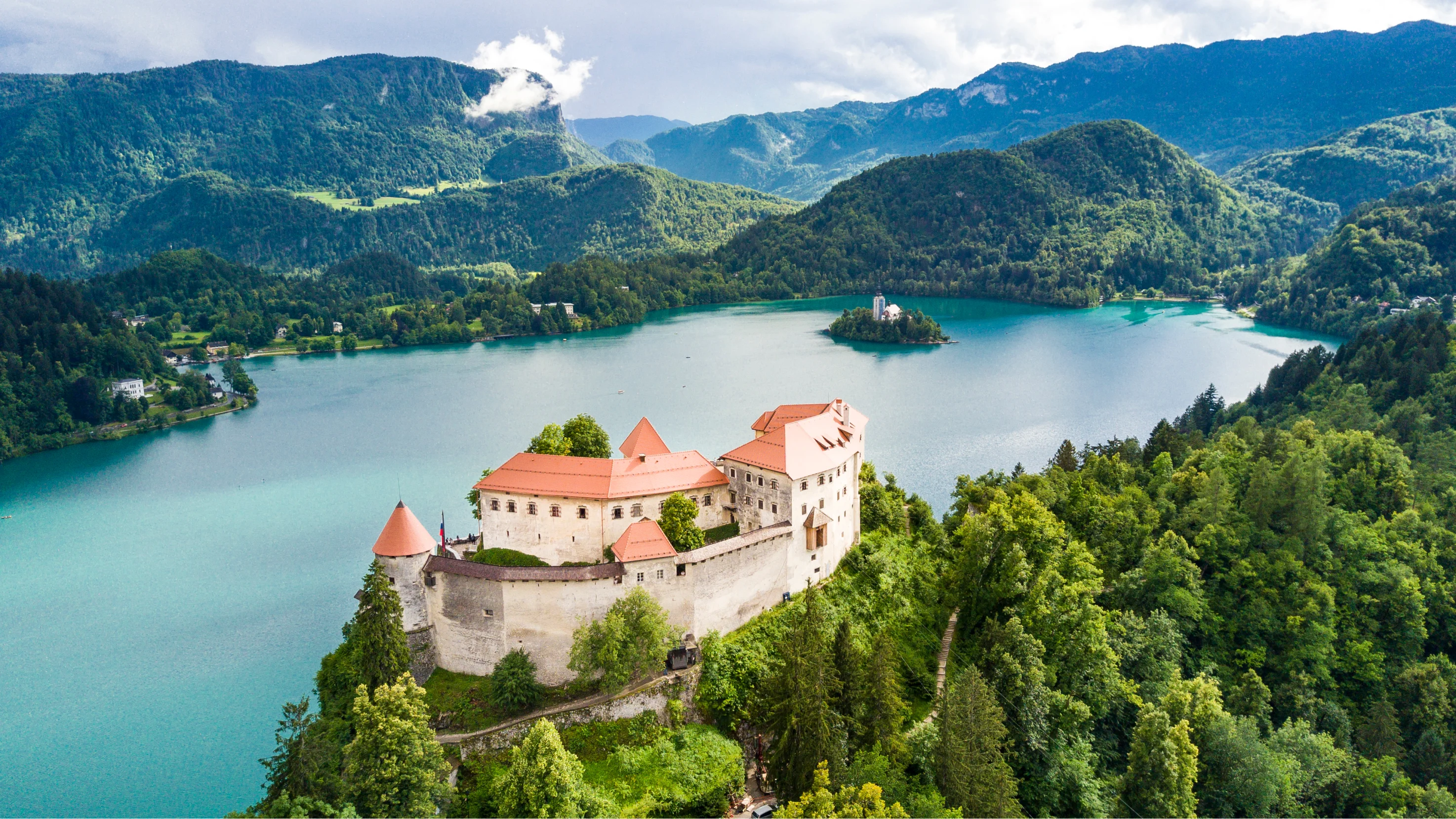
Ljubljana
One of Europe's smallest capitals, Ljubljana is still Slovenia's biggest city. What it lacks in size, though, it more than makes up for in charm, beauty, and personality. It's also one of Europe's greenest cities and is perfect for a bike ride or a leisurely walk. With plenty of open spaces, gorgeous architecture, and cultural treats, it's easy to fill the time here. The Tromostovje, or Triple Bridge, is one of Ljubljana's main attractions, connecting the Old Town with the new. Excellent pizza can be found here, and a series of bars and cafes are dotted throughout the town and along the banks of the river. The anarchic Metelkova City reveals Ljubljana's grittier side, with art exhibitions and performances housed in a disused military barracks. Ljubljana is charm and beauty compressed neatly into a small and pretty space.
Read More
Learn About Ljubljana
Build Ljubljana Trip
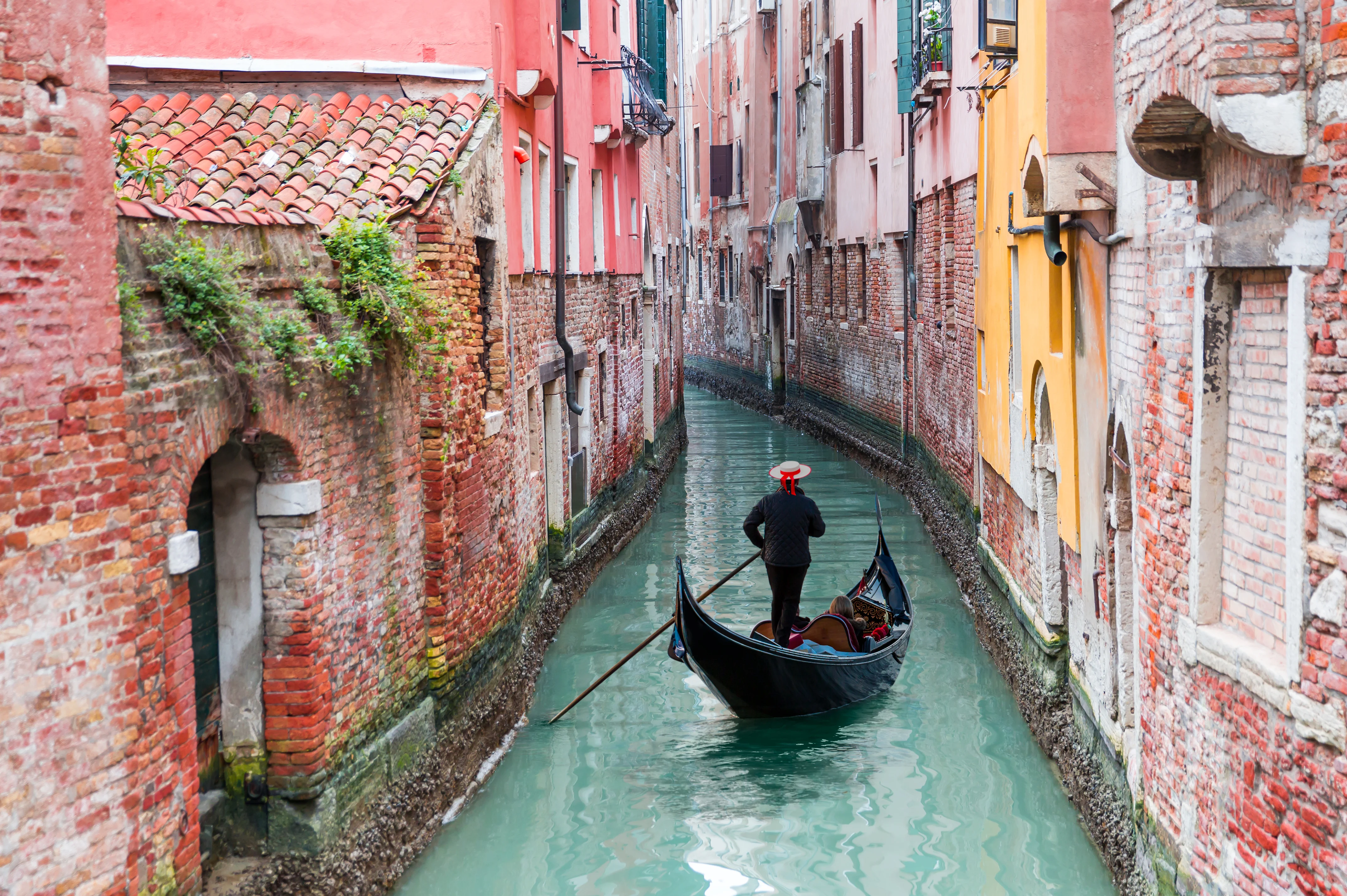
Venice
Venice is a city with no equal. Built on a series of islands on a lagoon, it was once a powerful city-state. Echoes of that old magnificence can be seen everywhere here, from the stunning buildings that rise out of the canals, to the bridges that arc across them. Take a Gondola ride through the canals that form the city’s veins, or wander through the winding streets drinking in the sights. You’ll see Venice attracts tourists in huge numbers, and that’s with good reason. It’s home to a seemingly limitless amount of art, culture, history, and architecture. St Mark’s Basilica, the Doge’s Palace, and the Campanile di San Marco just barely scratch the surface. There’s a 700-year-old market, Rialto, which is still open today. The Ponte di Rialto bridge connects the neighborhoods of San Marco and San Polo, stretching across the Grand Canal. Venice has weathered the last several centuries with elegance and pride, a place that will surpass even your highest expectations.
Read More
Learn About Venice
Build Venice Trip
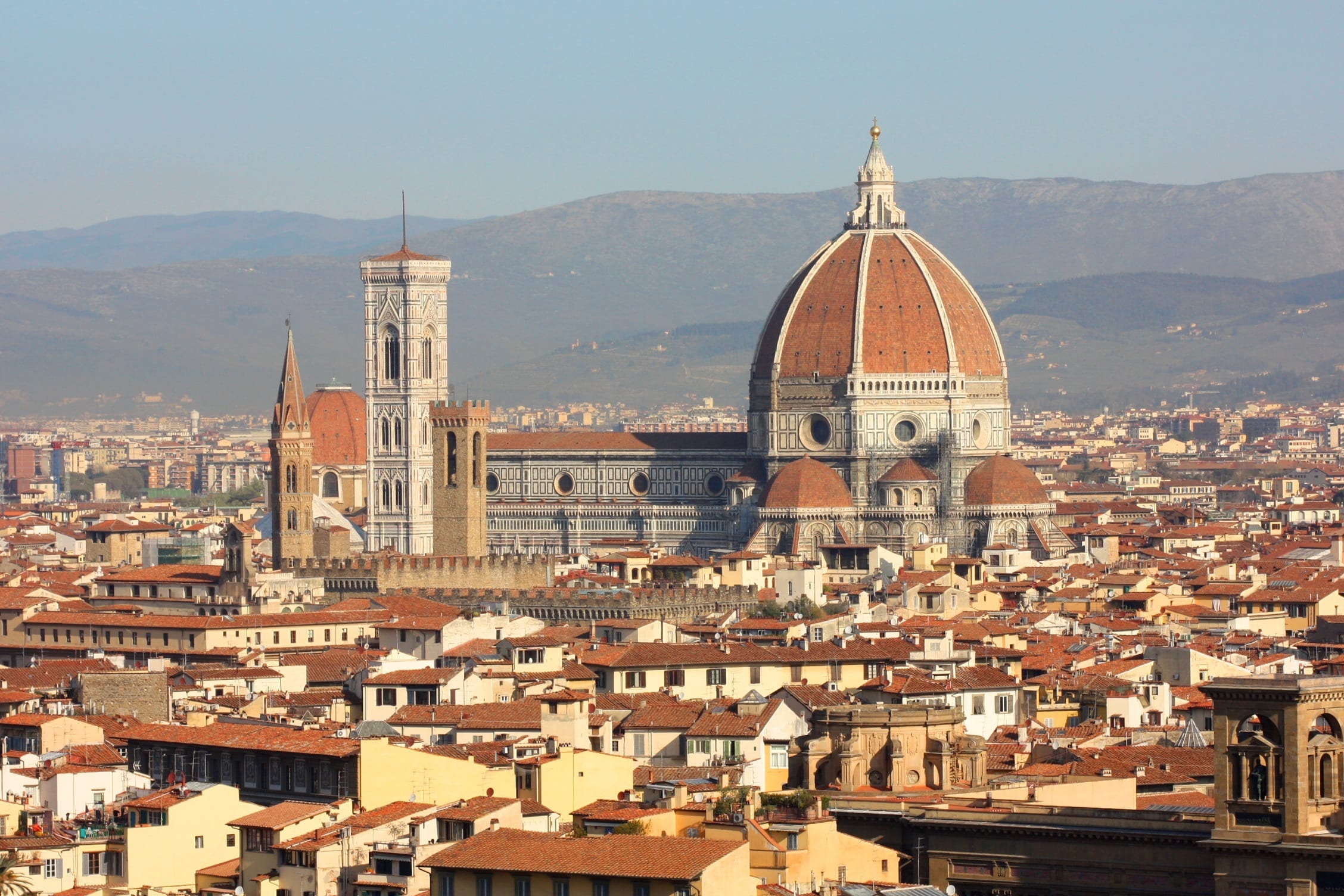
Florence
Culture and history are thick in the air in Florence. Located on the banks of the Arno River in Tuscany, Florence’s past is deeply compelling. The birthplace of the Renaissance, Florence is where innovators like Dante, Machiavelli, Michelangelo, and Da Vinci made their fortunes. Centuries of art, politics, and commerce have left their mark on every stone in this Northern Italian city. In the 15th and 16th centuries, Florentine banks funded new enterprises that went on to change the history of the world. Powerful families like the Medici’s financed some of the finest art in history and pioneered new ways of doing statecraft and politics. As you stand in the Piazzale Michelangelo and gaze upon the city below it’s hard to take it all in at once. It feels like behind every door in Florence might hide a work of genius. Michelangelo’s David and Botticelli’s Primavera can be found just a short walk away. After a long day wandering the streets and gazing at art, fueled by exquisite coffee and gelato, relax like the locals do: with a glass of some of the best wine in the world.
Read More
Learn About Florence
Build Florence Trip
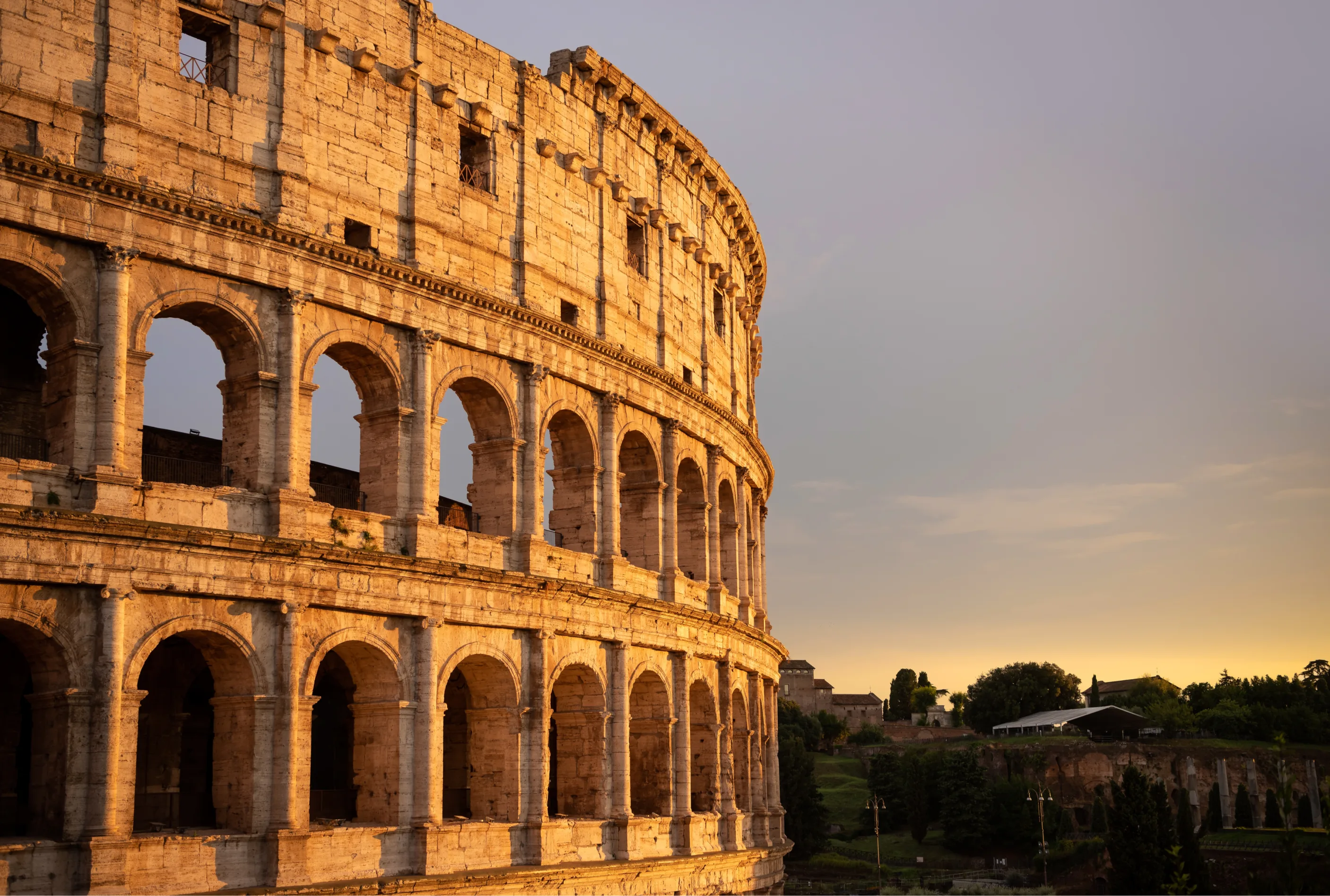
Rome
One of the must-sees of Italy, and indeed all of Europe, Rome is a city with history flowing through its veins. There is an endless amount to see, do, and learn here, with something for every taste and disposition. Rome was the center of Western civilization for a Millenium and during that time, accumulated a list of historical and cultural treasures that no other destination can truly match. The Pantheon, Colosseum, Roman Forum, and Cirus of Maxentius are just a few examples of what can be seen and experienced in Rome, which at times feels more like a giant outdoor museum than a city. At Rome’s heart, you’ll find the Vatican, home of the Roman Catholic Church and the Pope. Here visitors can see the legendary Sistine Chapel. Transcending a mere building, the chapel is a walk-in work of art. Although historical sights can be found on just about every corner, it’s entirely possible to fill a day just wandering around Rome. The city’s charming streets and open Piazzas are filled with beautiful sights and places to sit, grab the best Cappuccino in the world, and enjoy the view.
Read More
Learn About Rome
Build Rome Trip

Cinque Terre
Cinque Terre, a string of five fishing villages in the Liguria region of Italy, is a rare snapshot of a traditional way of life. Rustic and charming, these clusters of pastel houses clinging to steep Mediterranean cliffs hold a special allure. Hiking between the five villages is a popular way to experience the rugged Mediterranean landscape close up. There are no roads here — the only other way to get between the villages is by boat or train. Seafood, hauled in from the azure waters of the sea that laps against the rocky shore, is abundant and delicious here. It pairs well with the local wine, and perhaps a plate of olives. Cinque Terre is a place to take it slow, to breathe in the fresh sea air and bask in the balmy climate, many miles from the chaos and frenzy of the modern world.
Read More
Learn About Cinque Terre
Build Cinque Terre Trip

Milan
Milan is Italy’s most forward-looking city. An international center for fashion, fine dining, and design, it seems as though Milanese people breathe style. From the gleam on your wine glass to the twists of its cathedral’s spires, everything in Milan is finished to perfection. Home to the Italian stock exchange, a world-famous fashion industry, and a frantic business district, Milan is fast-paced and commercially minded. The shopping in Milan is second to none. At the Galleria Vittorio Emanuele II, one of the world’s oldest shopping malls, a glass-iron ceiling soars over brands like Louis Vuitton, Gucci, Massimo Dutti, and Amani. Along with the fashion, Milan’s cathedral, castle, and canals are also must-sees. But to view the city’s most prized possession - Leonardo da Vinci’s Last Supper, you must make an appointment. Tickets to view this mural sell out weeks in advance. It is truly a bucket-list worthy work of art. After a day taking in all the glamor and culture, take a seat in one of Milan’s well-appointed eateries. The Navigli Quarter is packed with restaurants, bars, and cafes, perfect for a relaxed Aperol spritz or pizza along the city’s canals.
Read More
Learn About Milan
Build Milan Trip

Ljubljana
One of Europe's smallest capitals, Ljubljana is still Slovenia's biggest city. What it lacks in size, though, it more than makes up for in charm, beauty, and personality. It's also one of Europe's greenest cities and is perfect for a bike ride or a leisurely walk. With plenty of open spaces, gorgeous architecture, and cultural treats, it's easy to fill the time here. The Tromostovje, or Triple Bridge, is one of Ljubljana's main attractions, connecting the Old Town with the new. Excellent pizza can be found here, and a series of bars and cafes are dotted throughout the town and along the banks of the river. The anarchic Metelkova City reveals Ljubljana's grittier side, with art exhibitions and performances housed in a disused military barracks. Ljubljana is charm and beauty compressed neatly into a small and pretty space.
Read More
Learn About Ljubljana
Build Ljubljana Trip

Venice
Venice is a city with no equal. Built on a series of islands on a lagoon, it was once a powerful city-state. Echoes of that old magnificence can be seen everywhere here, from the stunning buildings that rise out of the canals, to the bridges that arc across them. Take a Gondola ride through the canals that form the city’s veins, or wander through the winding streets drinking in the sights. You’ll see Venice attracts tourists in huge numbers, and that’s with good reason. It’s home to a seemingly limitless amount of art, culture, history, and architecture. St Mark’s Basilica, the Doge’s Palace, and the Campanile di San Marco just barely scratch the surface. There’s a 700-year-old market, Rialto, which is still open today. The Ponte di Rialto bridge connects the neighborhoods of San Marco and San Polo, stretching across the Grand Canal. Venice has weathered the last several centuries with elegance and pride, a place that will surpass even your highest expectations.
Read More
Learn About Venice
Build Venice Trip

Florence
Culture and history are thick in the air in Florence. Located on the banks of the Arno River in Tuscany, Florence’s past is deeply compelling. The birthplace of the Renaissance, Florence is where innovators like Dante, Machiavelli, Michelangelo, and Da Vinci made their fortunes. Centuries of art, politics, and commerce have left their mark on every stone in this Northern Italian city. In the 15th and 16th centuries, Florentine banks funded new enterprises that went on to change the history of the world. Powerful families like the Medici’s financed some of the finest art in history and pioneered new ways of doing statecraft and politics. As you stand in the Piazzale Michelangelo and gaze upon the city below it’s hard to take it all in at once. It feels like behind every door in Florence might hide a work of genius. Michelangelo’s David and Botticelli’s Primavera can be found just a short walk away. After a long day wandering the streets and gazing at art, fueled by exquisite coffee and gelato, relax like the locals do: with a glass of some of the best wine in the world.
Read More
Learn About Florence
Build Florence Trip

Rome
One of the must-sees of Italy, and indeed all of Europe, Rome is a city with history flowing through its veins. There is an endless amount to see, do, and learn here, with something for every taste and disposition. Rome was the center of Western civilization for a Millenium and during that time, accumulated a list of historical and cultural treasures that no other destination can truly match. The Pantheon, Colosseum, Roman Forum, and Cirus of Maxentius are just a few examples of what can be seen and experienced in Rome, which at times feels more like a giant outdoor museum than a city. At Rome’s heart, you’ll find the Vatican, home of the Roman Catholic Church and the Pope. Here visitors can see the legendary Sistine Chapel. Transcending a mere building, the chapel is a walk-in work of art. Although historical sights can be found on just about every corner, it’s entirely possible to fill a day just wandering around Rome. The city’s charming streets and open Piazzas are filled with beautiful sights and places to sit, grab the best Cappuccino in the world, and enjoy the view.
Read More
Learn About Rome
Build Rome Trip
prev
next


 Map of Your Itinerary Route
Map of Your Itinerary Route
Zoom In to the cities to see your itinerary in more detail


 4.8
4.8 

